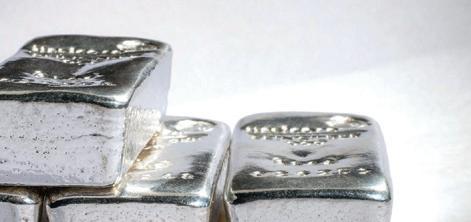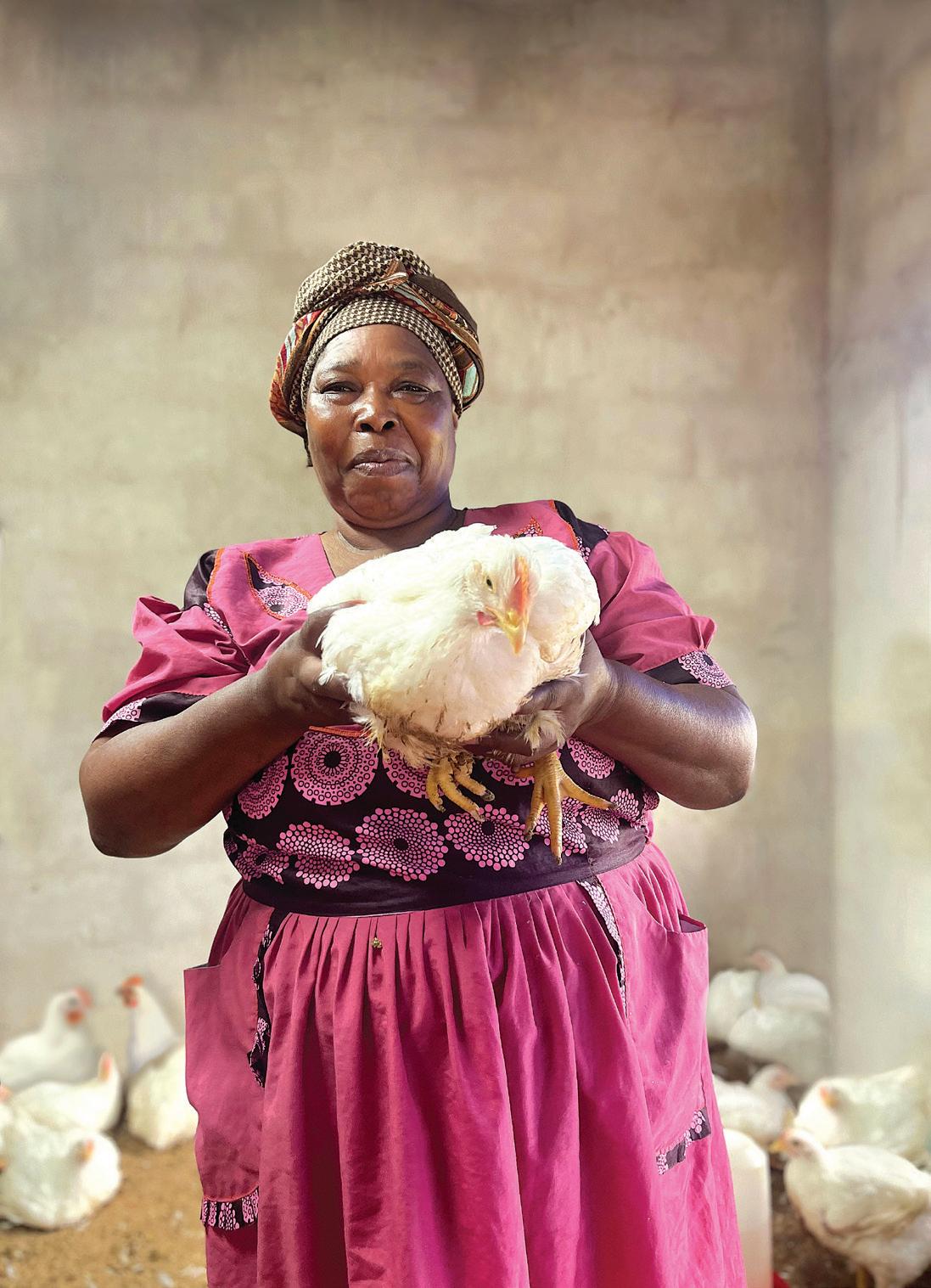

MININGTHE YEARBOOK
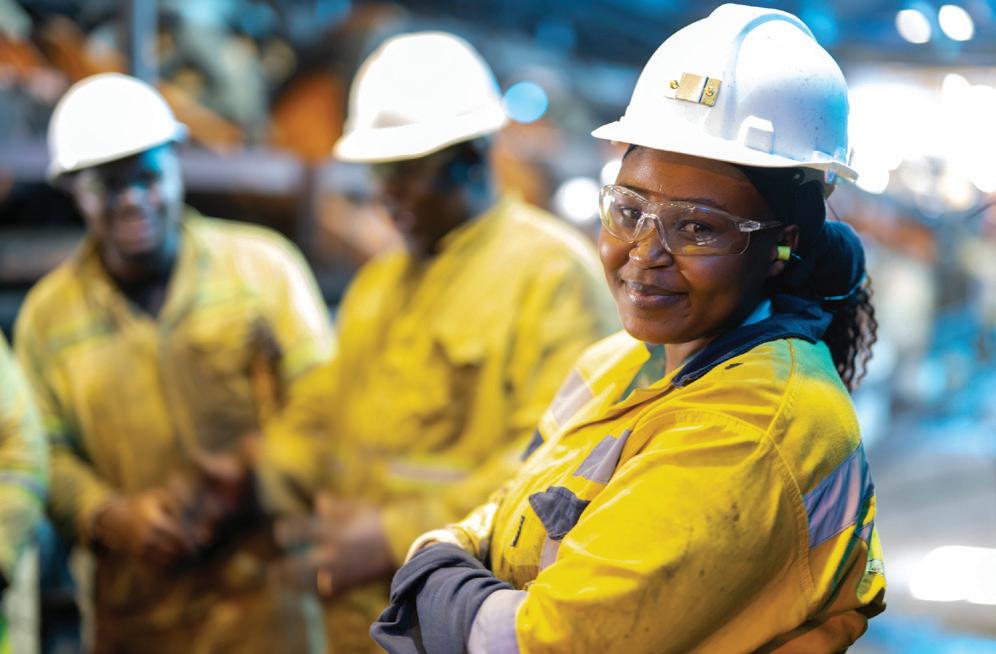
Progress. Together.
www.glencore.com/south-africa
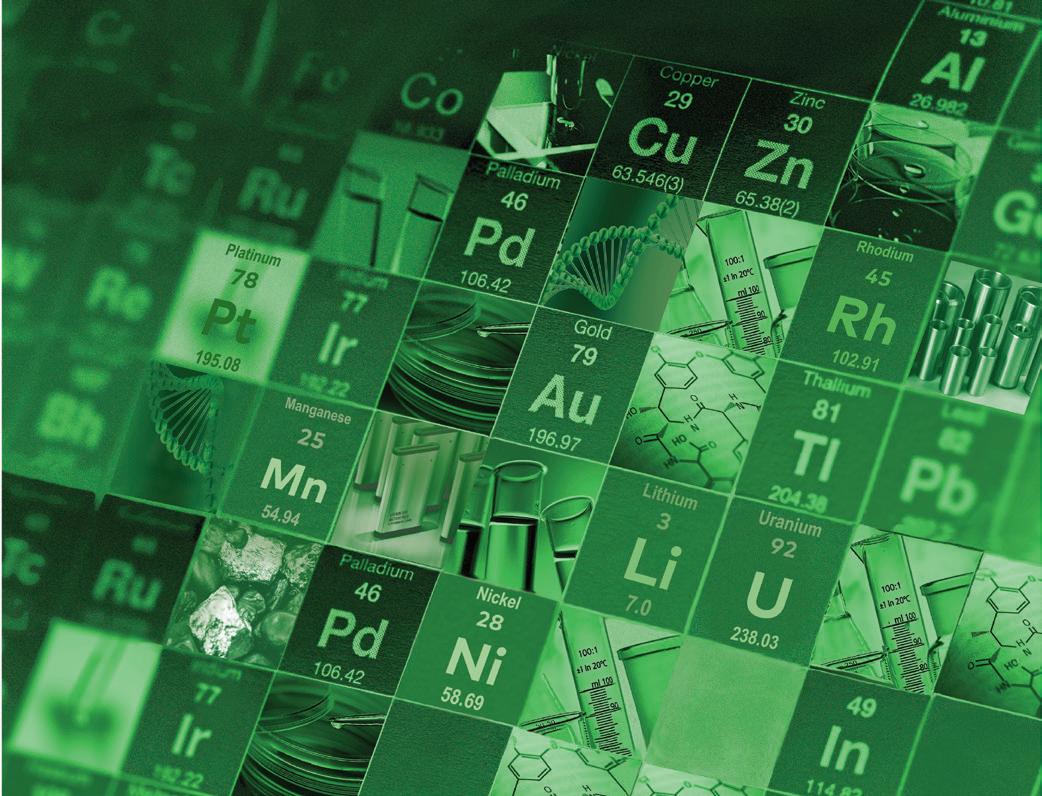
Can SA mining halt 20 years of decline?
Saudi’s rise in mining is breathtaking, and problematic
Why some gold companies are turning their backs on M&A
‘I tend to run towards danger’
Has Resolute finally turned the corner?
Banking on Bankan
Mining’s big permitting problem
Thungela weighing options in Australia
Gold Fields’ chinchilla conundrum: What a long strange trip it’s been
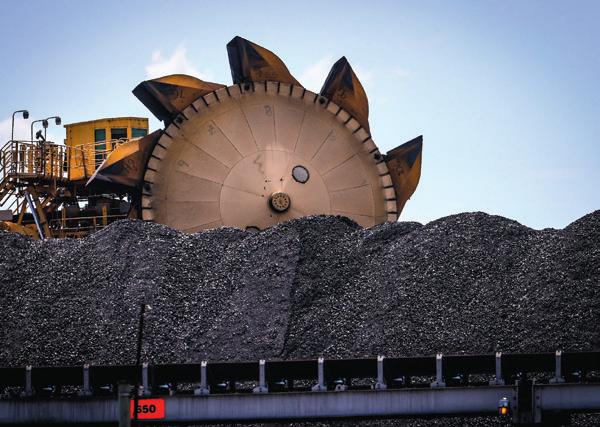
South Africa’s illegal gold mining is surging
This ‘ole (mining) house
Spurned by Anglo, what does BHP do next?
This JSE company is reinventing the mining house
Madagascar’s long-stalled Toliara Project forms centrepiece of merger
All systems go for Arc’s Zambia copper JV with Anglo
Northern Cape copper is rising again
Have PGM miners done enough to revive prices?
Anglo to persist with hydrogen experiment
Out of the spotlight Trans Hex stages a surprising comeback


Critical metals on the march again
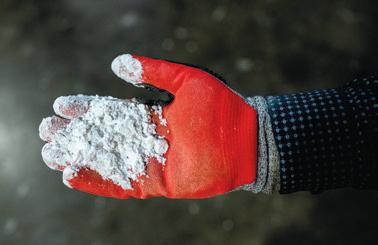
MINING THE YEARBOOK
EDITORIAL

Editor:
David McKay
Writers:
Liesl Peyper
Charlotte Mathews
Brendan Ryan
Ed Stoddard
Marc Hasenfuss
Kristie Batten
Giulietta Talevi
David McKay
Pictures:
Gallo Images
Design & Layout:
Colleen Wilson
Subediting:
Yvonne Fontyn
Andrea Bryce
Printing:
Miningmx (Pty) Ltd
Email: Address PO Box 3194 Rivonia 2128 South Africa
david@miningmx.com info@miningmx.com
The Mining Yearbook is owned by Miningmx (Pty)Ltd
An online version of The Mining Yearbook 2023 will be published on www.miningmx.com www.miningmx.com
Typo Colour Printing Specialists
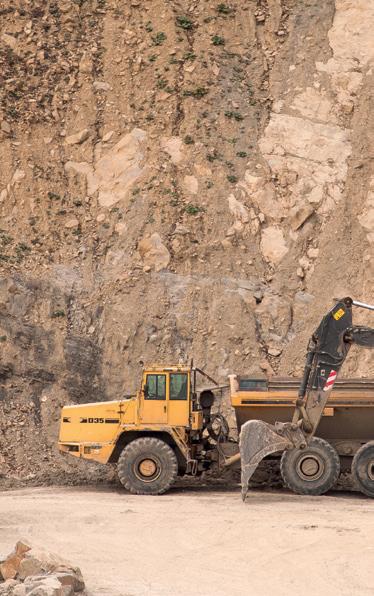

Can SA mining halt 20 years of decline?
After a lacklustre performance of more than 15 years, South Africa’s economy could finally be on an upward trajectory on the back of a new centrist government of national unity with more market-friendly policies and undertakings to embrace growth-enhancing policies, writes LIESL PEYPER
LIESL PEYPER
ON 29 May, South Africans headed to the polls to cast their vote in the country’s seventh democratic national and provincial elections. In the weeks leading up to the event, markets strengthened as investors were confident the ruling ANC would get close to 45% of voter support that would ensure policy continuity and limit the risk of a coalition with some of the more populist parties.
Voter turnout on election day was at an all-time low at just over 57% – a sure indication of the nation’s disenchantment with the ANC’s performance over the past 30 years. In the final results, the ANC, which won 57.6% of votes in 2019, plummeted to just over 40% in 2024. This compelled the ruling party to partner with opposition parties across the political spectrum to form a government of national unity (GNU), which is expected to govern the country for the next five years. Ten political parties have now signed the so-called statement of intent to participate in the GNU.

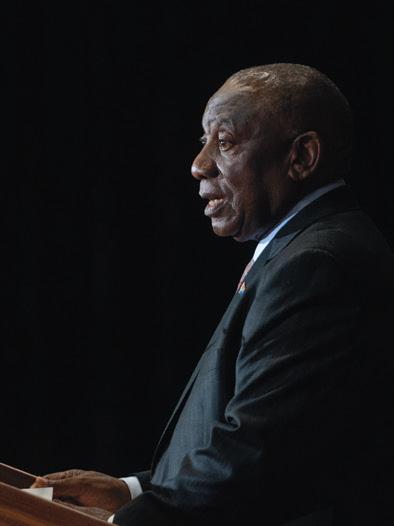
The cooperation agreement saw President Cyril Ramaphosa being re-elected as head of state for another five years.
Markets initially received the news positively, causing what analysts call a “relief rally” in the rand and the Johannesburg Stock Exchange (JSE). It was especially the willingness of the Democratic Alliance (DA), the country’s biggest opposition party with its perceived market-friendly policies, to be part of the GNU that has appeased investors.
Prof Pieter Duvenage, an independent political analyst, says South Africa has now shifted from one-party dominance to a multi-party system which he believes will require compromises – especially from the ruling party which had a monopoly on policymaking. “The ANC will now have to take the views of all parties into account. This will also work in favour of the mining sector where the ANC’s socialist stance of ‘disassembling the industry and building it up again’ will no longer go unchallenged.”
Cyril Ramaphosa, at swearing in of the National Executive

One of the pillars of the GNU is that participating political parties had to sign a so-called statement of intent that they would work together to pursue the GNU’s objectives. There will also be a consultative council where contentious policy will be ironed out.
Hermann Pretorius, an analyst at the SA Institute of Race Relations (IRR), is less enthusiastic about the GNU’s chances of success. He is especially disappointed at the DA’s decision to become part of the national government. “It was irresponsible. The DA’s political fate would now be interwoven with that of the ANC, and they will be painted with the same brush.”
Pretorius believes the DA should have entered into a so-called supply and confidence agreement, voting “with” the ANC on the election of the president and the national budget but remaining the official opposition responsible for oversight and ensuring accountability. George Cheveley, portfolio manager and metals and mining specialist at asset manager Ninety One, views the election results as generally positive as long as the different parties can work together. “There is good evidence though that these types of government can work.”
Ramaphosa’s new Cabinet saw the return of Enoch Godongwana as Finance Minister, Kgosientsho Ramokgopa as Minister of Electricity and Energy, and Gwede Man-
tashe as Minister of Mineral and Petroleum Resources. The reconfiguration of Ramokgopa’s department – to include energy –was welcomed by industry and investors, especially since he will now be responsible for policymaking and shareholding at South Africa’s state-owned energy company Eskom. Under the previous administration, Eskom was “split” across three ministries –Public Enterprises, Mineral Resources and Energy, and Electricity; this has often led to policy paralysis. Mantashe’s reappointment to the Cabinet was hardly surprising given his influence in the ANC’s national executive council and the support he has given to Ramaphosa in the past five years, says Duvenage.
With the new Cabinet in place, the next hurdle for the GNU will be to agree on a policy agenda and action programme. Before the election, and during the negotiations to form a new government, there was widespread concern that the reform agenda started under Ramaphosa would derail.
REFORM PROGRESS TO DATE
In the first three months of 2023, South Africa’s economy was on the brink of collapse with load shedding an almost daily occurrence and the logistics network logjammed to such an extent that it cost the mining industry billions of rand in lost exports. This has led to the formation of the Joint Steering Oversight Committee, an initiative for which more than 150 CEOs
from the private sector signed up, and which focuses on the most urgent areas plaguing the economy – energy, transport and logistics, and crime and corruption.
More than 300 specialists from the private sector have been deployed to power stations, Transnet and various crime-fighting initiatives. This heralded new collaboration between the government and the private sector and has helped to pull back the South African economy from the brink of collapse.
Mzila Mthenjane, CEO of the Minerals Council South Africa, says the business sector, including CEOs of mining companies, has participated “unconditionally” in helping to fix key elements of the economy. “This cooperation has led to the successes we’ve seen so far. And although it’s still early days, it’s encouraging.”
The early wins are already evident. At the beginning of July, South Africa had more than 100 days of no blackouts – a rare feat considering the severity of outages during 2022 and 2023. Although Eskom’s management has warned that blackouts are not entirely a thing of the past, it is unlikely to reach the same levels seen in the past two years.
“There is progress at Transnet too, and encouragingly, its current leadership is aligned with government policy to boost private-sector participation,” says Izak Odendaal, an investment strategist at Old Mutual Wealth.
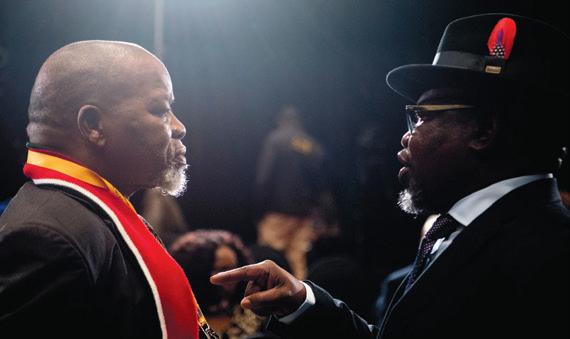
Enoch Godongwana, right, talking to Gwede Mantashe
IT’S IN THE IMPLEMENTATION
Ann Bernstein, executive director at the Centre for Development and Enterprise, says the new government, on paper, believes in constitutionalism, the rule of law and an increased role for the market in growing the economy and creating jobs. “This is a development with enormous potential.”
But leadership and political maturity are crucial to keeping the GNU intact, and “crucially, to agree on a set of urgent priorities that deal with the most pressing challenges”, she adds. The IRR’s Pretorius points out that political leadership change is but one aspect of reform. Many civil servants in government, which are the implementers of policy, are ANC cadres who have not been appointed on merit. “This means new policies determined at the Cabinet level could come down to nothing if the implementation mechanisms fall short.”
Casey Sprake and Marco de Matos, both analysts at Anchor Capital, write in a joint company note that it’s still too early to draw any feasible conclusions about how effective the new executive will be. “However, it is in a stronger position to guide South Africa’s reform course than in many years.”
MANTASHE, THE SEQUEL
The reappointment of Mantashe as Minister of Mineral Resources and Energy has elicited mixed reactions, however. Mantashe took the reins of the mining portfolio in 2018 on a wave of optimism. Markets were buoyed by a Ramaphosa Presidency, with expectations that it would herald an era of economic growth following former president Jacob Zuma’s “nine wasted years” of corruption and incompetence.
But five years down the line the mining industry continues to stumble along. South Africa’s exploration failed to improve, despite Mantashe’s promises that it would reach 5% as a share of global exploration – a level last seen in 2003. It has since dropped to under 1% and has stayed there for the past decade.
His reappointment to the portfolio – with petroleum resources as an added function – is seen as “continuity” by the Minerals Council South Africa, which said that it allowed it to “persevere and elevate engagements” for a modern, investment-friendly mining industry.
‘The DA’s political fate would now be interwoven with that of the ANC, and they will be painted with the same brush’ – Hermann Pretorius, an analyst at the SA Institute of Race Relations
the new cadastral system should get under way and the industry hopes it will speed up the processing of applications.
Mthenjane is optimistic that a fully functional cadastre will undoubtedly lead to more exploration funding coming into South Africa. “It will remove conflicts in terms of the issuance of mining rights and what is available for exploration and create an environment of transparency with little contestation.”
The IRR’s Pretorius believes the mining portfolio should have been headed by an independent expert. “Economically, mining is critical to the economy, and it has the capacity and potential to drive massive job creation and attract investment.
“This sector has suffered extensive and unnecessary damage from decisions driven by political rather than rational considerations. Rolling back these policy failures would be a golden opportunity for economic recovery,” he says. Under a Mantashe ministry the backlog in mining and prospecting rights, and mining permit applications and renewals, hit a record high.
At a mining conference in Johannesburg in May, the then Department of Mineral Resources and Energy said progress had been made in processing the backlog in applications in the financial year ending March 2024. However, the speed at which processing is done is not sufficient to keep up with the influx of new submissions.
The extent of the backlog is unclear, but it has previously been estimated to be more than 3,000 prospecting and mining rights with a potential investment value of over R30bn, according to the Minerals Council.
After years of inertia, which significantly delayed the implementation of a new mining licencing system – known as a cadastre – the department announced in January the appointment of the PGM Consortium to design, implement, and maintain the new mining cadastre. However, it took another five months for the department to finalise the service level agreement with the appointed service providers.
With the agreement now in place, work on
Wilhelm Hertzog, portfolio manager at Rozendal Partners, cautions that the implementation of any IT system, including the cadastre, will take time. “It could be riddled with niggles. Even private-sector companies struggle with implementation, so it won’t necessarily be easier for the government to do it.”
The implementation of a mining cadastral system will therefore be no quick fix to the structural issues affecting the mining sector.
“Any change, or improvement, will take time to implement. Don’t get swept away in euphoria about any positive developments in the immediate future. And don’t be under any illusions – the mining industry won’t become an attractive option overnight.”
Irrespective of who the new mines minister is, implementation problems will persist, says Hertzog, due to entrenched and vested interests, and bureaucracy. “The bigger issue is to make the entire civil service more efficient, and for that, you need skills development among civil servants.”

Mzila Mthenjane, CEO, Minerals Council
SA mining legislation needs fine-tuning
IN July 2023, the Department of Mineral Resources (DMRE), trade unions, and industry stakeholders met to discuss South Africa’s principal mining legislation, the Mineral and Petroleum Resources Development Act (MPRDA), and possible future amendments.
Although no concrete decisions about legislative reform were taken at the time, the sentiment is that certain provisions of the MPRDA are vague, which may result in inconsistent application and misalignment with other pieces of mining industry legislation.
Lili Nupen, founder of the law firm NSDV and director of mining and environmental law, argues that the MPRDA is a sound piece of legislation, although it needs “tweaks” to keep abreast of developments in the modern mining world. In her view, one of the amendments required is to reincorporate the notion of “associated minerals” into the Act.
Under the former Minerals Act (which was replaced by the MPRDA) a mining right holder could automatically mine an associated mineral when extracting the principal mineral for which an application was lodged. “If a company had rights to mine platinum group metals (PGMs), for example, it would automatically have the rights to mine chrome by virtue of it being an associated mineral, as it’s in the same ore body, so you cannot mine PGMs without bringing the chrome out as well.”
The MPRDA however is very specific, says Nupen. “If you mine for PGMs you get rights to PGMs alone. So, a company would either need to get its mining right amended to make sure nobody else gets the right to the associated mineral, or it would need to come to a cooperation agreement where two different companies each have a right to the two different minerals.”
This particular shortcoming in the MPRDA has led to so-called over-pegging where two or more operators would get rights to mine different minerals on one single site. Ideally, the MPRDA should be
amended so that exploration and mining rights are automatically granted to all the available minerals on a particular site.
Nupen also believes there should be a renewed commitment to implement properly the One Environmental System (OES).
Introduced at the end of 2014, the system was envisaged to streamline decision-making, environmental authorisations and the issuance of water licences for mining operators and bring about coordination among the departments that deal with mining, environmental affairs and water, respectively. “The last phase of the collaborative agreement was never implemented though and now you have three departments working in silos,” Nupen says.
Under the OES, the various application processes for mining, environmental authorisation and water licences are supposed to run concurrently with much shorter turnaround times.
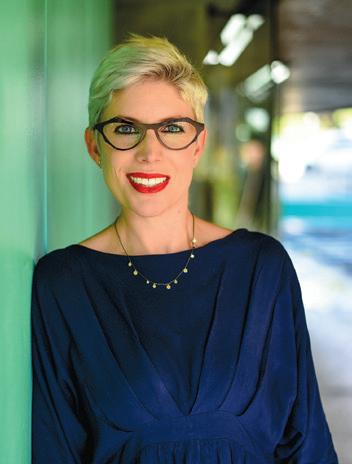
Mthenjane agrees that there should be much better coordination among the various government departments that impact mining. “Like the Departments of Agriculture and Cooperative Governance when it comes to the use of land. There must also be clear policies and guidelines around community engagement and participation.”
Another legislative change Nupen advocates is the “deeming position” concerning the licence application process for mining or exploration. “Botswana for example has a ‘deeming position’ – if an applicant’s prospecting right is not approved within 90 business days and it has ticked all the regulatory boxes, then it is deemed to have been approved and the company can put a spade in the ground.”
She acknowledges that in South Africa, where fraud and capacity constraints
are glaring issues, the necessary checks and balances need to be in place. “But it’s worked in our neighbouring countries and given that timing and processing are some of our biggest problems it could be a welcome solution.”
Ian Woodley, mining analyst at Old Mutual Investment Group, is of the view that there is still too much uncertainty in South Africa’s policy environment. “If I were an exploration player who had thought about South Africa, I would probably step back because of the uncertainty. You wouldn’t know what is going to happen from this past election to the next and what the rules will be in the next 15 to 25 years.”
Explorers need policy stability because of the vast amounts of capital that is involved. “There are people with a very good project and fantastic risk tolerance, but the majority would want to go somewhere else where there is more certainty,” he says.
Lili Nupen, Founder of law firm NSDV

Saudi’s rise in mining is breathtaking, and problematic
Saudi Arabia has established itself as a new sovereign power in world mining. While this will be welcomed in South Africa, which has warm relations with the kingdom, it nonetheless poses human rights challenges for the country’s mining firms, writes ED STODDARD
ED STODDARD
LONG the world’s largest producer of oil, Saudi Arabia now seeks to unlock a treasure trove of minerals beneath its sands while using the endowment generated by decades of hydrocarbon revenue to invest in mining elsewhere, notably Africa.
This has the potential to dramatically raise the kingdom’s geopolitical and economic stature on the world stage at a time when the importance of oil is fading in the face of the green energy transition.
The minerals push is part of the kingdom’s ‘Vision 2030’ to diversify an economy
welded to oil, a state of affairs that has stifled investment and development on other fronts. This coincides with a liberalisation drive under Crown Prince Mohammed bin Salman that has softened some of the harder edges of an austere and ultra-conservative brand of Islam.
“Saudi Arabia is reinvesting oil rents into critical minerals mining and processing as a means to diversify away from over-reliance on hydrocarbons and a need to future-proof its economic future,” Christopher Vandome, a senior research fellow at international affairs think tank Chatham
House, told MiningMX.
“Saudi sees itself as being at the centre of a mining super-region straddling Africa, the Gulf, Middle East and Asia. And it has been highly strategic in building partnerships that straddle wider geopolitical divides – courting the USA, Russia, and African states.”
Diverted by a decades-long focus on oil –a classic case of what development economists call the ‘resource curse’ or ‘oil curse’ – Saudi’s mineral potential has remained untapped.
But it is widely regarded to be immense,
triggering a new resource scramble in the kingdom. Saudi Arabia estimates its undiscovered mineral potential to be worth a staggering $2.5-trillion – 40% bigger than its current gross domestic product.
“Exploration projects over the past two decades have unearthed extensive deposits of precious and industrial minerals throughout the country. These include not only gold and silver, but also copper, tin, tungsten, nickel, chrome, zinc, lead, phosphates, iron ore, bauxite, potassium ore and even table salt,” the Saudi embassy in Washington DC proclaims on its website (https://www. saudiembassy.net/minerals-and-mining).
After decades spent churning out the fossil fuels linked to anthropogenic climate change, this places Saudi at the coalface of global decarbonisation efforts.
And it is actively seeking foreign investors in the mining space, using its accumulated oil wealth to offer funding for greenfield exploration.
“The mineral endowment is tremendous. There is a lot of activity, the government is making it very easy to apply and to facilitate. Saudi is the only place on earth that I am aware of that you get grant funding for greenfield exploration. They really want to aggressively develop the exploration because they know it takes a bit of time to get to a
mine,” said Tim Keating, a mining investment consultant based in the Middle East.
This activity is transparently displayed on the kingdom’s National Geological Database Portal, also known as a cadastre (https:// ngdp.sgs.gov.sa/ngp/).
Saudi Arabia, through its state-owned mining company, Ma’aden, also plans to explore on the Red Sea floor for minerals for commercial exploitation.
ESG AND HUMAN RIGHTS
Such activities in an ecologically sensitive marine area will place them in the cross hairs of conservationists, and this is hardly the only concern about mining and the kingdom from an ESG (environmental, social and governance) perspective.
Saudi Arabia has liberalised but remains an authoritarian state. Finally allowing women to have more freedom of movement and drive a car is hardly progressive in the 21st century.
“Mining companies and investors in the sector should be concerned by the well-documented, egregious and wide-ranging rights abuses recorded against nationals, Indigenous Peoples and other minorities and migrant workers in Saudi Arabia,” Michael Clements, director for International Programmes at the Business & Human Rights
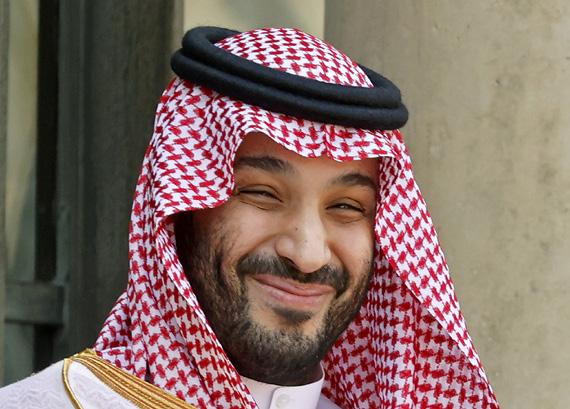
‘Saudi Arabia is reinvesting oil rents into critical minerals mining and processing as a means to diversify away from over-reliance on hydrocarbons and a need to future-proof its economic future’
–
Christopher Vandome, Chatham House
Resource Centre, told MiningMX.
“Although the Kingdom has presented an appearance of openness to international media, culture, sport and politicians in recent years to attract investment, the country remains a near black box of information.
“There is an alarming lack of transparency on rights violations happening on the ground – owing to severe restrictions on civil society and media freedoms – as well as on the business relationships and agreements being maintained. This should raise serious red flags – particularly for a sector like mining, where abuse is endemic.”
The centre says its data show that Saudi Arabia is one of the worst 10 countries in the world for abuse against migrant workers.
In an age when ESGs have risen to the top of the corporate agenda, such issues will not escape investor scrutiny and are on the radar screen.
Frank Hallam, CEO of Vancouver-based Platinum Group Metals (PTM), which is studying the establishment of a standalone PGM smelter and base metals refinery in Saudi Arabia, said the company initially had ESG reservations about doing business in the country.
The background here includes a freezing of diplomatic relations between Canada and Saudi Arabia for five years between 2018 and 2023 over Ottawa’s criticism of the kingdom’s human rights record.
Hallam said the perceptions were that “... investors in the West, in North America in particular, would be somewhat hesitant or
Crown Prince Mohammed bin Salman
even put off about the concept of investing in or with Saudi Arabia. There was the question of human rights, the question of women’s rights, and some of the tensions between Canada and Saudi Arabia.”
But Ottawa and Riyadh patched things up last year, a diplomatic thaw that makes it easier for Canadian capital to flow to Saudi Arabia.
“The government of Canada’s view is what is in the past is in the past and the current Saudi government is moving in the right direction and they see rights and freedoms improving and they would rather do business with them and look forward,” Hallam said.
“We had our first visit to Saudi Arabia in 2023, and immediately upon arriving we were surprised about the nature of society there, it was much more open and vibrant than we had anticipated. People moved about and were busy and doing their work, women were in the workplace and out and about, some were in traditional dress and some weren’t. No one seemed too fussed one way or the other.”
POLITICAL TAP DANCE
While the Canadian-Saudi dust-up is receding in the rear-view mirror, PTM must
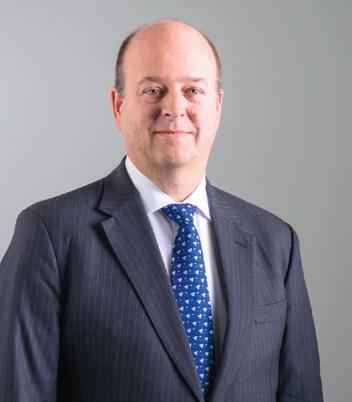

navigate the shifting sands of the South African state, which recently ushered in a government of national unity after the ruling African National Congress (ANC) saw its share of the vote in a national election fall 17 percentage points to 40%.
The processing facilities that PTM is aiming to build in Saudi Arabia will be to process PGM concentrate from South Africa, where the Canadian company has a platinum project in the Waterberg region. The fate of that project in part hinges on the Saudi project.
“We are seeking a permit from South Africa to export PGM concentrate from South Africa, so that is a fundamental hurdle to overcome in order to be able to send material to Saudi Arabia. And the stance of the South African government is that their preference is for beneficiation in country, that’s logical. The question becomes whether there is capacity for Waterberg,” Hallam said.
South Africa for years has been plagued by chronic power shortages as state-run power utility Eskom, which has serious solvency issues, struggles to keep its ageing fleet of coal-fired power stations running in a reliable way.
The power situation has improved markedly in 2024, not least because of a rush by businesses and households to install solar,
but investor perceptions remain sour in this regard.
“If you were going to build your own smelter in South Africa, which we’ve looked at, the demand on power would be something you would need to consider. And we believe it would be manageable and would succeed. However, when we speak to investors about the concept, they’re initially excited and then say ‘what about the power?’ That’s a perception that’s hard to answer,” Hallam said.
This also points to possible commercial friction between South Africa and Saudi Arabia as both are keen to ‘beneficiate’ or process minerals on their own soil to add value.
“While Saudi Arabia’s main objective is for increased domestic processing, they have also been supporting of infrastructure projects in Africa and have begun discussions on investing in processing capacity on the continent. In this area, Saudi will feel that it has the financial resources to move quickly and put money into projects faster than the EU, US, UK or other international partners looking to secure minerals. Saudi sees a competitive advantage and an opportunity to be a major player and alternative to China for mineral sourcing. In so doing, Saudi may become a proxy for the US in Africa,” Chatham House’s Vandome said.
Frank Hallam, CEO, Platinum Group Metals
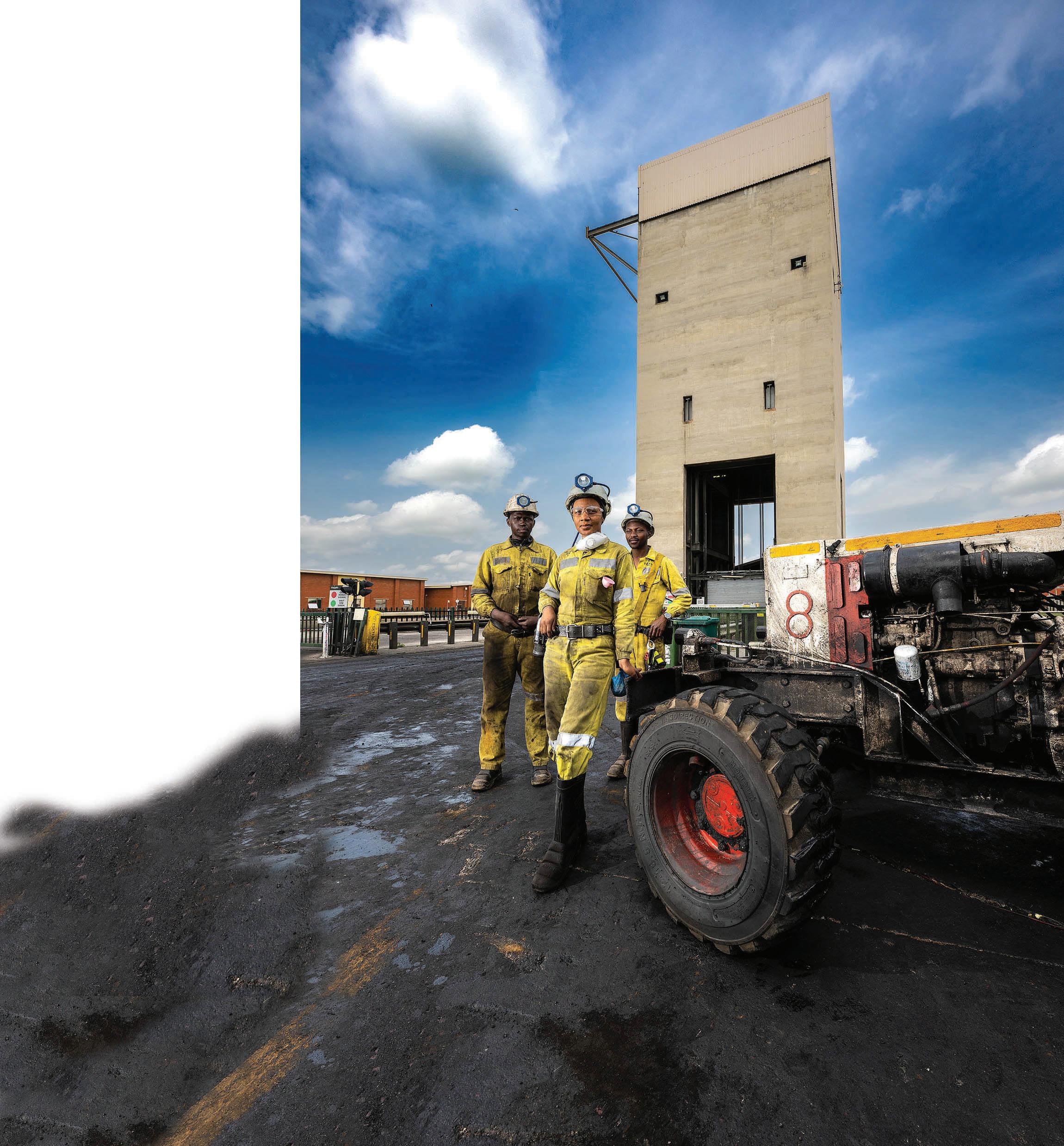
AWhy some gold companies are turning their backs on M&A
Gold resources continue to be the target of merger and acquisition activity as the gold price consolidates above $2,000 per ounce. But two companies are sticking to the mantra that size for its own sake is a strategic mistake, writes
SKED at the recent London Indaba conference to explain why he opted to become a non-executive after 12 years at Barrick Gold, chairperson John Thornton replied: “What does executive mean when Mark Bristow is the CEO?”
That’s some compliment from Thornton, a former co-president of Goldman Sachs and director of the iconic $50bn automaker Ford Motor Co. But it’s also no surprise. Thornton is 70, and holds four other directorships, including one on Chinese technology company Lenovo Group’s board.
More importantly, Barrick has been transformed into a typical Bristow company, which is to say, very like Randgold Resources – the firm Bristow founded in 1994, and
the only other public business he has run.
Gold production last year hit its lowest level since 2000 as its focus falls on margin over ounces. And despite kicking the tyres at a number of gold and copper companies, the company has steadfastly kept away from mergers and acquisitions. Other Bristow features are the dismantling of the head office, and – as a consequence of the paucity in dealmaking – an increase in brownfields exploration.
Finally, as with Randgold Resources, Bristow has a near-ubiquity in the organisation. “He [Bristow] goes from mine to mine to mine all year long. That’s extremely valuable,” said Thornton, who likened Bristow’s work ethic to that of leaders he’d read about, such as Margaret Thatcher, the
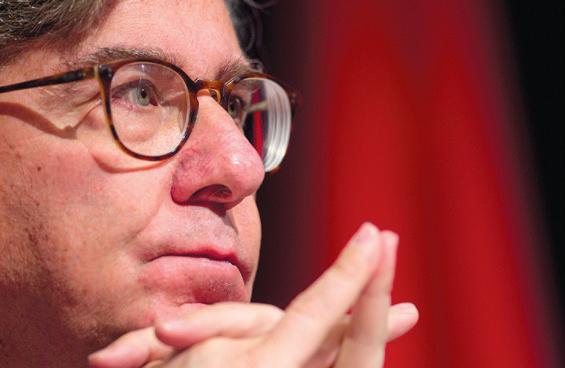
DAVID MCKAY
former UK prime minister who got by on four hours’ sleep nightly.
Bristow spends a major part of each year visiting Barrick’s sites. A typical schedule starts in Central and West Africa before heading to Saudi Arabia, Pakistan, then on to Papua New Guinea, eventually landing in the Dominican Republic ahead of the American leg of his quarterly tour. Mine management at each site know better than to turn up less than 100% prepared. “Bristow knows more than they do,” said Thornton.
It was this obsession with operational rigour that earned Bristow accolades at Randgold, eventually lining it up as the best merger partner with Barrick. Prior to the merger, Thornton says he ran Barrick in a partnership he knew at Goldman Sachs. “The top 10 to 15 people would meet once a week; we would discuss every important topic and reach a consensus, make a decision, and then go,” he said. It was a way “to learn the business”, but Thornton said it was also a holding pattern. “I knew that sooner or later I had to merge Barrick with a company with the best CEO in the industry,” he said.
‘We have insisted on getting into the weeds and that has been a mistake’
– John Thornton, nonexecutive chairman, Barrick Gold
DAVID MCKAY
Gold remains one of the best performing assets of 2024
Six years later, with Bristow at 65, there’s been some talk of succession, but nothing definite about his passing on the baton. Speaking from Kinshasa where he’s on a site visit to Barrick’s giant Kabila gold mine (of course), Bristow sounds far from contemplating the prospect of weekly rounds of golf, or taking up a hobby. Instead, he launches into a characteristic broadside of gold industry problems. Expensive M&A is his absolute bugbear.
“You’ve got a whole pile of M&A,” he says. “This rising gold price makes some transactions look okay – some of them – but betting on bigger for its own sake is not a good strategy, especially in mining.”
Top of the list is BHP’s takeover proposal for Anglo American, which he says is “a headscratcher”. Why would a miner prized for bulk mining in “safe jurisdictions” consider bidding for a firm with “a different risk portfolio ... without knowing how”, asks Bristow. Well, copper is the answer – a mineral to which Barrick itself has been long connected.
In fact, Barrick was linked with a rival offer for Anglo – speculation that Bristow instantly quashed. As a geologist, Bristow is predisposed to building mines rather than buying them. Lumwana, a copper mine in Zambia for which Barrick infamously broke the bank prior to Bristow’s time, in 2011, is being scaled up into a tier-one asset after years of middling to poor performance. Another copper yielding asset, the $7bn Reko Diq project in western Pakistan, is being developed after 30 years of delays, most of them as a Barrick prospect.
Bristow admitted to having talks in 2020 with US company Freeport-McMoRan
SOURCE: Bloomberg, ICE Benchmark Administration, World Gold Council
about a deal for Grasberg, a giant Indonesian copper mine. But the transaction didn’t get beyond the concept stage. Whisper it, but that may have been a mistake. Freeport is capitalised at $71bn today compared to $10bn when Bristow was eyeing it. Interestingly, Thornton seems to allude to a number of missed opportunities in M&A. Barrick had been slow to buy companies, he said. “We have insisted on getting into the weeds and that has been a mistake.”
Bristow’s view however is that the market will have no choice but to recognise the value of its resource development, over time. Randgold saw its price to NAV double overnight (to 2x) after developing Tongon and Kibali – now the flagship assets in Barrick’s African portfolio. Reko Diq and Lumwana will fulfil a similar function, says Bristow.
BURNT FINGERS
Research by ratings agency S&P found that of 47 deals fitting its criteria last year, 30 were in gold. Of a total deal value of $26.4bn, $22bn were in gold, although the
data has a caveat. Newmont’s takeover of Australian producer Newcrest was, at $17bn, the largest ever in the world’s gold industry.
Some 223 million ounces of gold in reserves and resources exchanged hands last year at a time when the gold price soared to record highs, and appears to have consolidated above $2,000 per ounce.
At face value, the market appears to be incentivising supply (though commentators argue against this).
It was in this context that Gold Fields sought the takeover of Yamana Gold, a Canadian firm, that would have propelled production to at least 3.2 million oz/year from peak output of 2.7m/oz in about 2027. Unfortunately for Gold Fields’ then CEO Chris Griffith, the South Africans were outbid. It’s questionable whether Gold Fields’ shareholders would have supported the deal in any case.
Today, Gold Fields is in a battle to reach this year’s adjusted gold production guidance of 2.2 and 2.3 million oz after a series of damaging ramp-up delays at its Salares Norte mine in Peru. But CEO Mike Fraser rejects the suggestion that the company missed an opportunity with Yamana. He seems to take a similar position to Bristow on M&A.
“The way we see the world, Yamana would have been a good addition, but it would have been really very expensive,” says Fraser in an interview. “For many of our shareholders, the horizon on which we see a return would have been quite distant into the future.” Fraser thinks investors would be served better by profit-making even if it’s from a smaller base.
While so-called transformatory transactions are not “off the table”, Fraser thinks
Gold Fields production outlook from its current assets
Bristow reckons it will take Barrick two years to clear away “big non-operating costs ... because my absolute obsession has been to reduce liabilities. But then our costs come down rapidly,” he says. He acknowledges Barrick has been hit harder than many of its rivals because it has a greater exposure to US dollar costs, whereas others benefit from Canadian and Australian currency weakness against the US dollar. “We are growing our margins not because of that though, but because of the increase in the gold price, and the copper price,” says Bristow.
BELIEF IN HIGHER GOLD PRICES?

“smaller, more digestible deals” are the likelier for Gold Fields. At the same time, he acknowledges, Gold Fields has to maintain a certain size. “There is a relevancy number of two to three million ounces,” says Fraser. “If in that number you are number four, that’s a good place to be in. Once you drop to below two million ounces you become less relevant.”
“Certainly in gold, you don’t have to be the biggest but the best,” said Thornton. Given that Barrick’s production is exceeded by Newmont, he might well draw that conclusion. Despite this neither size nor margin currently seems to be enticing investors into North American gold shares. Gold Fields has been marked down for its operational problems; in the case of Newmont and Barrick investors are suspicious mining inflation has not been sufficiently tamed. “Valuations at current spot prices would indicate a level of market scepticism over the ability of companies to deliver expected margins at current gold prices,” says BMO Capital Markets.

Bristow, and Fraser, have the market firmly at their backs. According to Jim Rutherford, a non-executive chair of Centamin, an Egyptian gold miner, the market scarcely believes a $2,000-plus/oz gold price is a new normal. But it is, he says. “It has taken gold two decades to get through $2,000/ oz.” Bristow thinks elevated gold prices are a symptom of the world’s political and economic affairs. “It is in a bad way, the world,” he says.
There’s also a theory that Western investors are sticking by traditional economic rules, only buying gold shares when interest rates fall, whereas central banks in emerging markets such as China are buying the metal in order to de-dollarise the economy, possibly ahead of more geopolitical uncertainty.
China and India have been the bedrock of gold consumption for years, accounting for about 50% of all physical gold purchases, but now economies such as these are beginning to dominate price formation, says John Reade, chief market strategist at the World Gold Council.
China’s central bank is also the largest buyer of official sector purchasing which is now double that of 2022. “All indications
‘The way we see the world, Yamana would have been a good addition, but it would have been really very expensive’ – Mike Fraser, CEO Gold Fields
‘They don’t want to put themselves in a position where they’re more vulnerable than they need to be if they offend the West, particularly with a potential change of government in the US with, maybe, a more isolationist expression to follow’
– John Reade, World Gold Council
are that they’re going to continue at very strong levels,” says Reade. De-dollarisation is a factor in this; central banks taking longterm policy decisions are tending towards a multi-currency regime rather than a hegemonic US dollar-driven world economy.
Central banks in emerging economies are not necessarily enemies of the West, but they’re not automatic allies either. “They don’t want to put themselves in a position where they’re more vulnerable than they need to be if they offend the West, particularly with a potential change of government in the US with, maybe, a more isolationist expression to follow,” says Reade.
Says Bristow: “When you look at the world today, you have to look at the US. There are lots of ways you can describe it. I won’t say it because you’ll print it. Then you look at the right wing rising in Europe. Then you’ve got Vladimir Putin, president of Russia embracing North Korea. The world is not in a good place.”
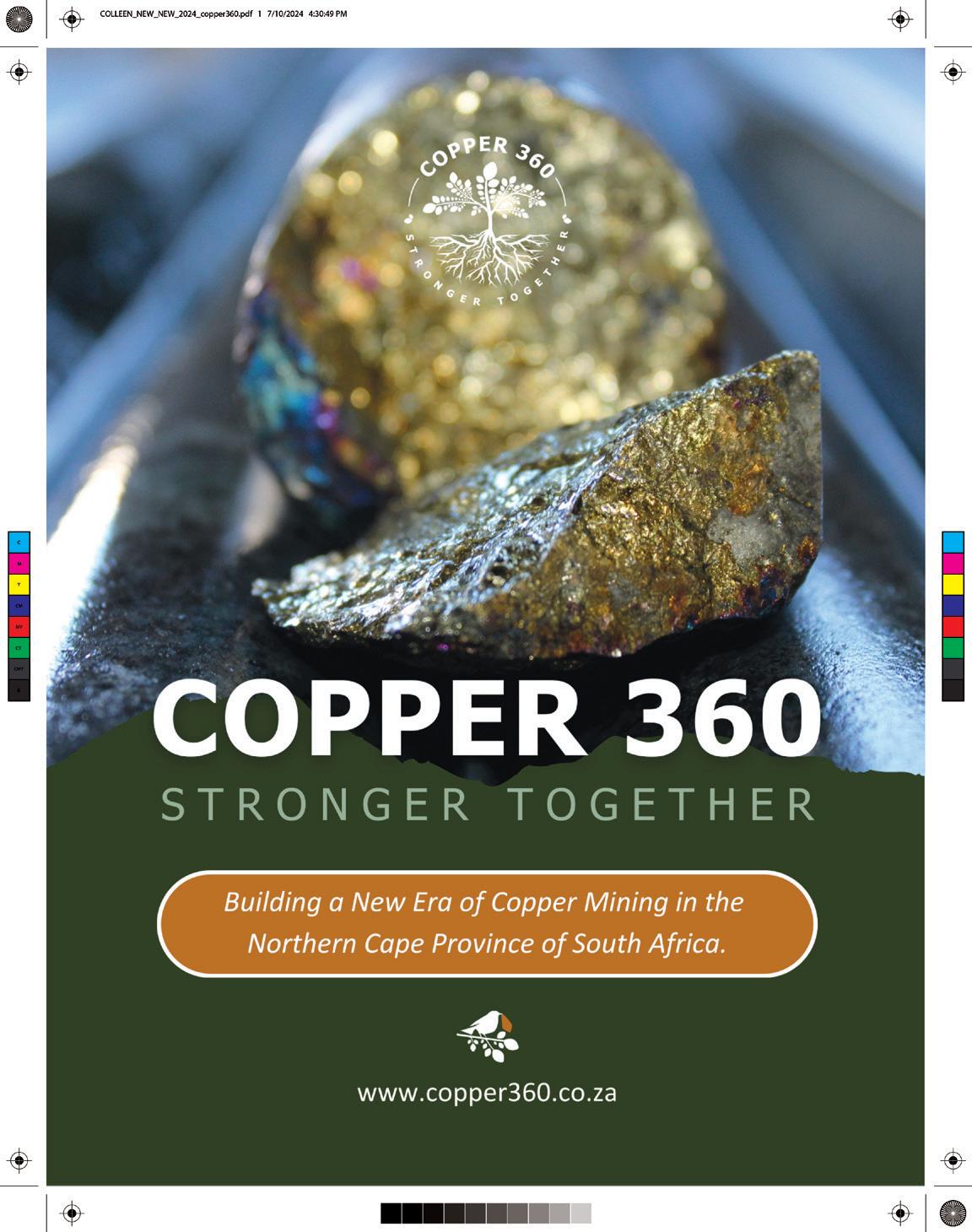
West Africa’s foment hasn’t hurt Aussie miners, yet
BY KRISTIE BATTEN
THE Sahel region of West Africa hosts many world-class mineral deposits, but it’s not for the faint-hearted. The region is home to multiple violent extremist groups. A confluence of recent developments means the situation is worsening.
The Council on Foreign Relations’ Center for Preventive Action said the region had been vulnerable to extremists since the 1960s, but current instability could be linked back to the collapse of the Libyan state in 2011. A surge of coups d’état in recent years has only made stability in the region more precarious.
Since the August 2023 death of its founder Yevgeny Prigozhin, Russia’s Wagner Group, which has had a heavy presence in the Sahel for many years, has strengthened its influence. There was uncertainty over what Prigozhin’s death would mean for the group, but if anything, it has strengthened after being absorbed by the Russian government’s Africa Corps.
The increasing Russian influence comes as Western presence and influence has weakened. Russia expanded its presence in Niger earlier this year just as US troops withdrew, while French forces left Mali in 2022 and in 2023, the Malian government dismissed MINUSMA, the UN peacekeeping force. “The continuing collapse of international counterterrorism support, as well as weakening leadership in regional efforts, has created a vacuum in which violent extremism can expand,” the Center for Preventive Action said earlier this year.
Like their North American counterparts, including Barrick Gold and B2Gold, it’s largely been business as usual for Australian miners operating in Mali and Burkina Faso. However, that doesn’t stop the market

from valuing their stock at a discount. While investors in London are reasonably comfortable with West Africa, Australians could be a “bit xenophobic”, according to Perseus Mining MD and CEO Jeff Quartermaine.
In 2021, the Australian market sat up and took notice after West African Resources built its Sanbrado gold mine in Burkina Faso on time and on budget at the height
of the COVID-19 pandemic, when border closures and associated labour shortages and cost blowouts were ravaging Australian developers.
The feat earned West African the prestigious Digger Award at Australia’s premier mining conference, Diggers & Dealers, that same year, making it the only Africa-focused company to be recognised in nearly 30 years. West African’s success since has catapulted it
into Australia’s benchmark ASX 200 index and has made investors more comfortable with Burkina Faso – despite the risks.
In a recent analyst note, Australia’s largest investment bank did not list geopolitical risk as a key risk. Macquarie describes the key risks to West African’s investment thesis as gold price volatility, variations to production, and cost assumptions and the cost and timing of its next development at Kiaka.
A slide shown by West African at its annual general meeting in May charted its share price over a three-year period against project milestones, geopolitical events and the gold price. Despite five coups d’état over that period – including two in Burkina Faso – the company’s share price has performed in line with the gold price and was trading at an all-time high in June.
MALI A CONCERN
While the security situation in West Africa has not overly been a cause for concern for Australian investors, the opposite is true for Mali’s new mining code, announced in August 2023.
Phil Russo, managing director of ASX-listed gold developer Toubani Resources, said it was the number one question he received from investors. Russo said that while the “tension” in Mali was well away from mining operations, the changing regulation was causing angst for shareholders. There had been concerns that the ruling junta in Mali would look to nationalise Western mines, but Barrick Gold CEO Mark Bristow said in May that the company had received written assurances that this would not be the case.
Speaking in late May, Russo said he believed the new mining code would be signed into law imminently, which would provide certainty and stability for the market. The new mining code allows for government participation in operations to rise from the current 10% to as high as 35%. Russo said the negative market reaction was overblown.
“I would invite investors to survey the surrounding Francophone countries and you’ll find that the interest level is very similar to what’s in the mining codes of the surrounding countries, so Mali is not being too aggressive or interventionalist,” he said.
Australian investors have been further spooked by the case of Leo Lithium, which
has been suspended from trading on the ASX since September 2023 due to a dispute with the Malian government. The company announced in May that it would sell the remaining stake in its Goulamina lithium development to partner China’s Ganfeng Lithium.
Leo said it was a reluctant seller but the decision was made due to the “increasingly challenging sovereign and security risks in-country” as well as the “expected economic impact from the adoption of the 2023 Malian Mining Code”. However, the breakdown in Leo’s relationship with the government stems from a separate dispute with ASX-listed Firefinch, which Leo was demerged from, over the Morila Gold Mine. Without referring directly to Leo, Russo said the resolution of the “company-specific issue” was a positive. “To say that the experience of one company is blanket for everyone – that is not the case,” he said.
Russo noted that despite recent uncertainty, Barrick, Allied Gold and B2Gold all had significant capital expenditure planned in Mali in the coming years. “I think the clouds will start to open up again for Mali in the very near future,” he said.
EDUCATION KEY
In May, Perseus’s Quartermaine participated in a fireside chat at the Melbourne Mining Club. Rather than talking about the company, Quartermaine spoke of the pros and cons of working in West Africa and said afterwards that he saw it as an important tool to educate investors and the broader
‘The continuing collapse of international counterterrorism support, as well as weakening leadership in regional efforts, has created a vacuum in which violent extremism can expand’ – Center for Preventive Action
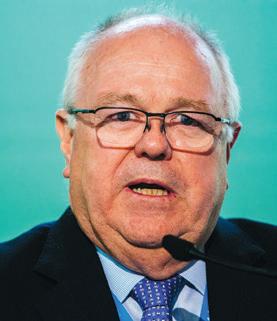
Australian mining community.
While Perseus’s mines are in Ghana and Côte d’Ivoire, investors don’t always make the distinction between West African jurisdictions.
“It is fair to say quite a lot of things occur [on the continent], and of course, it does attract media attention – clickbait’s alive and well,” Quartermaine said.
Both Perseus and West African recently took analysts and investors to West Africa to tour their respective operations.
Patrick Streater, metals and mining analyst at Perth-based financial services firm Argonaut, attended the trip. Argonaut already covered Perseus but initiated coverage of West African following the trip, allocating a speculative buy rating and a A$3.10 price target – more than double the company’s share price at the time of writing.
Streater described the political situation in Burkina Faso as “fluid” and said an investment in West African came with elevated sovereign risk. “Whether real or perceived, the market continues to discount the value of West African’s portfolio due to security concerns,” he said.
Mike Millikan, mining analyst at Perthbased brokerage Euroz Hartleys, was also on the trip and said the large country risk discount for Burkina Faso appeared to be overemphasised, with West African’s projects “located in the best part of the country”.
“We had a great trip, with no security concerns,” he said
MD and CEO, Perseus Mining
Jeff Quartermaine
‘I
tend to run towards danger’
By BRENDAN RYAN
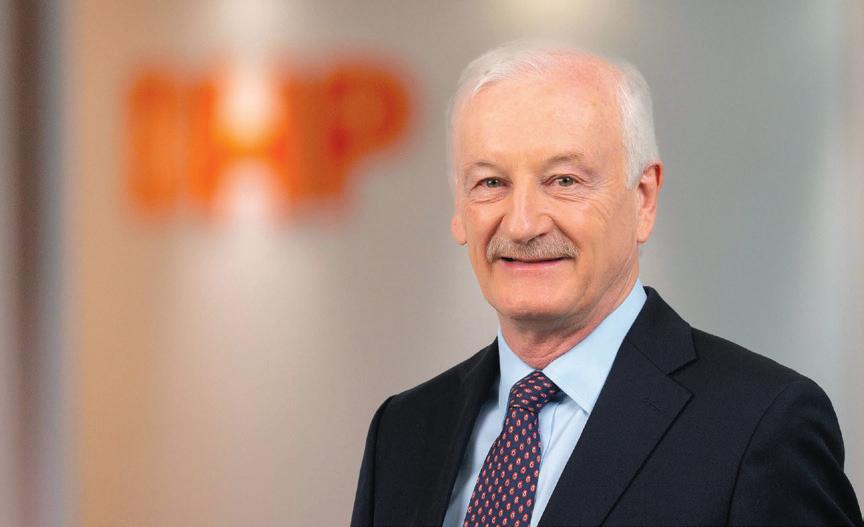
AT 69, an age when many would be looking to slow down and ease into retirement, Ian Cockerill has taken on the full-time, challenging role of running mid-tier West African gold miner Endeavour Mining. ‘Slowing down’ for a top mining executive usually means a shift to a statesman-type role taking on a few plum non-executive directorships and then spending more time on other activities.
In Cockerill’s case, this is likely to mean indulging his long-running support of conservation organisations and getting into the bush more often. And that scenario looks particularly likely when you consider the
‘In an earlier life I must have been a fireman because instead of displaying rational behaviour in situations like this and running away I tend to run towards them’
– Ian Cockerill, CEO, Endeavour Mining
list of what Cockerill has already achieved in his 50-odd-year career, starting out as a geologist with an honours degree from London University. He has little left to prove or experience.
He rapidly made his way up the ranks at De Beers and Anglo American to become GM of Anglo American’s Elandsrand gold mine and was then appointed CEO of the newly formed Gold Fields when it was created from the merger of the former GenGold with the former Gold Fields of South Africa’s gold mines. He followed that by becoming CEO of Anglo American Coal and then moved into what he terms his “portfolio career”. During that period he held key
Ian Cockerill CEO, Endeavour Mining
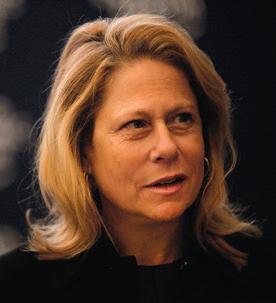
positions including the chairmanship of the BlackRock World Mining Trust. He became lead independent director of Ivanhoe Mines and a non-executive director of BHP, a role he recently relinquished.
In the process Cockerill frequently made the headlines, having fought off a hostile takeover bid from Harmony Gold while at Gold Fields. He was then unceremoniously dumped from Anglo Coal by then Anglo CEO Cynthia Carroll, who had headhunted him for the job and lured him out of Gold Fields just 20 months previously.
But Cockerill is now running a troubled gold miner, having replaced the former CEO, who was fired for what have been termed “dodgy” money transfers out of the company. What’s more, he gave up his prestigious directorship at BHP to do this and now spends his life shifting from his homes in the UK and South Africa as well as offices in London, Monaco and Abidjan, where Endeavour has its regional hub.
“A lot of people have asked me that question. In an earlier life I must have been a fireman because instead of displaying rational behaviour in situations like this and running away I tend to run towards them.
“I was deputy chairman of Endeavour where we had a normal succession plan and an emergency succession plan. Probably somewhat stupidly I had signed up for the emergency plan – not thinking, like you do with insurance, you ever need to cash it in.
“Then with Sébastian [former Endeavour CEO Sébastian de Montessus] having to go, we were in a bit of a quandary and I was asked to do it full time. My reaction was that you sign up for these jobs and you have a kind of responsibility to step up to the plate when the shit hits the fan.”
Cockerill said he guaranteed the board that he would do the job for three years but would be happy to leave sooner if they found a suitable full-time CEO to replace him. “I love working. I love mining. I love to travel and meet people. I love intellectual and professional challenges which Endeavour brings and, fundamentally, Endeavour is a very sound business which has some short-term issues.
“It was too much of an interesting challenge to walk away from and I am thoroughly enjoying what I am doing.”
SWEET SPOT
Is he up to the job at the age of 69? “That’s a fair question,” Cockerill replies.
“It was something my wife and I had to think about. My view is that a situation like this provides its own adrenalin and energy. I have always been a high-energy individual and blessed with good health and, as long as that continues, as long as I feel physically and mentally able to do it, then I will do it.
“If I feel I am not able to do it ... and, trust me, my wife will be the first one to say to me ‘Stop! Enough!’ But, after just two months in the job, she told me that she had not seen me this energised and fired up for a long, long time.”
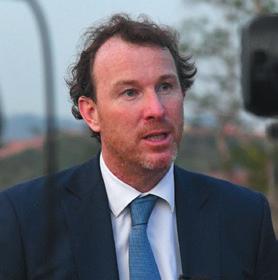
Cockerill said he saw his main task at Endeavour as making sure the group got back to its sweet spot of annual gold production of 1.5 million ounces through organic growth with continued exploration success.
“I am a hands-on manager but I see my role as being more of a guide and mentor than I was previously when running Gold Fields. I am now far more willing and able to step back and let the team get on with it while providing the occasional pat on the back and kick up the backside.”
Reflecting on some of the major developments in his career, Cockerill maintains he
‘I was disappointed to leave [Anglo] but glad not to be part of what I thought was the creation of a chaotic and illogical structure. And the rest is history. We all know what happened’ – Ian Cockerill, CEO, Endeavour Mining
made the correct decision to buy the South Deep mine when running Gold Fields, even though the mine turned into a millstone around the group’s neck for the following decade, losing money hand over fist because of constant technical problems.
“I do not regret the decision to buy that mine. It’s a great orebody but the key decision that I got wrong was that we tried desperately to continue as a producing operation. With hindsight, the correct decision should have been to stop production, complete the project properly and then take it forward.”
‘BOOTED BY CYNTHIA’
Asked about his experiences at Anglo American after leaving Gold Fields, Cockerill said he moved because he believed CEOs had a life cycle of between five to seven years. “I had been at Gold Fields for nine years. It was time to for me to re-juggle myself. The Anglo offer was a professional
Sébastian de Montessus Former CEO, Endeavour Mining
Cynthia Carroll Former CEO, Anglo American
SO WHY TAKE ON THE JOB?
challenge to see if I could move on from Gold Fields and go and play in another space.
“When I got booted by Cynthia it was as part of a major reshuffle and the whole of what I would call the strategic business unit leadership of all the Anglo divisions was basically put on the street.
“At the time I was gutted. It was disap-
pointing to be fired for doing a good job. I had taken Anglo Coal from being the third or fourth most important contributor to Anglo’s earnings to being the second most important contributor.
“I was disappointed to leave but glad not to be part of what I thought was the creation of a chaotic and illogical structure. And the rest is history. We all know what
happened,” he said.
“But these things happen. It ended up being a fantastic opportunity for me because after that I started my portfolio career.
“In the 14 years since leaving Anglo I have had some fascinating opportunities and involvements with different groups which I never would have had if I had stayed at Anglo.”
Risky business in West Africa? It’s relative
ENDEAVOUR Mining runs four mines located in three West African countries: Cote d’Ivoire, Burkina Faso and Senegal, and this is an aspect that seems to worry some Western world investors because of recent political developments in the region. These include the threat of jihadist revolutionaries moving south from the Sahel area as well as recent military coups in Mali, Burkina Faso and Guinea coupled with an apparent shift by the new regimes away from the West.
In particular there are concerns over Russian influence in West Africa.
Cockerill, like some of his peers operating in West Africa, such as B2Gold CEO Clive Johnson, plays such fears down. “Risk is very much in the eye of the beholder. You could argue quite conclusively that the risk of mining in America is very high, certainly in many
has a relatively short time period for permitting, says Cockerill. Projects can be permitted and then implemented in a much shorter time period than anywhere else in the world. The reason is that West African governments have realised that developing a gold mine in their own backyard can be lucrative. “If you understand West Africa and you have the right people and you know how to manage the risks, then the rewards certainly justify those risks.”
Turning to geopolitics, Cockerill said the history of West Africa showed a pattern of ebb and flow over time. “You had the colonial power – France – in there for a long time and then they got kicked out. The Russians came in during the 60s and 70s, then they retreated and the French came back in. Now the French are going again.
“It’s part of a natural cycle. What we are seeing is behaviour from governments that you would expect. They are looking for a bigger share of the economic pie.”
A big positive in West Africa was a recognition of the rule of law. During an illegal strike at Endeavour’s Houndé mine in Burkina Faso, Endeavour won a court decision ruling the strike illegal. “Then the actual prosecutor went out to the mine and personally handed down the judgement to the strikers. He told them that if they did not go back to work they would be fined for every hour that they did not work. Can you honestly say that would happen elsewhere?”
He added: “I am less inclined to listen to stories about working in OECD [Organisation for Economic Co-operation and Development] countries. Fine, you would expect things there to go a certain states, for a variety of reasons.
“The one thing you learn from operating in Africa is to manage volatility. You learn to make yourself resilient and to cope with unpredictability and inconsistency. If you want a quiet nine-to-five life then working anywhere in Africa can be extremely challenging, but West Africa today is the single largest gold-producing area in the world.”
It is also one of the most prospective areas in the world for gold and
West African gold production vs Rest of the World
In millions of ounces for 2022
SOURCE: World Gold Council.
West Africa includes: Burkina Faso, Cote d’Ivoire, Ghana, Mali, Senegal and Guinea. Note: Numbers are rounded.
way but probably the returns are not what they would be elsewhere.
“The issues [in West Africa] are: do you understand the level of risk?; do you understand the level of volatility?; and do you have the right people with the right mentality and attitude who can actually cope with that and work in a constructive atmosphere with government?” said Cockerill.
“I have always found if you have an open communication, you can get through.”
Has Resolute finally turned the corner?
BY DAVID MCKAY
IT’S been a slog for Terry Holohan, CEO of Resolute Mining. After twoand-a-half years of his leadership, shares in the Sydney-listed firm are only modestly higher compared to a 31% increase in the gold price.
Slim pickings for those shareholders who took their company’s name to heart and remained loyal.
They can, however, extract some comfort from Holohan, an enthusiastic miner who also seems to follow the advice of investment guru Warren Buffett which is to be unafraid of “burping at the table”. Holohan is critical of former management which has required a lot of ceaseless moil. Syama, Resolute’s flagship in Mali, was “mining in the wrong direction”, he says. Resolute’s other mine – Mako – was prepared for closure. Exploration work subsequently undertaken by Holohan’s team may have found 400,000 ounces in life extension. Given that Mako has only 18 months left of reserves, and contributes an all-in sustaining cost of $1,100-$1,200/oz compared to Syama’s $1,400-$1,500/oz, it’s critical that the Senegal mine remains in production.
A third step taken by Holohan is to finally tackle Resolute’s processing issues at Syama, sometimes with surprising results. As part of maintenance work at the mine’s roaster, Resolute rescued 22,000 oz of gold that had become trapped in bricks. “It was because that piece of equipment had been abused,” Holohan says. Meanwhile, 100,000 tons of gold-bearing slimes (grading at about 17g/t) are also to be extracted from Syama’s tailing dams. The remediation of processing equipment and the tailings project will help reduce another of Resolute’s long-standing problems which is its gold
inventory – its cash lockup, effectively.
There have been many things to fix. The firm’s headquarters were relocated from Australia to London. The bullion dividend scheme – when dividends are eventually resumed – will be dispensed with in favour of actual money, he says. Promisingly, the company posted its first net cash position in the first quarter. Net debt was once $229m. Finally, the hedge book has been removed. The opportunity losses weren’t “too bad” in the end as most of the book had been closed

prior to the $2,000-plus/oz gold price.
“We have had a lot of tough meetings with shareholders but we’ve managed to bring a lot of them online,” said Holohan in an interview in June. Perhaps his message is beginning to register because shares are 27% higher year-to-date. “We are telling everybody that significant cash flow will start from the second quarter, so people are anticipating it now.”
Crucially, Holohan is expanding Syama via a $52m refit of its processing facilities to process sulphides. He is chasing a production forecast of 345,000 to 365,000 oz (from 331,000 oz last year). If there’s one thing Resolute has consistently failed to do in the past, it’s meet its promises. Longer term, Holohan is targeting 400,000 oz/year – and even to half a million oz annually – if an drilling prospect in Guinea works out.
Resolute is also fishing for M&A. “We’ve been laughed at a few times,” Holohan says of various undisclosed pitches for assets in West Africa. “As you know the explorers are desperate for cash at the moment. They are finding it hard so we think we’re in a good position, not only to grow organically but to look at the inorganic growth as well,” he says.
Holohan joined Resolute in 2021 as its chief operating officer. He was appointed CEO about a year later. Prior to Resolute he worked in a number of company wheelhouses, many in South Africa including Gencor, Impala Platinum (once a Gencor company), and its rival Anglo American. He’s also worked with Robert Friedland at Ivanhoe Mines. After 40 years in the industry Resolute is his first as boss of a listed company. It could be a crowning achievement.
CEO, Resolute Mining Terry Holohan
Banking on Bankan
Predictive Discovery says its Guinea gold prospect looks like a tier-one mine but before digging begins, the firm has to persuade government to relax regulations that prohibit mining in a national park, writes
FARANAH, located near the Niger River in central Guinea, is a place transformed. Five months ago there was nothing to suggest it was a staging post for a 600km railway linking Simandou – a giant $20bn iron ore project in the country’s south-eastern region – with port facilities at Morebaya in the west. “When I went down to the National Park there was no sign where the railway came through,” says Andrew Pardey, CEO of Predictive Discovery. “Now it’s been cleared, the viaducts are in, you can see where the tunnels are coming through. It’s progressing at a rapid rate.”
Simandou – the world’s largest mining project – has helped settle investors amid political foment in Guinea that is not atypical of West Africa. Pardey acknowledges, however, that country politics are complex: “Everyone is trying to say I’ve got more influence or power,” he says in an interview. But Guinea’s transitional government, installed in July 2022 following a military coup a year earlier, is process driven. It can be frustrating but necessary, he says.
Pardey has reason to be positive on Guinea: General Mamady Doumbouya’s government has said it wants a new major gold mine to follow Simandou, which it approved to market yee-hawing earlier this year. “There’s only one gold resource of substance – and that’s us,” says Pardey of Bankan, a prospect in Guinea’s Siguiri Basin in the north.
A prefeasibility study has Bankan operating for 11 years, producing 292,000 ounces annually for the first seven. Total life-of-mine costs (AISC) are estimated to be $1,130/oz. Pardey says this makes Bankan a ‘tier one’ asset, the Blue Riband in mining. But he admits it’s a subjective view; the top mines in Africa are mining 500,000 oz/ year or more. Critical to Bankan is further
resource delineation.
Meanwhile, Bankan’s development has one major risk, which is whether it will get an exploitation permit. The Bankan deposit is in a prohibited zone in Guinea’s Upper Niger National Park. Independent studies commissioned by Predictive Discovery say there are no critical flora or fauna in the area. There has also been high-level government participation in preparing the environmental study. But the permitting is still a risk.
Pardey insists government participation will see regulations relaxed. There’s also comfort the government has been flexible in the past on bauxite mines and Simandou itself, which is located near a heritage site. “I feel confident that we’ll be granted that exploitation licence relatively quickly,” he says.
Pardey has worked in Guinea for 10 years in a career that has seen him criss-cross the region. Previously CEO of Egyptian gold miner Centamin, he joined Predictive Discovery’s board in mid-2021 in a non-executive role before becoming the firm’s CEO in 2022.
The market has been circumspect about the company but Pardey thinks a rerate will follow once the exploitation permit is stamped. It would then be easier to fund the project, predominantly through debt financing. There have been early-stage discussions with financiers, he says.
It’s also likely that given the paucity of significant gold resources globally, Bankan will attract potential buyers. Pardey says he’s “in no way” preparing the mine for a quick sale but clearly the final decision is
with shareholders, which include
Andrew Pardey,
MD & CEO, Predictive Discovery
brand names such as BlackRock (15%), Capital (9.6%) and Van Eck (4.1%).
In the meantime, Predictive Discovery is driving resource expansion hard: more than half of some A$50m in a recent capital raise is going into exploration. Going deeper underground already adds a year of additional mining, about 360,000 oz of gold. Pardey says it would be a failure if the firm did not capture the region’s full resource value were “something to happen” on the M&A front.
“You don’t want someone suddenly saying: ‘Look, we’ve taken this over, we just modelled this, we’ve got an extra two million oz and we paid nothing for this mine,” he says. “It’s all about maximising the value for the shareholders and the stakeholders.”
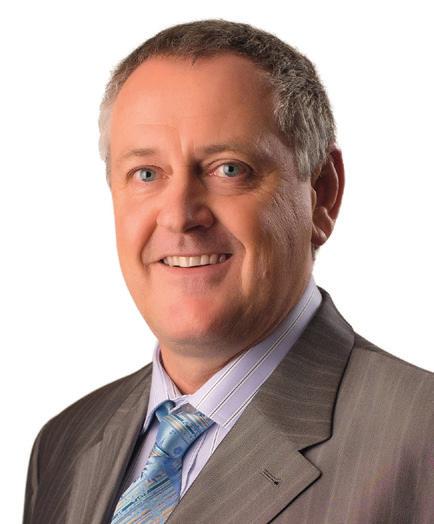
DAVID MCKAY
DAVID MCKAY
Expanding our horizons
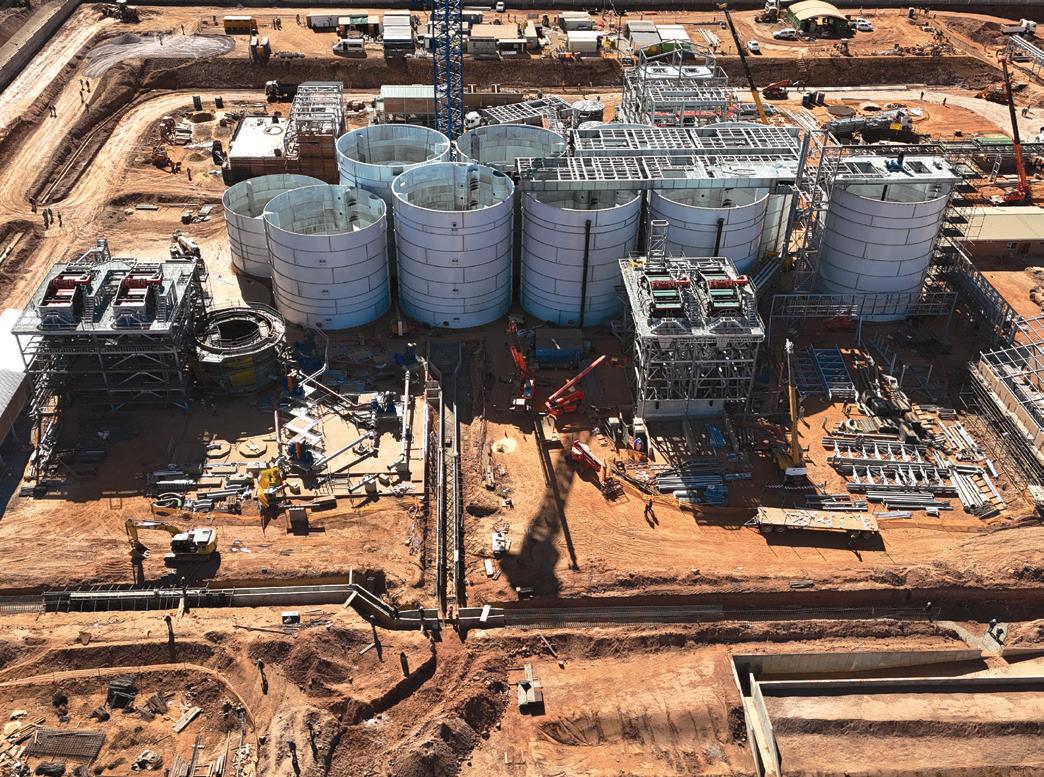

Our vision for Pan African Resources is simple but powerful:
Position ourselves as a sustainable, safe, high-margin and long-life gold producer.
We remain true to our mantra of Mining for a Future, as we continue to expand our horizons for the benefit of all our stakeholders.
Our aspirations to further develop Pan African as a leading and growing mid-tier gold producer, is underpinned by our belief that our business success depends on our ability to balance economic, environmental and social considerations. All part of delivering a smarter, more agile and future-focused approach to mining.
Mining’s big permitting problem
BY GIULIETTA TALEVI
ASK any mining boss what causes evening sweats, and it’s probably not a posse of cute rodents, or tumps of seemingly unremarkable grasses.
Yet for Gold Fields and Sibanye-Stillwater respectively, the discovery of a group of endangered species of short-tailed chinchilla and the presence of a rare strain of buckwheat have probably been enough to cause more than a few sleepless nights.
In Gold Fields’ case – as has been widely reported – the discovery of an estimated 25 of the animals at its $1bn Salares Norte mine in Chile has had an almost comically outsized effect on developing the prospect, which it first identified in 2011 as its next big thing. It has spent about $5m researching and monitoring the animals – not even moving them – since about 2018.
Then, earlier this year, they vanished from one of the areas being monitored. You might think that would be good news. It wasn’t.
Their disappearance prompted Chile’s environmental watchdog to order an “urgent and transitionary measure” halting the dismantling of the chinchillas’ rockery (Rocky Area No 3). If Gold Fields can’t locate them – and if indeed they are there – relocate the animals over the next year it will have to relook at its entire mining plan sequence for Salares’s Agua Amarga pit.
Gold Fields CEO Mike Fraser says Chinchillagate raised the trade-off on whether to go underground or “create further surface disturbance”.
“If we go underground it will have lower impact on the chinchillas and (it) potentially gives us optionality on further underground exploration,” he says.
Gold Fields downplays the impact of the chinchillas, arguing that 90% of the overall value of Salares Norte sits in the Brecha Principal pit “which is what we are mining today”. Fraser says the part of the mine in-

habited by the rodents accounts for just 10% of Salares Norte. So, “from an economics point of view it is not a material thing”.
Still, fascination with the issue – and fears that it could have a major impact on production targets – have done a fair amount of damage to Gold Fields’ share price since it first made headlines.
For Sibanye-Stillwater, already under acute financial strain over a drastically reduced palladium price, the presence of Tiehm’s buckwheat, described by the US Fish and Wildlife Service as an “imperilled plant”, has snarled up the Rhyolite Ridge project in Nevada, in which it has an option to take a 50% stake for $490m.
The large, shallow lithium-boron deposit should be one of the first large-scale US lithium projects to enter production, and is key to Sibanye-Stillwaters’s ambition of becoming a global battery metals miner. If
it goes ahead, that is.
Head of Sibanye investor relations James Wellsted says that at the stage they announced the investment, the buckwheat hadn’t yet been declared endangered. Ioneer, the Australian company that owns the prospect, that is now doing a revised feasibility study which has been sent off for environmental approval.
Asked whether the grass could scupper the whole deal, Wellsted says not necessarily. “But maybe what we need to do –because it’s a huge area – is develop a bigger project than what was originally envisaged.”
Sibanye-Stillwater’s case in particular encapsulates the irony at the heart of global mining right now: that deposits of so-called green metals like lithium, copper and nickel may be that much harder to extract given a far more stringent focus on the environment.
Buckwheat
‘The top 20 undeveloped copper resources today remain sterilised because of sustainability-related constraints, in particular communities and water, which, as we have seen in Quellaveco, are often interlinked’ – Duncan Wanblad, CEO, Anglo American
thorities, which have taken a harder stance on the chinchilla issue than the state itself. “They would almost take the view that if mining didn’t happen they would be quite happy,” says Fraser.
“I don’t think it will create a sustainable problem on the project, but it does mean we have to be hypersensitive on how we engage with the agencies, and anytime there is potential for negative news they will certainly pick up on it,” he says.
HISTORY OF DESTRUCTION
You can understand why anti-mining sentiment is so prevalent: until perhaps the past two decades, the sector has indulged in years of unabashed environmental destruction.
of the problem, it could be viewed as part of the solution.” It quoted Jakob Stausholm, Rio Tinto CEO, who said: “You will simply not be able to build a new-energy system and reduce the world’s CO2 emissions without getting sufficient access to a number of minerals.”
Access to Anglo American’s vast – and permitted – copper reserves, after all, are what drove BHP’s now aborted bid to buy the company.
In presenting its restructuring plan sparked by the hostile approach, Anglo CEO Duncan Wanblad said: “It’s important to note that one of the key constraints to growth in copper is not capital, geology or technology – it’s sustainability.
“The whole point is that these metals are critical to the world meeting its climate change targets but at the same time there’s local resistance to projects being brought on, so you’ve got this tension,” says Wellsted.
Paul Miller, of mining consultancy AmaranthCX is more blunt: “It takes so long to make a discovery, but once you’ve made (one) there’s no guarantee that you can mine it from a regulation point of view.”
Luckily for Chile’s environmentalists, says Miller, it was Gold Fields that discovered the chinchillas. As a listed company and a signatory to the International Council on Mining and Metals (ICMM), a global standard that holds mining companies to account over social and environmental damage, it couldn’t just ignore the problem.
Notably, only 24 mining companies belong to the ICMM. While the majors like Anglo, BHP, Codelco and Vale are signatories, two thirds of the world’s mining companies are not, and aren’t necessarily beholden to the group’s commitment of sustainable mining.
Miller argues that either “someone else is going to mine it anyway and the West is going to lose access to those resources, or it’s not going to be mined at all and left in the ground, and the overall impact on climate is different. It’s helluva complex. The point is that all new mining projects are going to take much longer with much bigger financial risks.”
That complexity is evident in Gold Fields’ own relationship with the Chilean government and the country’s environmental au-
The backlash was always going to be fierce. Take mining laws passed in various US states, like Maine, where recent regulation forbids mining for metals in open pits of more than three acres. It’s one of the harshest in the US. Understandably so: according to The Maine Monitor, in the 1960s the Callahan Mining Corp was given permission to drain a 75-acre coastal estuary in the town of Brooksville and turn the area into an open-pit mine. By 2013, researchers found “widespread evidence of toxic metals in nearby sediment, water and fish”. The clean-up bill, eventually, was around $45m.
It means that a major lithium deposit found in Maine in 2021 and described by local news as “the richest known hard rock lithium deposit in the world” may never actually be extracted.
Meanwhile, Alaska recently sued the US Environmental Protection Agency (EPA) for blocking the development of what’s been called the world’s largest copper and gold resource – the gargantuan Pebble deposit (an estimated 4.5bn-tonne copper whopper) in Bristol Bay.
But Bristol Bay also houses the world’s largest sockeye salmon fishery, not to mention extensive bird colonies. Mining, argues the EPA, would degrade the watershed and harm fishing ecosystems. Alaska, on the other hand, argues that it’s been denied billions from taxes and royalties in a “blatant affront” to its sovereignty.
Yet, as Financial Times wrote in a recent report: “Rather than an industry that can be dismissed as polluting, destructive and part
“The top 20 undeveloped copper resources today remain sterilised because of sustainability-related constraints, in particular communities and water, which, as we have seen in Quellaveco, are often interlinked.”
What’s more, said Wanblad, the cost of bringing brownfield expansions online “should be significantly lower than those for new greenfield projects, and so the growth potential of brownfield expansions in our assets will also be more value-accretive”.
REMINING THE FUTURE?
Mining’s present low-popularity status is perhaps why Keith Scott, head of mining tailings firm Fraser Alexander, might be feeling like a man in the right place at the right time. Fraser Alexander, after all, is in
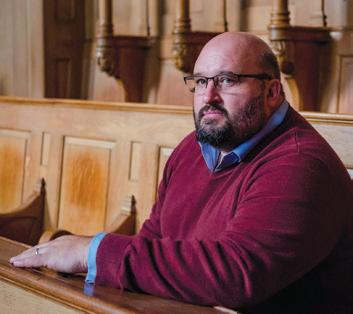
Chief responsible investment officer, Adam Matthews, Church of England Pensions Board
the business of remining metals from old mining waste.
Like other mining veterans, Scott has seen a “massive” change in the social and environmental permitting framework since he began working in the sector 25 years ago. In South Africa, says Scott, there is “a lot” of resistance to new mines, whether from the regulator, communities or NGOs. Just look at the response to Shell’s Wild Coast oil exploration proposals.
He describes mining’s problem as twofold: a crisis of relevance, and acceptability.
Mining “is no longer deemed an acceptable use of land … in (some) places you can forget getting permits.”
“In 10 to 15 years’ time I wouldn’t want to be in primary mining,” he says.
Of course, Scott is talking his book. But, he says: “There’s a tremendous amount of the resources that we seek available to us in residues.” By his estimate, there are 280 billion-odd tons of tailings, worldwide, that could be remined.
As for new mining, it creates waste, and that’s “close to untenable in developed countries”, he argues. Still, it means there are opportunities for smarter technology to extract metals from tailings, as well as water. “The people who get that right are going to find themselves permittable where others aren’t,” says Scott.
SRK Consulting associate partner and principal environmental scientist Kirsten King has a nuanced take on the permit issue. King, who also has three decades in the field, says that despite a more stringent approach by regulators, environmental permitting isn’t a key factor discouraging investment in greenfield mining projects. This is “largely because most mining companies are already geared up in their sustainability goals as part of their mining operations”.
“However,” she says, “they are likely to select those jurisdictions that deliver the most efficiency and certainty in any regulatory compliance process. Where delays and lack of clarity create too much project risk, then they are likely to look elsewhere.”
But she acknowledges that laws and regulations have become far more complex and prescriptive, especially when it comes to wetland areas in South Africa.
Wouter Jordaan, a partner and principal environmental scientist at SRK, says the
problem isn’t an intractable one. Because new mines consider ESG aspects in the early stages of mine planning, they can tackle possible impacts during the design phase. Newer technology also means less waste production.
Jordaan is adamant that primary mining “will remain central to our livelihoods” but admits that recycling will “undoubtedly grow alongside it”.
As for the metals of the future, Scott says: “We need big copper mines, but the mining industry is very slow and inflexible and takes us an average of nine to 10 years to bring a new mine online, from discovery to production. And we know that we’re going to struggle to get a permit whether it’s for social or environmental reasons.”
You can see then why mining waste looks so appealing. “The grade in some of these historic dams is looking as good as your mine copper grade and to remine tailings you don’t need anything like the capital you would to build a new mine – and of course you are straight into production, where you don’t have to strip for years or sink a shaft.”
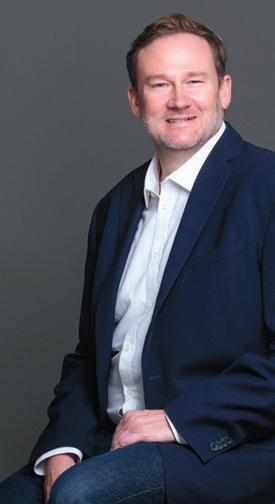
But he’s also cautious on the ebullience of copper demand forecasts, pointing out that the huge development experienced by a previous metals guzzler like China means it will need less and less of the raw commodity in future, simply because it will be able to recycle far more from the millions of televisions and washing machines sold to newly affluent consumers in the past 20 years.
Besides mining with an eye on ESG, the feeling in the industry is that those companies who don’t jump on the secondary mining bus are going to lose out, big. This and recycling “have got to become bigger parts of the overall supply of these metals”, says Sibanye-Stillwaters’ Wellsted.
Mining’s crisis of relevance has also got a lot to do with how it has repaid investors over the past couple of decades. Smoothing out the wild highs and wilder lows, the returns aren’t brilliant – particularly in mining exploration.
“The attractiveness of the sector has never regained the investable attractiveness it had up until after the Global Financial Crisis. A lot of the capital invested in mining and especially exploration has gone, and is not coming back,” reckons Scott.
That’s clear from research produced by Swiss-based Pala Investments, which recently calculated that commodities account for just 2% of global assets under management, down from 9% in 2009.
“Mining investors got seriously burnt –they were sold a helluva story by the industry and a lot of it never came to fruition; the project failure rate was massiveten years ago. I know mining brokers in London – sponsors – who no longer do mining. They’re much more interested in property or technology,” says Scott.
But there’s a big push to draw money back to the sector. Adam Matthews, chief responsible investment officer for the powerful Church of England Pensions Board, told FT recently that “mining ... as a whole needs a completely different level of recognition for the role it plays in the global economy”.
Matthews also chairs the Global Investor Commission on Mining 2030. “We recognise that investors are not properly valuing this sector and in particular those companies developing the most socially responsible approaches,” he has said.
CEO, Fraser Alexander Keith Scott,

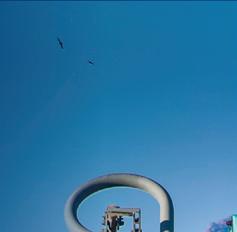
As the world’s foremost hydro re-mining company, the largest outsourced tailings management contractor globally, and a leader in mineral processing, our comprehensive expertise at Fraser Alexander allows us to deliver unparalleled services tailored to meet your operational needs.
Our trade-marked innovations are at the forefront of research, development and innovation in the mining industry:

• The Remotely Operated Mining Unit (ROMU™)
ROMU™ was developed to mitigate operational risks by removing operators from the field.
• Electric-Hydraulic ROMU™ (ROMU™-EH)


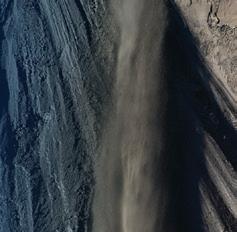
The ROMU™-EH removes fossil fuel combustion and eliminates the risk of hydrocarbon spillage of on-site, shift-based, unit refuelling. It extends oil life because the temperature is lower and operational downtime is reduced.
• Electrical Remotely Operated Mining Unit (E-ROMU™)
E-ROMU™ is an innovative, fully electric mining unit that operates remotely without hydrocarbon use, setting new standards for sustainability in mining.

• TORAS (Technical and operational risk assessment system) TORAS helps to monitor and manage risk and compliance of all deposition contracts. TORAS integrates and supports all our digital services via an online portal – giving you a single and transparent dashboard view of your facility’s data.


Innovation is the cornerstone of our business, enabling us to effectively transform mine waste into societal, environmental and economic value. Resulting in improved safety, efficiency and minimised risk.


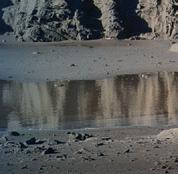


Coal is back by popular demand
BY DAVID MCKAY
THE pendulum has swung back to thermal coal. Look no further than a letter written in March to Glencore by Sydney-based Tribeca Investment Partners requesting the miner retain its coal production instead of separately listing it in New York.
The spin-out is part of a plan announced last year in which Glencore will first buy the 20-million-tons-a-year Elk Valley Resources, a subsidiary of Canadian firm Teck Resources. The $6.9bn deal will boost Glencore’s total thermal coal output to around 130mt/y. By decluttering the portfolio, Glencore hopes the spotlight will be thrown on its copper.
But the demerger also intends to satisfy investors who have been uncomfortable
with Glencore’s carbon footprint, despite an earlier pledge by the group to run down coal reserves by the mid-2040s, and shut 12 mines by 2035. More than 30% of voting shareholders opposed Glencore’s Climate Action Transition Plan at the annual general meeting in 2023. But only a year later
this opposition has cooled. Whereas in 2023 it looked as if Glencore would struggle to get future Climate Plans passed, only 10% of shareholders opposed it at this year’s AGM. What changed?
Money over climate appears to be the answer. According to a report by Morgan Stanley, shareholders were concerned Glencore’s proposed split from coal would “introduce significant uncertainty”. Firstly, there are doubts as to whether Glencore’s base metals would attract a rerating, partly because the portfolio includes less compelling zinc and nickel production. Higher ratings are applied to copper-only-producing companies, the bank said. Secondly, Glencore’s base metal assets are in places perceived to be high risk, such as the Democratic Republic of the Congo and Kazakhstan.
But perhaps the more important factor in investor reckoning is that Glencore’s coal assets are viewed as a cash cow that strengthens the entire company and shouldn’t be relinquished.
‘GROWING, QUIETLY’
The world’s coal sector was the beneficiary of unfortunate events in February 2022 when Russia invaded Ukraine. The energy security emergency that followed propelled coal prices to as much as $440/t compared to the previous 10-year average price of $80/t. Thermal coal prices have since retreated from 2022 highs, but they remain above the price forecast this year by S&P Global Metals of between $80 and $85/t. Morgan Stanley reckons coal is “growing, quietly”.
“While copper has taken centre-stage as a play on the world’s insatiable appetite for electricity and the growing needs for grid upgrades, seaborne demand for another commodity has been growing in the background,” the bank’s analysts said in June.
‘While copper has taken centre-stage as a play on the world’s insatiable appetite for electricity and the growing needs for grid upgrades, seaborne demand for another commodity has been growing in the background’ – Morgan Stanley
China, which consumes four billion tons annually – just under half of global demand – is relying increasingly on imports, up 13% year-to-date.
China’s domestic coal production is falling, owing to environmental pressures. This has a disproportionate effect on the world’s seaborne market. Every 1% growth in China’s coal demand that goes unmet by domestic mines would have a 10% impact on seaborne demand, Morgan Stanley says. China comprises a third of the seaborne market. In this context, Glencore is a key beneficiary. It exports approximately 90mt of thermal coal annually from its own mines. Every $10-per-ton change would add about $500m to its free cash flow, says Morgan Stanley.
Over the longer term, coal is at a “turning point”, according to the International Energy Agency (IEA), owing to the growing use of renewable energy, especially in Europe where electricity demand is falling anyway. Demand is expected to decline from now to 2026, it says. But in the short to me-
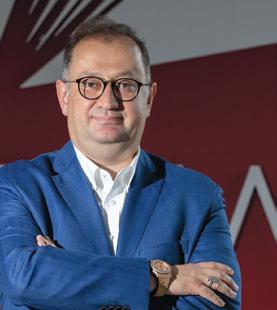
dium term, coal is a business that investors will find hard to ignore. After 2026, global coal demand will have fallen to eight billion tons a year, but it will stay there partly owing to Asia where electricity consumption is growing.
In the case of China, thermal electricity output grew 5.9% year-to-date “and has been growing steadily over time”, says Morgan Stanley. Asia (including India) will constitute approximately three-quarters of global coal demand, says the IEA. For the first time, Southeast Asia will consume more than the United States and European Union.
QUESTION MARKS
More broadly, there is scepticism with the way the market and governments have tackled renewable strategies. New Zealand’s utility Transpower warned in April that the nation was at risk of blackouts.
Following the shift to renewables, implemented under former prime minister Jacinda Ardern – which banned new oil and gas developments – New Zealand no longer has the generating power to keep the lights on during cold spells. In a turn of events that will register with South Africans, Transpower begged consumers to cut their electricity consumption.
CHOOSE BME FOR A GREENER MINING FUTURE



MD of Menar Vuslat Bayoglu
SOURCE: Bloomberg, Morgan Stanley Research China’s
One person who has questioned the ability of renewables to sustainably fix the globe’s energy demand is Vuslat Bayoğlu, MD of Menar, a privately owned 3.5mt/y coal exporter. “There is no way renewable power can provide the baseload power of thermal coal,” says Bayoğlu. “As long as we need energy people will burn coal. If you don’t have energy security you have chaos. What we need to do is focus on how to burn in a clean manner.” Bayoğlu is an outspoken critic of Eskom’s former CEO André de Ruyter for persisting with a renewable strategy to solve loadshedding. “You can’t solve the problem with renewable energy, you need baseload,” he says.
This was tacitly acknowledged in Eskom’s successful appeal in June enabling it to keep 45MW of polluting coal-powered energy production open until 2030 without facing stringent restrictions. Closing the coal-fired power stations “potentially involved plunging the country into darkness”, said a report that informed Environment Minister Barbara Creecy’s decision on Eskom’s appeal. Bayoğlu also thinks an estimated R350bn
upgrading of South Africa’s distribution network to cater for renewable power is a waste. Failing to recognise the importance of coal to energy security is akin to the West’s failure to secure the mineral supply chains for electric vehicle manufacture –now firmly controlled by a fully integrated Chinese industry, he says. It’s no accident China’s EVs are outselling Western rivals.
“China controls 80% of solar panel production. They are building coal-fired power stations because they see there is no other way. The world is closing coal-fired power stations but in Germany companies are moving to Poland because they can’t afford the energy prices.”
Instead of aggressively phasing out coal, the South African government’s Integrated Resource Plan (IRP), an energy strategy, has taken a more moderate stance recommending 18 000MW in coal-fired power generation by 2050 instead of the previous target of 10 000MW. “Coal must be a part of a diversified energy portfolio,” says July Ndlovu, CEO of Thungela. Government has accepted reality, he adds.
The IRP may give impetus to players such as Exxaro Resources, which says it may develop coal reserves in Limpopo province. “We still have reserves in the likes of Thabametsi; there’s a lot of power station coal there,” says Exxaro CEO Nombasa Tsengwa. Coal may provide a more affordable and less risky destination for R12bn in cash held by Exxaro for diversification into “green metals” that is proving hard to realise.
Tsengwa says a meeting with the World
Economic Forum in 2022 registered with her. South Africa’s renewable strategy can’t be met to its fullest extent, at least not yet, says Tsengwa. It depends on developing a national distribution network that isn’t currently sufficient to support the scale of renewable projects in the pipeline.
Developed economies are facing similar problems. Germany’s climate adviser said in June the country’s 2030 goal was likely beyond it. In April, Scotland ditched its 2030 decarbonisation target saying it was “out of reach” following delays to its draft climate change plan.
In the private sector “green funds” haven’t performed, resulting in significant redemptions. According to Barclays, investors globally have pulled about $38bn out of environmental, social, and governance (ESG) funds this year. In fact, 2024 is set to be the first year on record where ESG-labelled funds have seen more money withdrawn than added. Net ESG fund inflows in the UK have declined from £11bn in 2021 to a negative £3bn this year (see graph).
Investors have called for a more reasoned approach to the fossil fuel-renewable nexus. “There’s too much demonising between industry and the environmental community right now,” said Paul Bodnar, BlackRock, Inc.’s former chief of sustainable investing, at a conference in June. “It’s like a fight to the death. It needs to be a little bit more of a cooperative posture.”
Clearly fossil fuels are here to stay, at least in the short term – but their risks will be ignored at our collective peril, says former CEO of BP Lord John Browne. He was quoted in the Financial Times referencing the Aesop fable of the rider who stops feeding his horse in peacetime, only to find it lame when war comes. The soldier in the analogy represented the companies who are pulling back on climate action, creating more long-term risk for all concerned as the ever-greater effects of the climate crisis loom.
“The story is a good reminder that if we want something to serve us longer, we need to take care of it constantly,” he said. “The hard truth is that we’ve done a poor job of reconciling corporate actions with the interests of society and the planet in a balanced way. Yet the urgent need to do so is undiminished.”

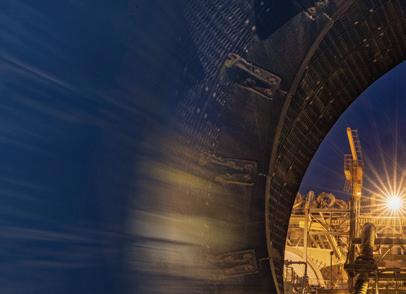
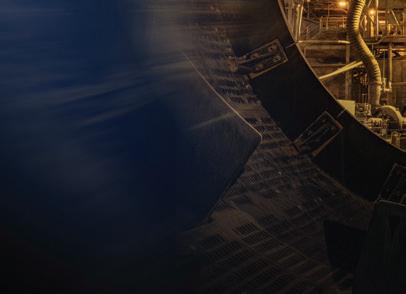



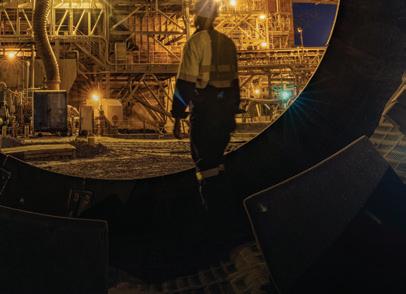

Barrick consistently delivers sector-leading returns to its shareholders while the benefits it generates for all stakeholders drives economic development and social upliftment in its host countries. Its ability to sustain the profitability which enables this is secured by the world-class growth projects embedded in its asset portfolio. Organic growth alone is expected to increase its attributable gold and copper production by some 30% by the end of this decade, a likely peerless achievement.





Thungela weighing options in Australia
BY DAVID MCKAY
WHEN Anglo American demerged its South African coal assets into Thungela Resources it agreed to continue marketing the fuel in return for a relatively modest 1% of revenue. As it was 2021 and coal was then public enemy No. 1, the marketing fee represented something of a corporate largesse. The coal assets were limited in life and Anglo expected its UK shareholders to flee Thungela. What the UK miner didn’t bet on though was a quadrupling in coal prices that year.
Thungela went on to pay bumper dividends, but it also allocated A$335m in cash to buy Ensham, a mine in Queensland, Australia. Coal prices have since retreated but July Ndlovu, CEO of Thungela, says valuations on coal reserves have increased because the world is jittery on energy security following Russia’s invasion of Ukraine in 2022. Small geopolitical events can have big outcomes, says Ndlovu. Existing coal mine owners are now more reluctant to sell, or have much higher value expectations. “We still see opportunities in mergers and acquisitions, but it’s becoming more difficult.”
The firm’s shareholders are also watchful of Thungela’s spending plans. They downed a company resolution to issue shares for cash at the firm’s annual general meeting in June. Ndlovu says the negative vote was no great surprise. He also downplays its consequences. “It wouldn’t affect our ability to do M&A but the message we receive all the time is that as a pure play the preference is that we give cash back to shareholders.”
M&A makes sense for Thungela because rail and port logjams in South Africa, which are unlikely to ease this year, are constricting export sales. Better still – as it’s cheaper – is the brownfields expansion of Ensham itself. The property contains about a billion tons in coal reserves of which current production, estimated to be 3.2mt to 3.5mt this
year, is a fraction. Ndlovu has high hopes, however, that production could be pushed to four million tons this year by making substantial mining improvements. A yet greater increase in annual production is the company’s aspiration in the long term.
“It’s a massive resource. We just have to find out what is optimal in terms of production. Is it five million tons or 10mt a year? I can say we will know by the end of the year,” he says of a feasibility study on Ensham’s expansion.
Thungela is currently spending R2.6bn developing Elders and Zibulo South, new mines in South Africa that will replace depleted reserves elsewhere in the portfolio. The company also keeps a R5bn “cash buffer” in order to protect the balance sheet against market volatility, and because Thungela is a single commodity producer it would be risky for the firm not to have it. Improving the performance of Transnet, the
state-owned utility, would result in a major uplift for the company.
Ndlovu doesn’t expect Transnet Freight Rail (TFR), Transnet’s largest division, to improve coal delivery rates this year. In fact, they may well deteriorate following two derailments in the first half involving Thungela trains, costing the company 650 000 tons in exports. “It was extremely disappointing.” In both cases, signalling was at fault. “That’s a problem I’ve been talking about for a while. Without proper signalling, TFR doesn’t really know where its trains are on the Mpumalanga to Richards Bay line, and that’s what happened this year. Both derailments were collisions.”
Ndlovu cracks a chuckle about the incident, but it’s a bitter one considering the economic consequences. Thungela is likely to see one million tons in on-mine stockpiles as a result, which translates into less flexibility in managing the coal sales mix. As a result, the discount to the benchmark price on Thungela’s average sales increased from 14% to 15% in the first six months.
At the time of writing, there’s some selling pressure on Thungela shares but that can change quickly if the coal market changes pace. “It’s impossible to predict geopolitical events but then you don’t need a massive event to bring coal security back into play,” Ndlovu says
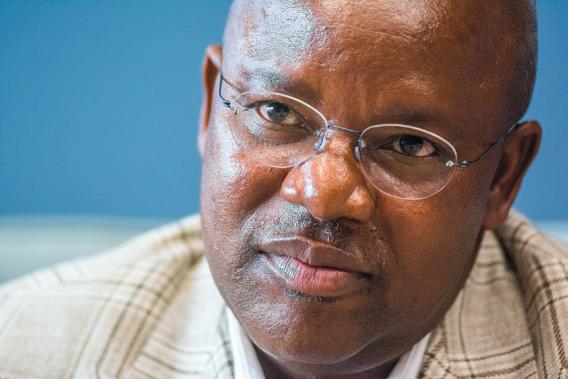
July Ndlovu CEO, Thungela Resources
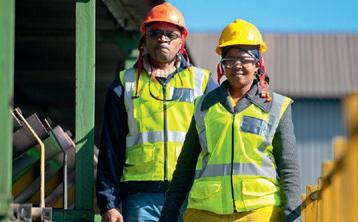
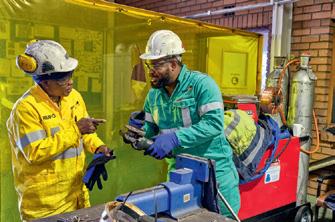
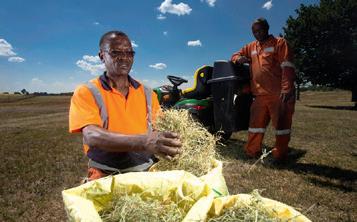
As a responsible employer and corporate citizen, we…
Provide around 16,000 jobs to employees, contractors and more through our procurement practices and small business development programmes.
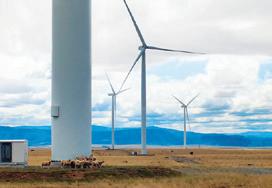
Provide extensive training and development opportunities to our employees as well as our host communities in the form of bursaries and scholarships, skills development programmes, learnerships and apprenticeships, internships and graduate development programmes, and partnerships with educational institutions.
Ensure that our host communities benefit from our activities through our social and labour plan (SLP) undertakings and our Corporate Social Investment (CSI) initiatives, and through our Community Trust, communities own a 5% shareholding.
Seriti Green is currently building South Africa’s largest wind farm in Mpumalanga which will not only contribute to the electricity needs of South Africa and reduce carbon emissions when it comes online by 2025 but also provide job opportunities during the construction and operation phases.
Gold Fields’ chinchilla conundrum:
What a long, strange trip it’s been
ED
STODDARD
Reporter ED STODDARD reflects on seven years covering the intriguing fate of a rodent with the power to stop a $1bn mining project in its tracks.

At the Cape Town Mining Indaba in 2017, I interviewed former Gold Fields CEO Nick Holland, and he set me on a rodent trail high up in the Chilean Andes.
What a long, strange trip it’s been.
To wit, Holland told me that for the environmental permitting for Gold Fields’ Salares Norte gold mine project, the company needed to capture and relocate a colony of rabbit-sized chinchillas in the vicinity of the mine. I did a small story at the time for Reuters.
But the story piqued my curiosity. The critter in question, the short-tailed chinchilla, was almost hunted to extinction for its fur and had not been seen in the wild for almost five decades before it was rediscovered in 2001.
An intriguing saga – an $860m mine project that needed to accommodate two dozen rare rodents.
In 2020, I asked Gold Fields for an update and found out that “Operation Chinchilla” was a go. I did a story for the US science magazine Undark, detailing plans for the $400,000 operation to bait and live-trap the animals and move them to a suitable habitat.
The story got picked up by a number of other US publications and appeared on the radar screens of Chilean conservationists, bringing it under a new level of public scrutiny.
Gold Fields is good at mining, but rodent removal is not one of its core competencies.
To its credit, the company was striving to do right by the creatures, hiring consultants for the project. Still, an expert in the esoteric art of live-trapping small animals warned that the chinchillas might not play ball.
BUT SERIOUSLY, WHAT COULD GO WRONG?
Well, things went pear-shaped. Two of the first four chinchillas that were captured died. A survivor injured a leg and was flown to Santiago for treatment.
Chilean regulators halted “Operation Chinchilla”, but Gold Fields could continue building the mine, which poured its first gold in April 2024.
However it needed to come up with a new chinchilla plan, and even mulled going underground for one of the planned open pits to accommodate the animals.
Three years later, a new plan was approved and Gold Fields relaunched the chinchilla capture in February this year – at an inflated price tag running into undisclosed “millions” of dollars.
During an operational update in May, Gold Fields CEO Mike Fraser said in response to my questions that no chinchillas had been captured because it was “quite conceivable that the chinchillas moved on”.
I raised the possibility that this may well be the case because a mine had just been built in the chinchillas’ hood, prompting the fur balls to translocate themselves.
But it seemed curious that Gold Fields found this “conceivable” without knowing for sure. These are after all million-dollar rodents that are subjected to intense monitoring with cameras and have 16 vets at their disposal.
The upshot was that the story got picked up in Chile and the regulator again halted “Operation Chinchilla”, with the pointed demand that Gold Fields provide all of the evidence that the animals had indeed vacated “Rockery No. 3” – a piece of prime chinchilla habitat that was close to the mine waste site and which the company had initially been given permission to remove.
GOLD FIELDS’ SHARE PRICE FELL 6% ON THAT NEWS.
The moral of the story I guess is that small animals can be big headaches for mining companies. But it’s been one of the funnest and most fascinating tales I have ever covered and I look forward to the next act in this unfolding drama.











Mining for the times
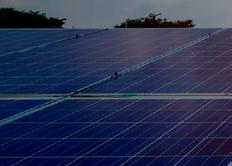

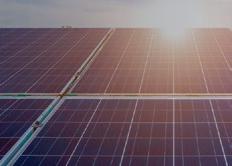



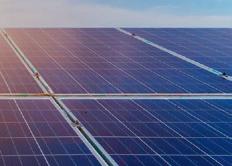

Generating wealth by ‘taking out the waste’
Mostly grey water in closed circuit used for reprocessing
No new mine waste created
60MW PV plant in the pipeline to significantly shrink carbonfootprint


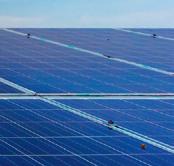
Land rehabilitated and environment restored
Social capital focused through poverty alleviation, youth education and improved quality of life


South Africa’s illegal gold mining is surging
BY ED STODDARD
AGAINST the backdrop of record-high prices for gold,
Sibanye-Stillwater has reported a surge in illegal mining incidents and arrests around its South African operations that produce the precious metal. Known as ‘zama zamas’, most of the illegal gold miners hail from Lesotho and Mozambique, countries that once provided most of the industry’s migrant labour force.
The reasons for this growing crime wave may be linked to the red-hot price of gold, but Sibanye-Stillwater says it may also be a reflection of “enhanced vigilance”.
Data exclusively provided to MiningMX by Sibanye-Stillwater shows there were 581
recorded illegal mining incidents around the company’s South African gold operations in the first quarter (Q1) of 2024 — an astonishing 241% increase over Q1 2023.
Sibanye-Stillwater’s security services made 247 arrests related to illegal mining and other criminal activities such as copper cable theft in the first three months of this year, 312% more than in the same period in 2023 (See graph).
These numbers are material and shocking.
“The operating environment in the Southern African region remains challenging from a security and crime perspective, with illegal mining and cable theft the
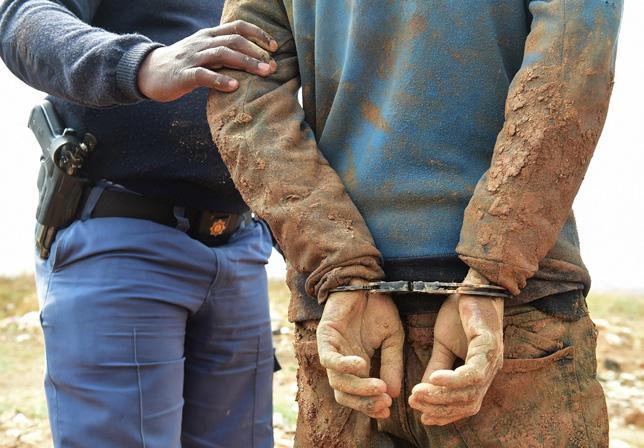
primary concerns, but general criminal activity,” said Sibanye-Stillwater spokesperson James Wellsted.
“Although the recent increase in illegal mining incidents does coincide with higher prices, it is not certain that this is directly related to the increase in the gold price. The significant increase in the number of arrests may also reflect the enhanced vigilance and success of the SPS strategy and preventative actions.”
Wellsted noted that most of the arrests in the first quarter of this year were linked to measures to cut off the supply chains that provide illegal miners with the means to spend weeks underground. “Of the 587 illegal miners apprehended during quarter one 2024, around 410 handed themselves in due to targeted disruption of supply routes established to sustain illegal miners underground,” he said.
COLLUSION
Wellsted also pointed to Sibanye’s policy –employed by other gold producers in South Africa – of restrictions on miners taking food underground, a measure that has been agreed with unions.
Some employees collude with illegal miners and one of the ways is through supplying food to the zamas, who access both working and disused operations. The scale of illegal employee involvement is underscored by the number of arrests in Q1 on this front.
“Collusion and complicity of employees with criminal groups continues to undermine security measures. In the first quarter, 103 mine employees and 67 contractor employees were detected assisting illegal miners. In seven incidents, 19 employees were either arrested or brought up on disciplinary charges for targeting gold-bearing material (GBM) in the gold plant environment,” Wellsted said.
Illegal gold mining is a highly organised criminal activity underpinned by a global network of crime. Much of the illicit gold makes its way to places such as Dubai, where it is laundered in refineries and then enters the global market.
In typical mafia fashion, it relies on coercion, intimidation and violence.
A senior official in a mining union once told this correspondent that zamas zamas

would typically threaten the family of an employee at the gold mines — usually one responsible for access control — and give them a stark choice: they could make some extra cash on the sly, or some tragedy might strike their kith and kin.
One of the root causes of this scourge is the decline of the migrant labour system. Under apartheid it subjected a rural population drawn from Lesotho, Mozambique and former Black South African ‘homelands’ such as the Transkei to ruthless exploitation, which kept wages low and the miners in a state of dependency.
South Africa’s mines — mostly gold
Sibanye Stillwater’s gold mines
— once employed almost 500,000 foreign workers. That number in 2022 had fallen to 35,000, according to data compiled by the Minerals Council South Africa, which represents the country’s mining sector.
Wages and working conditions, including safety and health, have dramatically improved in South Africa’s mines over the past three decades. A rock-drill operator now earns more than a state school teacher or a cop, and the chance of accidents has been greatly reduced.
But foreign workers have been largely excluded from the fruits of this new and far fairer dispensation. The illegal miners are men whose fathers and grandfathers once worked in the mines — an economic opportunity denied their generation.
Meanwhile, an economy such as Lesotho’s, which in the past was heavily reliant on remittances from South Africa, has hardly developed. In 1987, foreign remittances amounted to 236% of Lesotho’s GDP, according to World Bank data — the biggest such ratio of any country since 1975. They now amount to only about 20% of its GDP in official data.
Remittances are still returning to rural villages in the mountains of Lesotho, but the bulk are now probably the product of illicit proceeds generated by illegal gold mining.
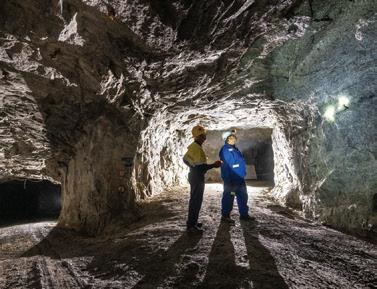
This 'ole (mining) house
The diversified mining company has lost its market cachet, a shift in focus that could spell the end of Anglo American even as it attempts to restructure, writes
AT his zenith as CEO of Anglo American, in 2019, Mark Cutifani described the group in new terms. It was a ‘materials solutions provider’, he said. The notion of Anglo as a miner didn’t account for its customer-facing practices, or its industrialisation. Nor, he argued, its unique portfolio of diamonds, platinum, and a soon-to-be unveiled foray into specialised fertiliser minerals.
Cutifani’s vision for Anglo is now, only five years on, anachronistic to investors. The (dare one say it) miner’s current CEO, Duncan Wanblad, is in a foot race to make the group leaner. By streamlin-
of industrial and consumer commodities”, he adds.
Anglo is not alone in seeking simplification; if anything it is actually quite late to the party. Each of its rivals, including BHP, which sought a takeover of Anglo in May, have narrowed their focus and simplified their structure. Wanblad’s plan is to unbundle the firm’s 79.2% stake in Amplats, its platinum group metals business, and sell De Beers, sell or mothball its nickel, sell manganese in South Africa, and metallurgical coal assets in Australia, the last and easiest of its tasks.
While fund managers don’t think the diversified mining company ing production so it only produces copper and iron ore, Wanblad is bowing to investors who are ‘jam today, not tomorrow’ in preference. If he fails, Anglo will be eaten by a rival, most probably BHP, but possibly other predators lurking on the sidelines.
Driven by the potential of copper demand, investors – many of them holding Anglo shares through passive funds – don’t want the distractions of diversity that were the hallmark of Cutifani’s mining house and those of CEOs for decades before him. This preference is reflected in valuations investors give to pure-play copper companies that trade at a premium.
“Despite the strong fundamentals of the diversified miners, they do not currently command the valuations they have seen in the past or the current valuation of the copper miners,” says Matt Greene, an analyst for Goldman Sachs. The mining sector is also seeing an influx of “targeted capital seeking clean, single-metal exposure that aims to avoid the complexities associated with understanding a broad spectrum

is entirely obsolete, a different approach to capital allocation is de rigueur. If there is any cardinal sin at the heart of big mining, it is cross-subsidisation of loss-making or developing businesses with cash from successful stablemates. “The theory is that ‘we always have positive cash and can invest it because we are diversified’,” George Cheveley, a fund manager for asset management company Ninety One said at the London Indaba in June. “But you can also do that by being very low-cost,” he added.
Active fund managers also feel they can do the reinvesting themselves rather than rely on a diversified miner to do it for them. “But I don’t think they are obsolete,” says Cheveley.
For instance, diversified miners have scale to tackle large, capital-intensive projects, Cheveley says. Miners can also diversify in ways that are currently unavailable to some fund managers who are tied to specific investment mandates. “Geopolitical diversification is an aspect that I personally seek,” says Tal Lomnitzer, senior investment manager
DAVID MCKAY. DAVID MCKAY
SOURCE: Goldman Sachs
at Janus Henderson Investors in London. “Firms that diversify political risk are more attractive than a single commodity company,” he says. He also backs companies with diversity in income stream through so-called intermediate or downstream production. But is balance sheet heft and having institutionally bred project expertise enough for new investors? Most are saying no partly because the task of project building, always onerous, is being transformed by new factors. Greenfields projects are more complex today because the mineral deposits are lower in yield, and therefore technically harder to mine for profit. Today’s projects also take longer to permit owing to a tightening in the regulatory framework, itself a consequence of changing ideas of mineral custodianship. Water, community contentment, and fauna are political hot potatoes, especially in developing economies, but not only them.
A new copper mine takes more than 20 years to build from discovery, as demonstrated by Anglo American’s Quellaveco mine in Peru (which took 30 years). Another mine, BHP/Rio Tinto’s Resolution, was discovered in 1995 and spent nearly a decade on its environmental impact permit process. The greater the time factor, the greater the capital intensity. A study of seven copper projects in Latin America by Goldman Sachs found that the average capital intensity of a project increased 50% from pre-feasibility study stage to production.
Faced with these challenges, investors think mining companies are increasingly embracing joint ventures, seeking to develop brownfield projects (or extensions of existing production), and even preferring merger and acquisitions, which were once more expensive than building from scratch, but now aren’t.
The percentage of completed mining deals involving the world’s largest 40 companies that were focused on “critical minerals”, including copper, rose to 40% in 2023 from 22% in 2019, according to a report by PwC in June. This underlines a “seismic shift driving M&A activity”, says Andries Rossouw, Africa Energy, Utilities and Resources leader for PwC. “Copper and lithium dominated such deals, accounting for over 70% of them by volume, up marginally from 2022,” he says.
The largest mining project in the world today is Simandou, an iron ore deposit in Guinea. Such is its scale, the $20bn project has been divided into concessions run by consortia, including Rio Tinto in one half of the deposit, and a large Chinese consortium on the other. Anglo sold 40% of its Quellaveco project to Mitsubishi. Despite evidence of them, joint ventures of this ilk are all too rare, however.
Jim Rutherford, a former non-executive director of Anglo who served on the group’s board when Cutifani was CEO, says the mining sector has for years failed to establish development partnerships despite having the rival oil and gas sector prove their worth. “The mining industry is really light years behind the oil and gas industry.”
Mining M&A

But there are signs of change. Alliance-seeking beyond traditional sector boundaries is now in evidence. Miners are looking for different sources of capital or they are integrating new skills in specialised areas of technology and sustainability, says PwC, an auditing firm.
In some cases, this has led to some unlikely partnerships. In an effort to diversify from oil and gas in favour of local minerals, Saudi Arabian company Ma’aden formed a joint venture with the country’s public investment fund. The outcome is Manara Minerals, a company that’s in talks to buy a stake in Pakistan’s Reko Diq copper-gold mine where Barrick Gold is anchor investor and developer. In another example, Rio Tinto teamed up with Sumitomo and the Australian Renewable Energy Agency to investigate green hydrogen in power-intensive aluminium smelting.
SOURCE: PWC
Sovereign fund balance sheets are one solution to project financing; so are joint ventures with downstream users, semi-manufacturers, commodity trading groups, and other mining companies. But Rutherford says mergers between the likes of Anglo and BHP are perhaps the best solution to founding tomorrow’s megamines. Anglo’s $5.4bn Quellaveco copper project was “planned
Duncan Wanblad CEO, Anglo American
to death” after the group had previously “torpedoed” its balance sheet building the Minas-Rio iron ore project in Brazil, he said. “This industry has a problem of scale. That’s where I differ on the combination of Anglo with BHP,” he says in response to critics of the deal.
WANBLAD’S FOOT RACE
One vocal critic of BHP’s bid for Anglo was Adam Matthews, chief responsible investment officer for the Church of England Pensions Board. Speaking at the London Indaba, Matthews remade the case for Anglo’s survival. “I didn’t see that having two significant operators merging, and all the time and money in managing that process, was effectively leading to additional tons of copper,” he said.
More importantly for him, the takeover of Anglo put certain social investment at risk in emerging economies, especially in Southern Africa. “Anglo is a significant operator in Africa,” he said. Its merger with BHP “would have diminished the role it plays in a significant mining environment that needs good practitioners of a certain size in that society”.
Regardless of its standing in emerging market economies, the future of Anglo is expected to remain at risk for some time to come, even if it is able to restructure successfully. “We think that this new, smaller business would be seen as an extremely desirable group of assets both by investors and potentially by industry participants,” said Bank of America analysts in a recent report. Wanblad’s restructuring, which he has
De Beers — Rough Diamond Sales
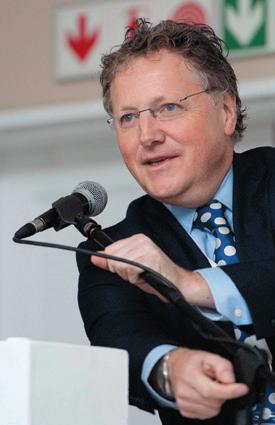
pledged to complete in two years or less, will be hard to execute. In the view of Goldman Sachs’ Greene, it could see Anglo’s capital returns reduced in the interim as it keeps non-core business well capitalised as part of the sale process. “We see high execution risks that balance out the risk-reward profile,” says Morgan Stanley, an investment bank.
“In our view, while the BHP proposal had its structural challenges, solutions were possible, we think, and we struggle to see how Anglo’s new strategy can deliver value
comparable to the final BHP bid,” says Richard Hatch, an analyst for Berenberg Bank. Unbundling Amplats will take 18 months at least, he says. Selling De Beers is yet more fraught.
The diamond market is at an ebb amid a slow growing Chinese economy. Anglo’s book value of about R7.5bn on De Beers is at odds with independent analysis. Investment bank Jefferies and Berenberg think it’s worth R3bn. It’s possible Anglo might impair the diamond producer as it prepares to sell the asset. There’s another view that Anglo will settle for a listing of De Beers because it will be too difficult to find a single buyer for the luxury brand and the mining assets.
In its structural and value contortions, Anglo best characterises the changing shape of mining investment. While supply of critical minerals, especially copper, is driving change, it’s also worth bearing Rutherford’s view in mind that investors haven’t forgotten the capital abuses of the previous commodity cycle. This is the so-called supercycle of 2008 to 2015 driven by China’s double-digit GDP growth.
The combined capital expenditure of the six largest diversified miners in those years was $410bn, more than half of all capital deployed in the sector, according to Goldman Sachs data. A further $110bn was spent on dealmaking, mostly buying assets or diversifying into new commodities. This was followed by $60bn in impairments after 2015 – a value loss that drove generalist funds out of the market, some permanently, and made specialist mining funds sceptical of mining house ambitions.
Capex over the past eight years for the big six diversifieds has fallen to about $190bn – 55% lower than the total spent over 2008-2015. Some $177bn has been returned by miners and a further $39bn in share buybacks.
In this context, Wanblad’s restructuring, if successfully completed on time and “for value”, is only part of the equation. High performance from the assets Anglo intends to keep, its copper and iron ore, will be critical, even as management attention is sapped by the multiple, big-name asset sales and unbundling. Failing to supply investors with the short-term returns they require will be the ultimate test for Wanblad.
SOURCE:
Jim Rutherford Non-executive chairperson, Centamin
Spurned by Anglo, what does BHP do next?
BY KRISTIE BATTEN
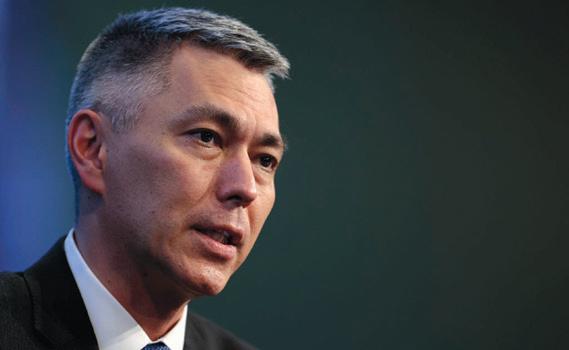
THE mining world got a jolt of excitement in April when BHP, the world’s largest mining company, made a takeover approach to its smaller British rival Anglo American.
BHP initially proposed offering 0.7097 of a share for each Anglo share held, valuing Anglo at £31.1bn. A key condition of the proposal was the demerger of Anglo’s South African assets, Anglo American Platinum and Kumba Iron Ore.
After Anglo rejected the proposal, BHP returned in early May, increasing the offer ratio to 0.8132 of a share for every Anglo share held. When that was again rejected, BHP submitted a final offer ratio of 0.886 shares for each Anglo share and Anglo agreed to extend the deadline for BHP to make a firm offer by a week to May 29 and
engage with BHP.
Hours before the deadline, BHP announced it would not be making a firm offer for Anglo, with CEO Mike Henry citing capital discipline and “South African regulatory risk and cost”. Unless there is a rival bid for Anglo, BHP has to wait at least six months before it can consider another tilt for Anglo under UK takeover laws.
BHP has made no secret of its desire to increase its exposure to copper and acquired Australian producer OZ Minerals in early 2023 for A$9.6bn. There was little doubt the driving force behind the Anglo approach was copper.
Anglo has stakes in three of the world’s top 10 copper mines, Collahuasi and Los Bronces in Chile and Quellaveco in Peru. The company produced 826 000t of copper
in 2023 and has mapped out a pathway to 1mt/y Combining that with BHP’s 2024 financial year guidance of 1.72-1.91mt would make the enlarged company the world’s largest copper producer.
Analysts from Citi say BHP could have potentially acquired the company at a cheaper price than looming investments at Escondida in Chile, the world’s largest copper mine.
BHP is facing declining head grades at Escondida, with Citi pointing out the sulphide ore reserve grade was just 0.57% versus an average concentrator feed grade of 0.85% in the nine months to March 31, 2024. BHP has conceded that Escondida output would decline by about 30% from the 2027 financial year.
The company is studying a replacement concentrator, but a final investment decision isn’t expected until 2027 or 2028 and wouldn’t be commissioned until the 2030s.
Citi noted expanded concentrator throughput would require additional high-cost desalinated water and BHP was currently trialling bioleaching of sulphide ores using newer technologies to potentially find a lower-cost pathway.
“Our generic copper project modelling using consensus long-term copper price of circa $4 per pound says that capital intensity needs to be $20 000 per ton of annual copper output or less to generate an acceptable return for a mining company on a greenfields Chilean project,” Citi said.
“The problem is that this level of lower capex is now becoming less the norm and more the exception. It is possible that new, larger copper concentrator(s) at Escondida with a desalination requirement could have capex as high as $30 000/t of annual output and this would require a copper price of $6/ lb for an acceptable internal rate of return.”
Meanwhile, BHP has aspirations to grow its South Australian copper division from 310 000-340 000tp/y to 500 000tp/y and eventually as high as 700 000tp/y.
However, even after accounting for the options in copper, as well as projected iron ore production and the introduction of potash production, Citi said production growth would continue to be BHP’s Achilles heel. Therefore, the market will be on red alert in late November when BHP will be free to re-engage with Anglo.
BHP CEO
Mike Henry
This JSE company is reinventing the mining house
Mining houses with sprawling interests are out of vogue with investors, but one company is showing that with prudent capital allocation there’s a place for the so-called diversified model, writes ARC HASENFUSS.
IMARC HASENFUSS
F there is a fatal flaw in mining companies, it is poorly timed capital allocation at the top of a particular commodity cycle.
More than a few counters – especially of the ambitious junior mining ilk – have been badly caught out over the decades.
Even the mining giants can get it horribly wrong – recalling Anglo American’s ill-timed share buy-back exercise just over 15 years ago. Impala Platinum’s acquisition of Royal Bafokeng Platinum might be a more contemporary example.
One contender that seemingly has the magic touch when it comes to capital allocation is Afrimat, which these days can very much be regarded as a hybrid mining company.
The group listed on the JSE in 2006 as a quarrying specialist that provided aggregates for the construction and road-building sectors. That was an opportune time to list since South African infrastructure was set to boom after the country was awarded the Fifa Soccer World Cup hosting rights for 2010.
Predictably, by 2007/2008, every man and his concrete mixer turned up at the JSE … and most of the new “infrastructure-aligned” listings almost immediately embarked on a wild acquisition frenzy.
But Afrimat CEO Andries van Heerden remained cautious of building increased operational span at any cost. Consequently, Afrimat was conspicuously reserved in terms of corporate activity, making only one significant acquisition after listing (Malans Quarries
The lack of M&A froth at Afrimat saw the share shunned by investors, with the share price dribbling down despite some solid operational showings and strong cash generation

for R125m) and the small purchase of Scottburgh Quarries. The lack of M&A froth at Afrimat saw the share shunned by investors with the share price dribbling down despite some solid operational showings and strong cash generation.
For four long years, while its rivals were moving and shaking (and incurring heaps of debt), Afrimat honed its operational strengths with the only non-operational capital allocation being the repurchase of its own marked-down shares.
In retrospect, Van Heerden’s reticence was prudent, and he has since deservedly earned a reputation as one of the smartest capital allocators on the JSE.
By 2010 the World Cup soccer gig was up. Afrimat’s rivals that had splurged on acquisitions and stretched their respective balance sheets were facing a squeeze, especially when the assets acquired at top dollar underperformed badly and did not generate the returns to justify the price tags. The fire sale of assets ensued.
Afrimat, thanks to its strong balance sheet, was able to mop up decent and repairable assets at bargain-basement prices – including its first forays into mining assets via dolomite business Glen Douglas, the Clinker Group and Infrasors (dolomite, limestone and silica sand).
The group stepped up its deal-making ambitions in 2015 when it acquired Cape Lime for R276m, and then a year later reinforced its mining ambitions by buying iron ore and manganese business Diro out of business rescue. In 2020 Afrimat acquired Unicorn Capital Partners (the old Scharrighuisen Mining services business) – which brought aboard a significant anthracite mining venture. That same year another iron ore and manganese business was acquired in the form of the R300m purchase of Coza Mining – bringing onboard the Jenkins, Driehoekspan and Doornpan projects.
The following year saw Afrimat’s transformative transaction with the purchase of the Gravenhage mining rights. This entailed a long-life near-development manganese resource 50km north of Hotazel – which the group described as one of the last independently owned, undeveloped manganese deposits in South Africa.

In 2022 Afrimat made its pitch for new metals with the R550m acquisition of Glenover – which brought phosphate and rare earth minerals to the commodity portfolio. The group has also been working in the industrial hemp sector in Mozambique. Somewhat surprisingly, Afrimat recently returned to its infrastructure roots with the acquisition of cement business Lafarge.
A NEWFANGLED MINING HOUSE
At this juncture, can Afrimat be regarded as a hybrid mining house in the making? Certainly, the operational span is impressive enough – taking in 35 active quarries, 41 readymix concrete sites, six brick-and-block operations, two clinker sources, a handful of sand mines, an integrated cement plant plus two grinding plants and a cement depot, fly ash, a couple of limestone and dolomite mines, and an agricultural limestone mine. Then add in the spread of “proper” mining operations – three iron ore mines, an anthracite mine, a manganese mine, a manganese source, as well as the new minerals projects in phosphate and rare earth minerals.
This diversity has paid off with Afrimat registering smooth growth for more than a decade – something that not too many mining counters can claim. Van Heerden, in a recent investment presentation, said Afrimat was fortunate to hold a “good blend” of local and international priced commodities with exposure to different currencies and
economic cycles. Perhaps more important is Van Heerden’s contention that the different segments in Afrimat required similar operational skills.
It’s difficult to dismiss these points when Afrimat has managed an enviable profit after tax CAGR (compound annual growth rate) of 19% between end-February 2009 and end-February 2024.
The latest results for the year to end-February were impressive with revenue up 34% to R6.1bn and bottom-line earnings up by a similar margin to 567c a share. The return on net operating assets was a sprightly 25%.
Perhaps most reassuring was that net cash generated by operations was up 25% to R1.2bn.
The star of the show remains iron ore, which held its operating margin at a stout 32%. Even though iron ore only comprised 36% of revenue, at profit level its R768m donation represented 83% of the operating income. Van Heerden noted that international iron ore volumes were 15% below allocation due to Transnet’s underperformance, but that local iron ore volumes increased by more than three-quarters.
Afrimat is also making big strides in anthracite – and one must wonder whether the group still has ambitions to play a bigger part in the coal sector. The group walked away from a deal to buy Australian Securities Exchange-listed Universal Coal in 2019. The underground mine had been established at Nkomati Anthracite and that
volumes were ramping up “according to plan”.
Almost R900m has been spent on Nkomati over the past three financial years, and another R91m will be spent in the 2025 financial year. Van Heerden believed Nkomati was improving consistently towards steady state and was set to continue to deliver robust profits.
What will be worth watching is how quickly Afrimat can bring the Glenover assets into play. Van Heerden says Glenover will follow a steady, stable and profitable strategy. “Glenover is a longer-term investment which will be carefully positioned for sustainability.” He said the commissioning of the single superphosphate plant would ensure that product was ready for the agricultural planting season and that markets could be broadened.
Glenover’s performance in financial year 2025 will be intriguing to gauge. Perhaps more intriguing is whether Afrimat can uncover more opportunities in new metals and minerals.
If history can be relied on, then Van Heerden will probably focus on eking acceptable returns from recently acquired Lafarge in the short term. The time for acquiring more assets in the new metals and minerals segment might still be some way off … at least while asset prices are elevated and vendors greedy. Perhaps don’t write off another tilt at coal mining assets in the short to medium term?
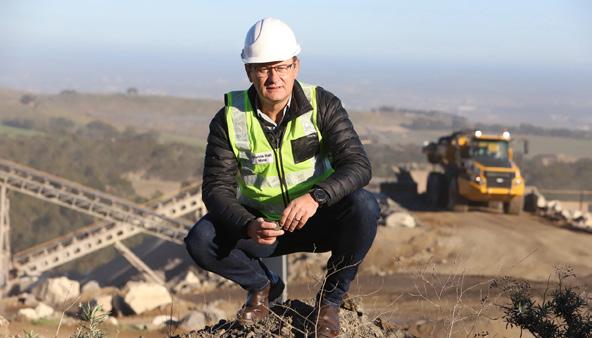
CEO, Afrimat Andries van Heerden,
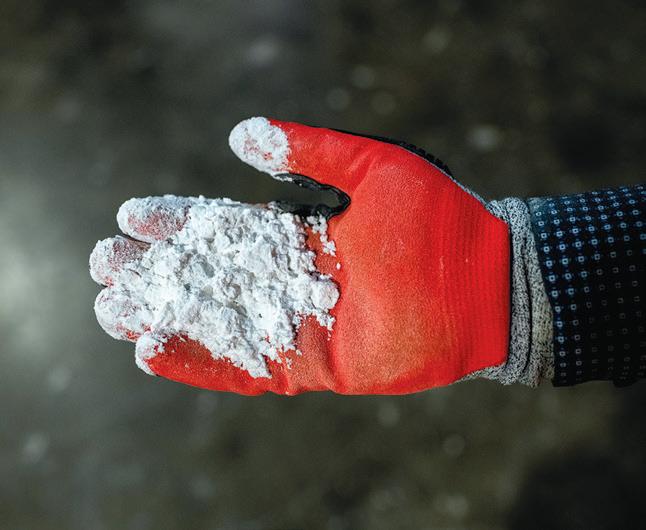
Critical metals on the march again
BY CHARLOTTE MATHEWS
FIRST came the hype, then the glut. The spot price for lithium fell 75% last year; cobalt, graphite, and nickel prices slid by between 30% to 45%. After several years of welcoming enthusiastic buyers, producers and developers of critical minerals – some of them new-
found – suffered drastic reverses in value. The market slump was particularly inconvenient for the juniors seeking funding.
Luckily for them, no one expects prices to stay subdued for long.
Amid the carnage, Premium Nickel Resources raised C$27.5m. The firm’s COO,
Boris Kamstra, a veteran minerals developer, says private investors and long-term fund managers are proving loyal but admits some shareholders are fickle. Many fled last year, justifiably, as the nickel price was obliterated by the oversupply of low-grade metal from Indonesia.
But believers in critical metals say there’s no escaping the ubiquity of demand, and not only in the energy transition industry. The defence and aerospace industries also consume them, adding pressure on supply.
In its Global Critical Minerals Outlook 2024, the International Energy Agency (IEA) said investment in critical minerals mining rose 10% in 2023; exploration grew 15%.
The market in mergers and acquisitions activity was also vibrant, as you might expect when the market corrects and equity prices fall. Around 40% of all major mining company M&A last year was to secure copper, tin, nickel and lithium, according to auditing firm PwC in its recent ‘SA Mine 2023’ report. Copper and lithium alone accounted for 70% of copper and lithium deals.
CHINA FAR AHEAD
Governments are also getting in on the act, with broad implications. Policymakers want to increase the resilience and diversity of supply chains, which is pitching the West against the East, the former playing catch-up to the latter. China woke up to the importance of certain critical minerals a long time before the West, says Tim Gould, chief economist at the International Energy Agency (IEA).
Today China leads global critical minerals extraction and processing: it is currently estimated to account for over 60% of worldwide production and 85% of processing capacity production. In 2023, it produced 58% of the 13.7 million passenger electric vehicles and plug-in hybrid vehicles sold globally, according to Adamas Intelligence.
China’s spending on the acquisition of overseas mines reached a record $10bn in the first half of 2023, with a particular focus on lithium, cobalt and nickel. A meaningful part of that spending was in Africa, where sub-Saharan Africa is estimated to hold about 30% of proven critical minerals reserves, says the IEA.
China’s acquisitions of lithium resources in Africa in the last few years “have the potential to position Southern Africa as a key player in China’s dominance of the global battery metal supply chain”, says Paul Miller, director of Johannesburg-based mining consultancy AmaranthCX. It has an appetite for jurisdictions that are shunned by the West, such as Zimbabwe. Arcadia Lithium, Bikita Minerals and Sabi Star Lithium Mine are all Chinese-owned (see box). China also has a foothold in the Democratic Republic of the Congo (DRC) and Namibia.
“Even if they get some bets wrong, China has a portfolio rather than an individual project approach. Private investors in Africa were behind the curve – and once the Chinese own these assets, the flow of information stops,” says Miller.
Asked whether Premium Nickel had attracted any interest from Chinese investors, Kamstra said: “We have interest from everywhere. We definitely seem to be on the radar of entities that are looking for a reliable source of nickel supply.”
Gulf investors are adding to the market pressure. Saudi Arabia and the United Arab Emirates (UAE) are making intensive efforts to acquire critical minerals to diversify away from oil. The UAE has already invested in
critical minerals in the DRC and copper mines in Zambia.
Governments in the US and EU are also eager to diversify away from dependency on China but they have tended to favour projects in their own backyard.
“The West is waking up to the fact that China is eating its lunch on the supply of battery metals from Africa and South America,” Kamstra says. “But if a project is not in North America it is difficult to attract Western interest in it.”
Sibanye-Stillwater, one of South Africa’s biggest gold and platinum group metal miners, has taken this to heart in its strategy to diversify into critical minerals. Its projects are in Europe (the Keliber lithium project in Finland) and North America (Rhyolite Ridge in Nevada). Both have government involvement: a 20% holding by the Finnish Minerals Group in Keliber and a $700 million conditional loan from the US Department of Energy in Rhyolite.
Sibanye-Stillwater CEO Neal Froneman says the group consciously chose projects that are strategically located within or close to chosen ecosystems in Europe and North America as it believes these projects will be considered of strategic importance. They are likely to attract a premium for the product
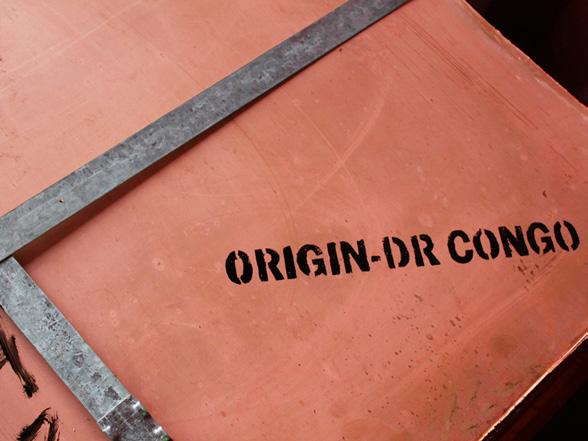
and are easy to finance.
Froneman said regulations driving usage of locally sourced critical metals (or from accepted trade partners) and subsidies and tariffs will level the playing field. “Ultimately, ESG [environmental, social, and governance] issues and the carbon footprint of the particular metal source will drive buyers, which is a particular competitive edge that we hold.”
China’s grip in Zimbabwe
ARCADIA LITHIUM
Acquired by Chinese company Zhejiang Huayou Cobalt in 2022 for $378m, and following a further $300m investment, this project boasts a mine and processing plant targeting an annual output of 450,000 tons of lithium concentrate.
BIKITA MINERALS
Previously focused on petalite for the glass industry, Bikita Minerals is undergoing a significant transformation with a new spodumene concentrate plant (300,000t/ycapacity), a new petalite concentrate plant, and a solar power plant, thanks to a major investment by Sinomine (Hong Kong) Rare Metals Resources Co. Limited.
SABI STAR LITHIUM MINE
Shenzhen-listed Chengxin Lithium Group acquired a majority stake in Sabi Star in 2021 and has invested heavily, commissioning a processing plant and aiming for an annual output of 300,000t of spodumene concentrate.
Three other 50,000t/year lithium concentrate producers have sprung up: a Chinese/Zimbabwean JV is revitalising the Kamativi tin mine; AIM-listed Premier African Minerals is advancing the Zulu pegmatite deposit in partnership Suzhou TA&A Ultra Clean Technology Co; and local Zimbabwean interests are pursuing a similar project at Sandawana Mines. – Paul Miller
Madagascar’s long-stalled Toliara Project forms centrepiece of merger
BY KRISTIE BATTEN
THE reframing of the undeveloped Toliara mineral sands project in Madagascar has driven a merger between Australia’s Base Resources and the US-based Energy Fuels.
Base Resources, which operates the Kwale mineral sands mine in Kenya, acquired Toliara in late 2017 in a deal worth around A$100m. While Toliara has been touted as world-class, Base Resources has been trying to agree fiscal terms with the Madagascan government for more than five years and on-the-ground work has been suspended since late 2019.
Madagascar held elections in late 2019, which saw President Andry Rajoelina re-elected. It paved the way for talks between Base Resources and the government on fiscal terms and the lifting of the suspension to resume.
Though field work has been suspended, Base Resources has continued to try to advance Toliara. In December 2023, the company released a prefeasibility study into the additional production of monazite.
Monazite, a rich source of rare earth elements, comprises just 2% of the heavy minerals in the Toliara resource, but the prefeasibility study (PFS) showed it had the potential to not just enhance, but transform, the economics of the project. Adding monazite to the production mix doubled Toliara’s post-tax real net present value to $2bn.
The monazite PFS generated an internal rate of return (IRR) of 78.6%, boosting Toliara’s overall IRR from 23.8% to 32.4%. The addition of monazite production, which previously was considered waste, will increase Toliara’s overall stage one capital costs by $71m to $591m.
Toliara is set to produce just over a million tonnes per annum of ilmenite, rutile and zircon and 21 800tpa of monazite over
its 38-year life. Operating costs, including royalties, per tonne produced are forecast at US$112 for a life-of-mine cash margin of US$365/t.
Life-of-mine free cashflow is forecast at US$10.65bn, including US$4.7bn from the monazite stream.
‘TRANSFORMATIONAL’ MERGER
While the monazite PFS was being carried out, Base Resources had started talks with US-based uranium company Energy Fuels. A scrip-based merger was announced in April. Energy Fuels will issue 0.026 of a share and pay A6.5c cash for every Base share held, valuing Base at A$375m. “We searched the world far and wide and landed on what we believe is the perfect opportunity,” Energy Fuels president and CEO Mark Chalmers said the day the merger was announced.
While Kwale is Base’s operating asset (but is due to close at the end of the year due to depletion), it was Toliara that was the main attraction for Energy Fuels. All of Energy Fuels’ projects are in the Americas so the pivot to Africa may have been a surprise for some. But the obvious reason behind the move is Toliara’s monazite
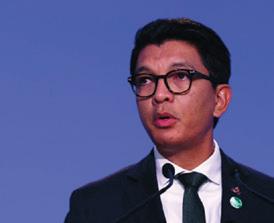
resource.
Energy Fuels’ White Mesa mill in Utah is the only operating conventional uranium and vanadium mill in the US and is the only mill in North America that can extract rare earths from monazite feed. In June, the company said it had achieved commercial production of separated neodymium-praseodymium at White Mesa and would ship its first product in the following weeks.
Assuming the Base transaction is completed, Toliara will account for about 50% of Energy Fuels’ monazite feed.
Canaccord Genuity analyst Katie Lachapelle said the deal made sense for Energy Fuels. “In our view, it solves a key problem that was facing the company – the ability to secure reliable monazite feedstock to ramp up rare earths production at White Mesa,” she said.
While the merger is centred on Toliara, the project remains stalled. However, Base Resources managing director Tim Carstens believes that will change. At the time of writing, the company was yet to reach agreement with the government. “It’s been a long process but there have been some pretty reasonable reasons for it and we’re in a good place now,” Carstens said, referring to COVID-19, the new mining code and the elections.
Carstens was hopeful the suspension would be lifted in June and the fiscal terms could be finalised by July. He said the terms had been agreed in principle and added that it would be based on the mining code with an uplifted community investment. “We’re very confident this is going to move forward … we believe it will be done this year. We’re very bullish this is all going to happen,” Chalmers said.
Base has previously said it would take roughly 11 months from the agreement of fiscal terms to final investment decision, meaning it would be made in June 2025 at the earliest. Toliara has a 27-month construction period (29 months for the monazite component) and the merger presentation assumed commissioning would occur in September 2027.
Energy Fuels says the company’s increased scale would deepen the pool of potential financing sources for the project. There is also the potential to secure low-cost US government funding.
Andry Rajoelina Madagascar President




Transforming the mining industry through innovation



As Vodacom marks its 30th birthday, it’s a fitting time to reflect on its role in driving digital transformation in the mining sector. Over the past few years, Vodacom Business has been at the forefront of providing innovative solutions that connect the mining industry to a better future.
“Technology offers possibilities to revolutionise mining in the 21st century and beyond. At Vodacom Business, our digital solutions ensure that each mining operation can meet specific demands within an inherently high-risk environment, from optimising productivity and asset management to improving safety,” says Thando Sibindi, Managing Executive of Mining Resources and Manufacturing at Vodacom Business
Connectivity: the lifeline of modern mining
Connectivity is the cornerstone of digital transformation. In mining, this is no different but requires overcoming challenges, such as remote locations, and ensuring that the network is stable to avoid, what can be dangerous, disruptions. To meet these needs, Vodacom Business is deploying private mobile networks (MPNs), which provide an ultra-reliable, secure network for mission-critical applications and enable mining organisations to connect people, devices and equipment via technology, including 4G, 5G and the Internet of Things (IoT).
“With high-speed, reliable connectivity in place, we can help mines create a digital ecosystem to enhance operations across the business. We understand that not every mine is the same and, therefore our solutions are tailored to each client, evolving with the rapid pace of technology,” says Eulene Nadar, Executive Head of Mining, Oil and Gas at Vodacom Business.
Leveraging IoT technology
This includes IoT, which is transforming the way mining companies operate, automating workflows and providing a wealth of data that assists with asset management, real-time visibility, and strategic decision-making. With IoT, for example, mines can monitor equipment, perform predictive maintenance and identify potential issues, preventing costly repairs and downtime. IoT can also enable autonomous mining vehicles for the transportation of materials, selecting more fuel-efficient routes to reduce emissions while tracking output from its source to its destination.
“We support businesses in collecting, transmitting and storing all this information from IoT, securely. Data can be used by key decision makers to effectively manage mining operations, including mitigating environmental impact, implementing sustainable practices and achieving compliance,” explains Sibindi
Enhancing safety on site
One of the key priorities for mining is safety. Addressing this, Vodacom Business launched wearable technology to boost zero harm for workers. The easyto-wear device can be attached to a mineworker’s personal protective equipment (PPE), with features including a device-battery status and GPS location, hazardous-gas sensors, fall and no-motion detection and a panic button. In the event of an abnormal reading or alert, supervisors are notified immediately, enabling prompt action, which could save a life. “Real-time insights on each worker’s location in the mine not only serve as a safety measure but can assist with more effective resource scheduling for better productivity. Operators can also access incident reports, including daily gas detection, to provide an overview of the site’s health and safety environment,” adds Nadar.
Unlocking further opportunities through connectivity
As mining companies continue to embrace the value of digital solutions, technology can be used to achieve other goals in the business, such as fostering employee engagement. In an initiative with Standard Bank, and Kamoto Copper Company (KCC) in the Democratic Republic of Congo, Vodacom Business developed the Umoja Employee Engagement Application, powered by WyzeTalk. The platform connects employees, regardless of their location, to important information, human resources, skills and career development, among other opportunities and provides a platform for feedback and communication at all levels of the organisation. “Importantly, by accelerating connectivity in hard-to-reach mining communities, we can empower more people through technology, increasing access to the benefits of essential online services, such as financial services, education and health, driving digital inclusion and changing lives. This supports Vodacom’s purpose-led journey of connecting everyone to a better future,” says Sibindi.
Looking ahead: the future of mining with Vodacom Business
As Vodacom celebrates three decades of innovation, the future holds even greater promise. The continuous evolution of technology, particularly 5G, artificial intelligence, and advanced IoT, will further positively impact the mining sector. Vodacom Business is poised to lead this transformation, ensuring that mining companies can harness these technologies to enhance efficiency, safety, and sustainability. Here’s to the next 30 years of innovation!
All systems go for Arc’s Zambia copper JV with Anglo
BY ED STODDARD
Base metals exploration development company Arc Minerals says its copper JV with Anglo American in Zambia remains firmly on track.
Anglo in May rebuffed an all-share takeover bid from BHP which was focused on its copper assets – and Anglo’s new strategy, unveiled in the heat of that battle, is also drilling down on the red metal.
“It is all about copper, and that is frankly for Anglo and all other majors the No. 1 priority, at least the ones exposed to base metals,” Nick von Schirnding, director and executive chairmperson of Arc Minerals, told Miningmx in an interview in June.
“I think it’s the most exciting prospective copper tenement in the world, certainly in Africa.”
Von Schirnding said the $90m project in the Dome region of the Zambian Copperbelt was fully funded and that drilling was set to resume in June. About $75m of that is “going into the ground” to support exploration.
“We started drilling late last year but the rains caught up with us. We drilled one deep stratigraphic hole down to 950m and that showed all kinds of interesting things including not only copper but also nickel mineralisation,” Von Schirnding said.
“That will help to better inform us about the upcoming drilling campaign. That will be very significant and probably last until late November/early December, depending on when the rains kick in.”
Arc’s tenements span 870km2 and are near First Quantum Minerals’ Sentinel and Kansanshi copper mines and Barrick’s Lumwana mine.
Industrial-scale copper mining started in Zambia almost a century ago, but there is still a lot of unexplored ground there. Exploration activities and capital investment
were stymied after the Zambian government nationalised the industry – including Anglo’s assets at the time – in 1969.
The subsequent re-privatisation set the industry on a roller-coaster ride through successive Zambian governments, some of which were far less investor-friendly than others.
But Hakainde Hichilema, who won the 2021 presidential election, has worked hard to woo investors and create an environment more conducive to mining, which remains the lifeblood of the land-locked Southern African country’s economy.
“If you look at what the new administration in Zambia has done to turn this ship around, it’s been very impressive. I have met several senior people in the president’s office who have been tasked with implementing the changes that he wants
to implement and that includes getting rid of the bad apples and sorting out historic corruption,” Von Schirnding said.
He pointedly noted that this was “easier said than done, as we see with President Cyril Ramaphosa in South Africa who had dealt with similar issues”.
Von Schirnding also said the Dome region in Zambia had reasonably good infrastructure, given its proximity to existing mines.
“There is no shortage of water and there is power up there that we can access. The road network is mixed but we have graded roads over the period that we have been up there, and the government has said that they are going to put more infrastructure in that north-west part of Zambia, and that all can be done,” he said.
“And if you look at what First Quantum

Nick von Schirnding Executive chairperson, Arc Minerals



has done with their investments around their mines, tarred roads and things like that, that is what mining investment can do to uplift what is a historically poor region of Zambia.”
One open question is funding for the project when it moves beyond the exploration and development stage.
Concerns have been raised about the state of Anglo’s balance sheet and its ability to bring its copper assets – which are mostly in Latin America – to fruition. That is one of the reasons why at least some of Anglo’s shareholders were willing to entertain talks with BHP.
But Anglo plans to sell off its steel-making coal assets in Australia and diamond giant De Beers, and is slowing capital outlay on its fertiliser project in the UK. And it is directing its capital flow to copper. Some of that will conceivably trickle to a country where it was mining copper decades ago.
Von Schirnding won’t be drawn on Anglo’s recent restructuring plans, un-
veiled in May, in which the group intends to sell its 85% stake in De Beers, unbundle a 79.2% stake in Anglo American Platinum and sell its metallurgical coal assets in Australia.
But he was once high up in Anglo’s pecking order as head of investor relations and corporate affairs. That was in 1999 when the group listed its shares in London, a controversial development at the time because it signalled Anglo’s intention to unmoor itself from its South African base. He ended a 20year association with Anglo in 2010 before embarking on a varied journey through the Asian, African and South American mining industries. He took his seat at Arc in 2017.
Von Schirnding remains bullish about the company’s prospects. “The excitement starts now,” he said in an October conference call to investors. The deal with Anglo was nothing short of the best exploration earn-in ever drafted, he added. Since then, investors seemed to have cooled on its prospects. At the time of writing, shares in the company had halved.
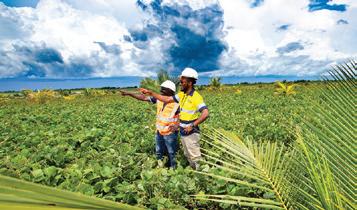
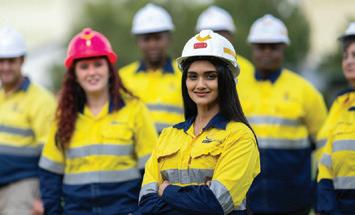
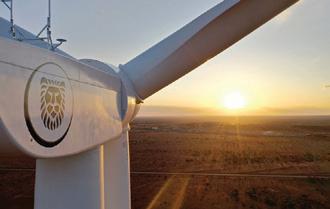
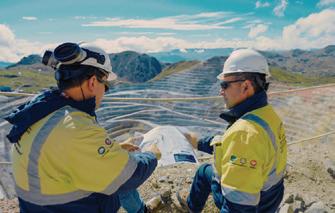
Zambia’s President Hakainde Hichilema
Northern Cape copper is rising again
It’s getting really interesting in South Africa’s Northern Cape where developments on junior copper projects over the past year are backing up claims that the region could once again become a major copper-producing district, writes BRENDAN RYAN
JUST how big could copper production in South Africa’s Northern Cape become? Pretty substantial, according to two local developers of the mineral who believe the province could even recapture its glory days of the 1970s.
“We believe that in the long term we can get our set of properties at Okiep back to their historic production levels of around 30 000t/year of copper metal,” says Orion Minerals CEO Errol Smart. “In total the Okiep area produced up to 60 000t/ year of copper and I believe between Jan (Nelson) and ourselves we can do that all over again ... and possibly more.”
Nelson, who is CEO of Orion’s rival in the Northern Cape, Copper 360, says his company has “a clear plan” to produce 50 000 tons – production that will be funded “mostly” from cash flow.
“But, and I don’t want to get ahead of myself, there are other projects we are looking at which show us we could eventually get to 100 000t,” he says of future annual production.
Looking even further ahead at the long-term
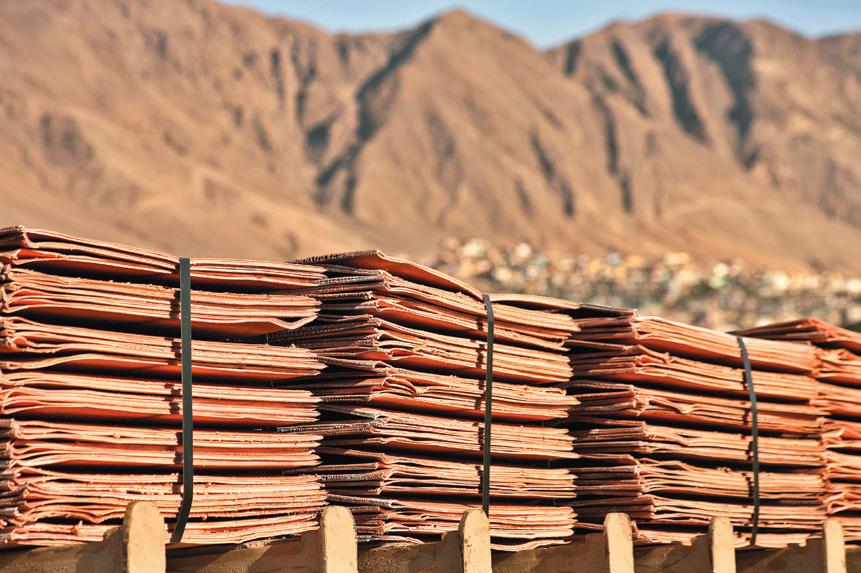
BRENDAN RYAN
future of the Northern Cape, Nelson says there are still big pieces of the copper-bearing region around the areas controlled by Copper 360 and Orion extending up into Namibia. Bringing in new participants would depend on South Africa presenting itself as an attractive destination in which to do business – something it had failed badly to do so far.
Smart reckons that just might be happening following the outcome of the latest elections, which he described as an unexpected black swan event. Orion has been “inundated” with queries since the formation of the gnu (Government of National Unity) with people who previously were “not prepared to write cheques” now apparently prepared to take another look at investments in South Africa.
Copper 360 is the most advanced of the two companies, with a couple of producing plants in operation near Nababeep as of June, and a third due to kick in from August.
Orion Minerals is at least 18 months behind with its projects around Nababeep as well as starting the production of copper concentrate at its Prieska project as it still has to build the concentrator plants. While mining shallow surface ore block and mine pillars at Prieska is under way, dewatering the mine could take three years at least before Orion accesses the deep-level ore zones.
“Prieska is fully permitted, mining is under way and we are stockpiling ore on surface. The first three years of ore production at Prieska runs at an average grade of 2.4% while the average at Okiep is going to be 1.4%,” says Smart.
In April, Smart disclosed a series of drill results from its Flat Mine project at Okiep which included a “standout intercept” of 49m at 4.89% copper from 231m down hole including 10.23m at 12.47% copper. He described that as “one of the highest-grade intercepts reported in South Africa for the last 40 years”. “For me as a geologist this underscores the huge potential of Orion’s 641 km2 of mineral right holdings which contain literally hundreds of mapped, outcropping mineralised bodies.”
A scoping study for Okiep was “looking at” production of around 9 000t/year, but further details were dependent on completion of the bankable feasibility study and its
validation by independent experts, Smart says.
MINNOWS WITH GIANT PROMISE
Copper 360’s creation is thanks mainly to the pioneering efforts of Northern Cape mining entrepreneur Shirley Hayes, who was born in Springbok, which with a population last measured at 12 000 is described as the capital of Namaqualand. Hayes has been exploring the region since 2008 when she acquired the exploration right for the former Concordia mine.
Hayes then teamed up with Nelson, formerly CEO of Pan African Resources. He was separately building an SX/EW plant to produce copper cathode from dump material at the former Okiep mine. The two eventually put together Copper 360 which listed on the JSE in April last year.
The past year has been traumatic for the duo as Copper 360 battled with a string of issues, including load shedding, which lowered plant performance and problems with recovery and crushing, causing a threemonth shutdown and mill failure.
Now, however, Nelson is confident the worst is behind the company. He has forecast production of between 6 500t and 10 000t of copper for the current year to end-February compared with just 313.5t in the previous year. “As of August we will have three production plants and three mining sites in operation which gives us great flexibility and security,” he says.
And – in the first indication of what could lie ahead in future major expansions in the region – DRDGOLD is assessing the possibility of setting up a copper recovery
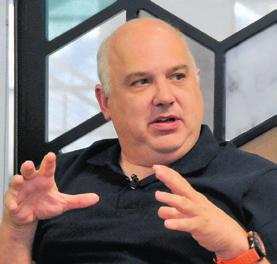
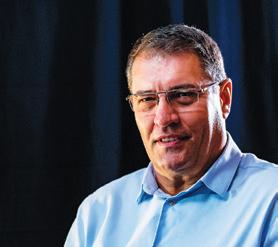
‘We believe that in the long term we can get our set of properties at Okiep back to their historic production levels of around 30 000t/ year of copper metal’ – Errol Smart, CEO, Orion Minerals
operation to treat the 60mt of dump material that Copper 360 controls.
All of this is taking place at a critical period in the copper market where Nelson sums up Copper 360’s situation as being that “our timing could not be more perfect to deliver copper production in a rising copper demand and price environment”.
For the past 10 years the “prophet” of the coming copper boom has been billionaire mining entrepreneur Robert Friedland, whose Ivanhoe Mines group has developed the huge Kamoa-Kakula copper complex in the Democratic Republic of the Congo.
Friedland’s message has consistently been that the world needs more copper than ever to implement the renewable energy transition while the traditional major sources of that copper – the huge mines in South America – face falling output because of their age and dropping ore grades.
That is now being borne out with a string of production cuts announced by Anglo American from its South American operations and dramatically underscored by this year’s – so far – unsuccessful bid by BHP to
Jan Nelson Copper 360 CEO
take over Anglo American. The driving motivation for that offer was that BHP wants to get hold of Anglo’s copper mines to merge with its own.
According to Sprott market strategist Paul Wong, a new copper supercycle is emerging. He cites rising geopolitical and market trends as factors. “The global push towards clean electrical energy, coupled with protectionist moves by countries looking to secure vital materials, is driving an unprecedented surge in copper demand,” says Wong.
“At the same time copper supply is constrained following years of underdevelopment, expanding protectionist policy measures and a continued preference among copper producers to grow by mergers and acquisitions rather than greenfield development.” he says.
While Orion and Copper 360 have followed different strategies in starting up their projects, both have the same outlook on the endgame – they are not deliberately targeting being bought out by a larger mining group.
That is frequently the default strategy for many juniors: take the project up the value curve to the point where they get a mining major interested and then sell out at a healthy profit.
“We have done the hard yards and we are going to run it because we think we can make good money out of it,” says Nelson. “We are not trying to ramp it up the value curve and make it pretty, otherwise we would have pursued a different avenue. Then it’s a different game: you don’t allocate the capital; you build a small thing to show potential; then you drill out resources.”
But he also doesn’t intend spending the rest of his life at Copper 360. “Neither I nor Shirley are looking to run it for the next 20 years. If somebody walks into the office
‘It’s been hard. It has taken its toll on me. It’s a hell of a difficult thing to do and I am not going to do it again’ – Jan Nelson, CEO, Copper 360
tomorrow and says here’s a cheque for five times the value of the company then we will consider it. But I don’t want to run Copper 360 until I am 70. There are other things I want to do.”
Says Smart: “My team is focused on building this business. We are going to build this thing until somebody comes and offers a cheque that my shareholders accept ... against my recommendation. That’s what happens. We are a public company and it’s not me that decides. It’s when somebody offers the right-size cheque and the shareholders accept.”
The two entrepreneurs have chosen different development strategies with Nelson starting small and building up while Smart has come in looking from the outset to create a much larger operation with longer lead times.
Smart is looking at first production from both Prieska and Okiep in about 18 months – the beginning of 2026. “We cannot afford to burn bridges,” says Smart on the trajectory of his plans.
“We do not want to be in a position where we miss a production target. I think Jan’s route is the easier route and I wish I was there, but – five years from now – we will probably be pleased we took the route we have. As you go for greater expansion you want access to the big financial institutions and you have to build your credibility there.
“We have to be more certain of our outcomes before we spend the money. Our financiers want a plus/minus 10% estimation on everything.”
FUNDING DILEMMAS
Nelson’s strategy was to start small and get into production quickly. That was his approach to get around the biggest problem facing junior operators which is finding the money to pay for their projects. “By the time we have spent the latest R130m on expansion we will have spent R850m in total. There’s no way anybody is going to give a junior R850m upfront.
“With hindsight, we should have gone initially for the copper concentrate plant instead of the copper cathode plant but when we started there was no deal with Shirley meaning there was no access to copper concentrates.
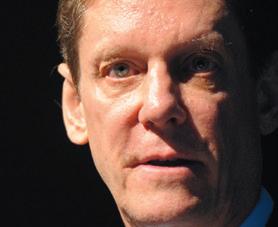
“It’s been hard. It has taken its toll on me. It’s a hell of a difficult thing to do and I am not going to do it again.”
It seems that the “small versus large” debate lay behind the surprise decision last year by Clover Alloys not to follow their options in Orion and kick in R870m that Orion badly needed.
“Their view was: ‘Don’t grow it big. Just build a small mine and make money and pay dividends.’ They – like many South African investors – want an early dividend-paying business.
“Our other shareholders – the people who funded us when we started – all said they were in it to reach optimum production scale. They want the business to grow. That is my mandate.”
Turning to the thorny issue of financing, Smart says his approach has been to whittle down the initial high levels of capital expenditure needed for Prieska and Okiep to more “manageable” levels.
The scoping cost of Okiep is around R1.4bn while the original cost estimate to develop Prieska was around R5.5bn with the main problem being the requirement to dewater the workings which will take some three years.
Revenue from the new, shallow mining operations bringing in early copper production will cut the peak funding requirement to about R3.5bn. “We have tied up $80m funding with Triple Flag so that’s R1.4bn of the R3.5bn already. We have the IDC as a partner at Prieska. They put in R250m as a convertible note and will be 19% shareholders, and also fund the BEE which is 20% of the project. So now 38% of the R2bn shortfall is spoken for by the IDC.”
Robert Friedland, Executive chairperson Ivanhoe Mines
WHAT THE FUTURE NEEDS MOST IS A HEART OF GOLD.
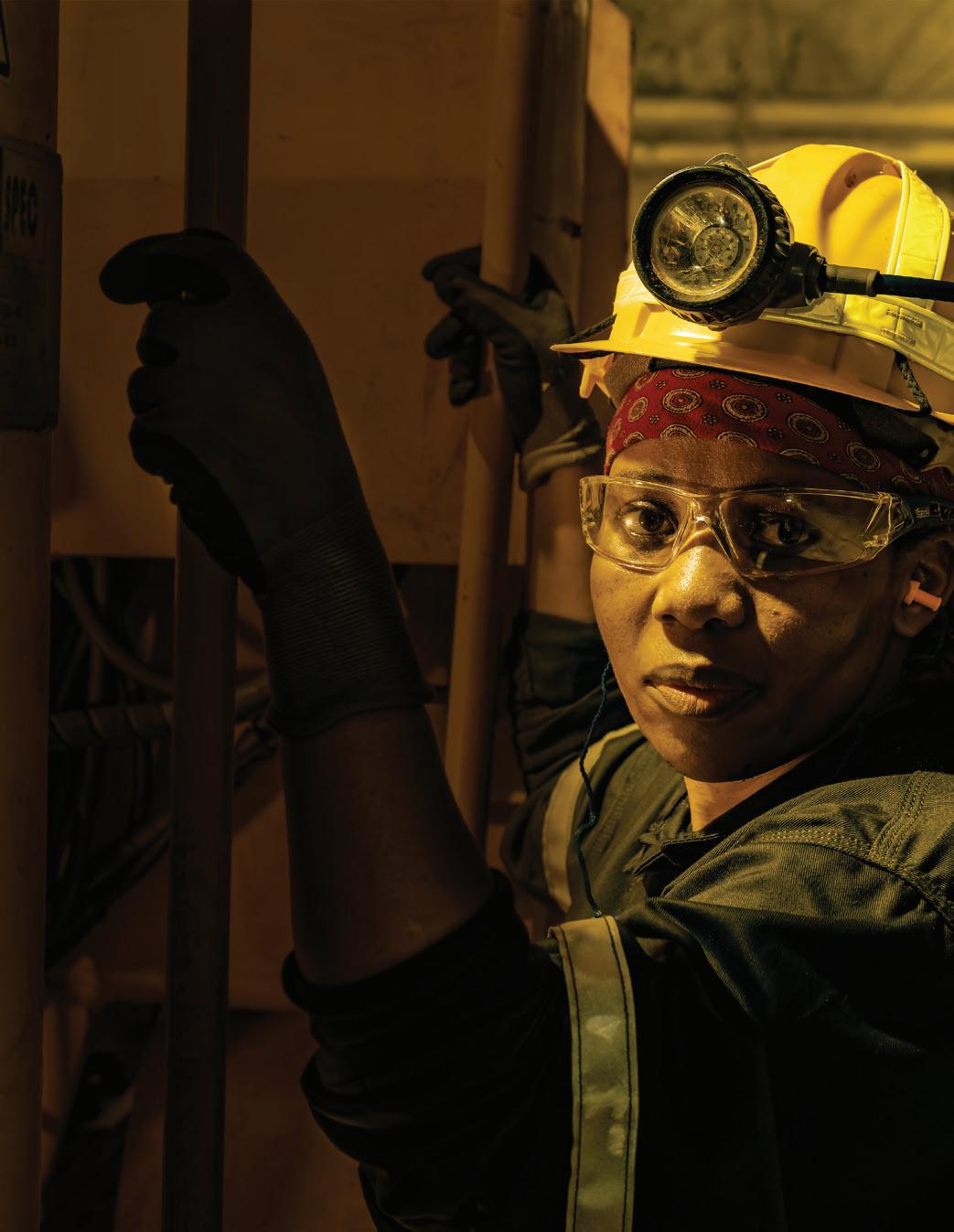
OUR WORK GOES BEYOND JUST MINING GOLD AND GROWING OUR INVESTMENT IN COPPER.
We mine with the future in mind and with the safety of each other a top priority. Whilst the wealth we create depends on what we bring to the surface, our responsibility goes much deeper. We recognise that it is our duty to care for our people and our planet therefore, sustainability is embedded in all we do.
This is the promise we have made to our people, our communities and the countries in which we operate. We put our hearts into keeping this promise. This is Mining with Purpose. harmony.co.za
Have PGM miners done enough to revive prices?
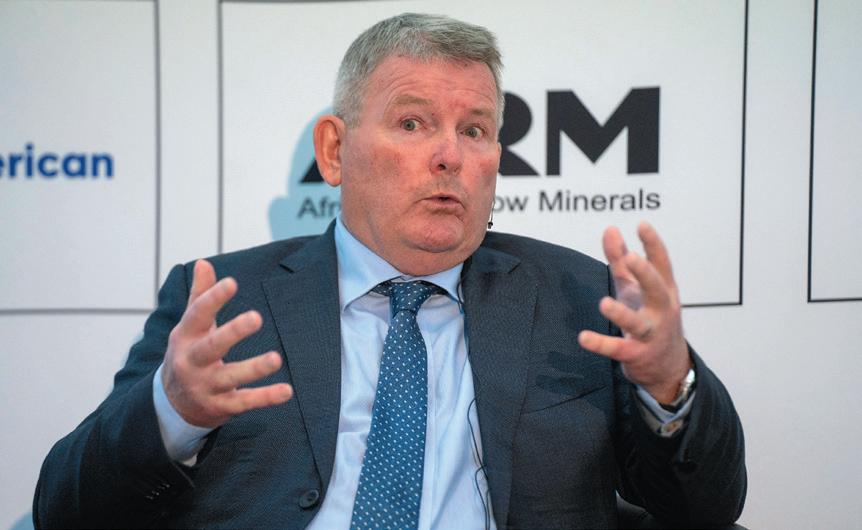
There have been some production cuts in platinum group metals, but not enough to help revive metal prices, which also need stronger market signals on automotive demand, writes
WHEN Northam Platinum launched its bid for Royal Bafokeng Platinum (RBPlat) in November 2021, it looked like a smart strategy. Northam was confident of long-term prospects in the platinum group metal (PGM) market, expecting that the adoption of battery electric vehicles, which require no PGMs in autocatalysts, would be slower than forecast. PGM supply was in decline.
Then, in June last year, Northam walked away from its offer, agreeing to sell its
34.5% stake to rival bidder Impala Platinum (Implats) for R13.1bn. Not coincidentally, metal prices were in freefall. In these changed conditions holding cash trumped expansion.
“This time two years ago, palladium was trading at around $2,300, and rhodium
$18,000,” says Metals Focus, an independent precious metals consultancy.
“Fast-forward to today’s respective $1,000 and $4,500 and it is easy to appreciate how the sharp fall in the PGM basket price is one of the greatest factors shaping the min-
Paul Dunne, CEO, Northam Platinum
ing industry.”
It calculates that about half of the metal’s South African miners are lossmaking and reliant on by-product sales like iridium and chrome.
Miners have lowered overhead costs, but a severe reduction in metal supply is still likely.
One casualty is Tharisa’s $391m Karo Platinum Project on the Great Dyke in Zimbabwe, where construction has been slowed. The project is expected to produce 190,000 ounces a year of PGMs when it finally opens but after spending $110.5m so far, Tharisa CEO Phoevos Pouroulis has opted for caution. His decision to align the project with the market was “a measured one”, he said.
Northam deferred workstreams at Zondereinde, and temporarily halted decline developments at its Booysendal and Eland mines. Anglo American Platinum (Amplats) and Implats are in restructuring talks putting a total of 7,600 jobs at risk.
“We are focused on safe production at the lowest possible cost, and project execution at the best price,” Dunne says. “We are focusing on maintaining a strong balance sheet. These are very inward-looking strategies, quite defensive, as we are preparing for a longer, harder market. If we are wrong, we will be happy.”
BRAKES ON EVS
As the world tries to move away from fossil fuels, governments have imposed taxes on carbon emissions and offered incentives to
switch to renewable energy sources, driving a revolution in the automotive industry and electricity utilities.
In the past 20 years, PGM consumption in autocatalysts of internal combustion engine (ICE) vehicles has increased in line with waves of stringent emissions standards. Now, large parts of the world are moving to battery electric vehicles (BEVs) which operate without autocatalysts. Several European countries have even set dates (from 2025 to 2035) by which ICE vehicles may no longer be sold. (Others have rowed back on their targets.)
“Decarbonisation of road transport is at the heart of price pressure,” Amplats CEO Craig Miller told the recent London Indaba. “Road transport accounts for 10-15% of emissions, so decarbonisation of the sector is something we all need to work on,” he said. There is evidence, however, that EV sales are slowing.
BEVs accounted for 2% of automotive production in 2019 and currently account for 12%. “We now expect to see different technologies come forward to cater for different types of vehicle demand,” says Miller. Meanwhile, a shift to the political right in Europe could slow the decline in ICE sales. “I have no doubt that the ban on ICEs by 2035 will be moderated, I don’t know how and when, because it is unrealistic,” says Miller.
Yet even with these factors easing the rate of growth in EV sales, ICE vehicles remain in structural decline. Therefore, automakers have no incentive to hold significant PGM
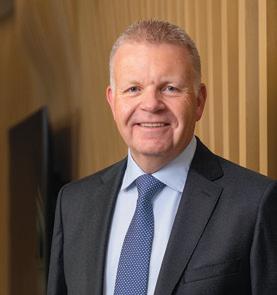
inventories, says Metals Focus.
What’s likely to emerge is a less binary picture – one of EVs replacing ICE vehicles – to be replaced by an outcome in which PGM automotive demand trends down gently and EV sales are partly displaced by hybrid EVs. These are vehicles that use some PGMs in their batteries but less metals than in ICE vehicles.
So the best outcome miners can expect is softer ICE decline or moderating EV growth, or even both. But for an ideal world miners would like to see a more rapid advance in commercially viable fuel cell electric vehicle (FCEV) technology.
‘We are focusing on maintaining a strong balance sheet. These are very inward-looking strategies, quite defensive, as we are preparing for a longer, harder market. If we are wrong, we will be happy’ – Paul Dunne
FCEV technology uses platinum in a fuel cell to generate energy from hydrogen. Amplats, which has been trialling FCEV in its heavy haul trucks, is a believer. It partnered the rollout of hydrogen FCEV taxi fleets at this year’s Olympic Games in Paris. “We believe FCEVs will prevail for those who want anxiety-free travel,” says Miller. “The next stage is to generate greater public understanding and excitement about FCEVs.”
Wilma Swarts, director of PGMs at Metals Focus, says her company is optimistic about the hydrogen economy, especially hydrogen production through water electrolysis and its consumption in storage, transport, mobility and stationary supply.
Metals Focus forecasts an increase in demand for PGMs in hydrogen applications to about 100,000 oz this year from 60,000 oz in 2023. By the end of this decade, PGMs in hydrogen applications will rise sixfold, she says.
Craig Miller CEO, Amplats
HOW WILL PGM PRICES PERFORM?
The speed and shape of the green energy transition and its effect on PGM prices is difficult to predict, even in the short term. But the expectation is for subdued pricing while market forces influencing ICE, EV and FCEV vehicles take effect.
Dunne, who has prepared Northam for difficult trading conditions until after 2025, says high interest rates are also deterring hard commodity purchases. Metal stocks will fall and not necessarily be replenished.
High interest rates will also deter car purchases. Current US economic data points to a more gradual easing in rates later this year.
Structural changes in China, which represents 30% of global vehicle purchases, also exert downward pressure on the PGM market. BEVs adoption is high at about a quarter of the vehicle market. China has also engineered a reduction of PGMs in ICE vehicles which has released small, but nonetheless influential, volumes of rhodium back into the market.
As Dunne explained, management of metal inventories by buyers can be a reliable guide to market direction. Metals Focus says they are key. It cites the example of platinum last year where a supply deficit of 867,000 oz was still not enough to convince the buyers to build stocks given some 10.2 million oz in above-ground stocks or some 15 months of demand cover.
The same is true of palladium, where above-ground stocks are equivalent to 14 months of demand. For rhodium, aboveground stocks are expected to fall to 660,000 oz by end-2024, equivalent to seven months of demand cover, which Metals Focus expects will support the price.
Swarts said there was a strong possibility that platinum prices would end 2024 higher than at present, due to the ongoing displacement of palladium in gasoline cars. Palladium prices are expected to tick up slightly, but “it has essentially flatlined”, she says, as the combined effects of electrification and substitution are likely to exert downward pressure on palladium prices.
The rhodium price is expected to remain fairly steady in the short term, due to lower above-ground stocks.
Metals Focus forecasts an average plati-
num price of $960/oz in 2024, down 1% on 2023’s $965/oz based on inventories. It sees palladium 23% weaker at an average of $1, 030/oz (vs $1,337) and rhodium averaging about $4,750/oz (2023: $6,611), down 28% for similar reasons of stockpiles.
Naturally mining companies contemplating expansion will take a longer-term view on prices. After all, it takes a decade or more to build a mine from scratch.
Swarts says production cutbacks, inventory depletion or a new source of demand could spark a turnaround in pricing, especially if lower production coincided with new demand.
“We do think however that while platinum will benefit from hydrogen demand, palladium and

rhodium will continue to struggle unless there is a new demand source for palladium especially,” she says. “This is because both palladium and rhodium are exceptionally exposed to autocatalyst demand, which makes up around 80% and 90% of total demand for each metal respectively.”
Nedbank Securities analyst Arnold van Graan says deficits or surpluses tend to have less impact on metal prices over two years than, say, the global vehicle market, short-term production disruptions, and multi-year production cuts. He thinks the average PGM basket price will improve over the next couple of years, assuming ICE sales continue to grow.
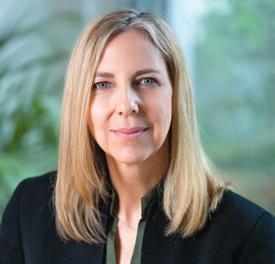
Reductions in primary supply, especially South Africa, were insufficient to shape prices. “We believe the current basket price is still at unsustainable levels, which could lead to further growth capex cutbacks and restructuring and mine closures, as was the case from 2010 to 2016 – when the basket price was at similar levels for an extended period,” Van Graan says.
Says Dunne: “The good news is that the industry will correct. At these prices, we will see less supply in the market.”
Miners were delivering negative margins. “The implication for each company depends on each one’s view on how long the cycle will last and when the reversal will come. We hold the view that turnaround will take one to two years.
“I don’t see too much downside from here. Price discovery is very good for the biggest metals. These factors are all factored into the price and I believe we are at, or very close to, the bottom. Certainly, neither miners, refiners, nor recyclers can make a risk return at this price level. It is not a sustainable market and it will resolve itself – the question is how and when.
“These are very special metals,” says Dunne. “Their characteristics and role in many reactions makes them irreplaceable and we will continue to mine them. We see great opportunities in PGMs.”
Wilma Swarts Director of PGMs, Metals Focus
Anglo to persist with hydrogen experiment
BY CHARLOTTE MATHEWS
THE splitting up of Anglo American following BHP’s rejected proposal will trigger a rethink of various shared projects and services across the group. One of those is the hydrogen truck, a project in the Anglo group’s FutureSmart innovation hub.
At the outset, Anglo American was motivated to back the development of hydrogen fuel cell vehicles to stimulate demand for
platinum group metals (PGMs), which serve as catalysts in the fuel cell. Anglo’s 79.2% stake in Anglo American Platinum (Amplats), the world’s biggest platinum miner, stands to benefit if hydrogen fuel cell technology is proven to be commercial. (In an eye-catching marketing move, Anglo has launched hydrogen-fuelled taxis to support this year’s Olympic Games in Paris.)
Now, however, Anglo plans to focus on
copper, iron ore, and (eventually) crop nutrients. Its metallurgical coal, nickel and manganese assets will be sold as well as
Global take-up of hydrogen fuel cell vehicles is still several years away
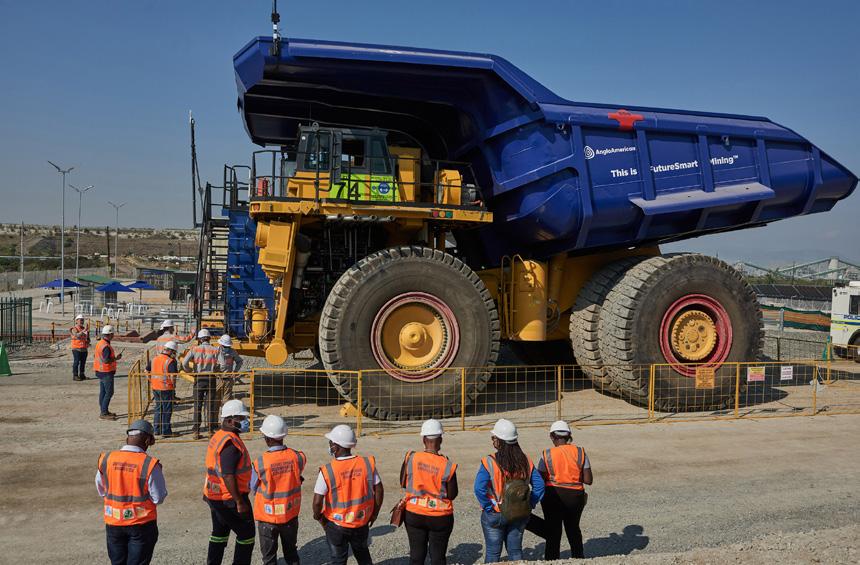
Anglo’s hydrogen truck
Like most major miners hoping to attract and retain the world’s biggest pension fund investors, Anglo American has carbon emissions goals: it wants to be carbon-neutral by 2040
but also because the country possesses the advantage of ample solar energy to manufacture “green” hydrogen. Hydrogen fuel cells can be used in both mobile (electric vehicles, in place of a battery) and stationary applications (power generation).
The hydrogen vehicle, which Anglo American calls the Zero Emission Haulage Solution (ZEHS), is a 220t truck with a 290t load capacity, converted from diesel to run on a combination of hydrogen fuel and a battery. When the truck goes downhill, through regenerative braking, it charges the battery.
However, the commercial viability of hydrogen fuel cell vehicles is not a given, as the capital costs of hydrogen technology are not coming down as fast as originally expected.
its 85% stake in De Beers. Amplats will be unbundled.
Still, even without an interest in Amplats, Anglo could maintain a stake in the development of hydrogen fuel cell vehicles, at least in the short term. It has already made a large capital commitment to their development, which could earn a decent return if the technology is successful. Also, these vehicles can help mining companies to reduce their carbon emissions. Like most major miners hoping to attract and retain the world’s biggest pension fund investors, Anglo American has carbon emissions goals: it wants to be carbon-neutral by 2040. Replacing diesel with green hydrogen in its global mining fleet would make a significant difference, if these vehicles prove to be efficient and affordable.
Amplats CEO Craig Miller comments that the hydrogen truck, having proved the technology worked, has moved on to its next stage of development in the US, where it will be further tested. He laughs off suggestions that the truck is a white elephant. Commenting on the prototype, he says: “It went into the pit on several occasions, and it came out.”
The platinum industry faces a potential demand cliff as increasingly popular battery-powered electric vehicles do not use platinum and palladium in autocatalysts. If hydrogen-fuelled trucks can become the gold standard for mining fleets, it will benefit not only Anglo American Platinum and other PGM miners in South Africa, but also the domestic economy as a whole.
The South African government has thrown its weight behind green hydrogen production partly to support PGM mining
The ZEHS has been tested for over 1 200 hours at Amplats’s Mogalakwena mine, which tackled the issue of fuel supply by building an on-site hydrogen production, storage and fuelling station.
In December 2022, Anglo committed $200m to further development by its specialist engineering technology partner, First Mode. This was followed by an agreement to decarbonise Anglo’s global mining fleet over the next 15 years.
“The progressive rollout of our lowcarbon footprint haul fleet is subject to the successful completion of agreed-upon and committed studies across selected mine sites, specific performance and cost criteria, and approval of the relevant regulatory, corporate, and shareholder requirements,” says Nevashnee Naicker, Anglo’s spokesperson. “The supply agreement also includes the appropriate provision of critical supporting infrastructure, such as refuelling and recharging, and the facilitation of hydrogen production.”
‘The progressive rollout of our low-carbon footprint haul fleet is subject to the successful completion of agreed-upon and committed studies across selected mine sites’ – Anglo spokesperson Nevashnee Naicker
On 19 May, the Financial Times’ Lex in depth reported that a lot of the hype around green hydrogen had not materialised. Only a fraction of the projects announced were being developed, and costs had escalated. An electrolysis plant costs about $2 000 per kW of capacity, about 65% more than developers originally expected to pay in 2024, and the costs of all the associated infrastructure (pipes, cables, water purification) have also increased.
“Hydrogen trucking also looks more challenging, given improving battery technology and the difficulty in providing hydrogen refuelling infrastructure,” the column said. As batteries improve, electric trucks will increase their payloads and ranges, it added.
Whether Anglo American retains its interest in using the ZEHS or not, the purpose of the partnership with First Mode was to house the project in a separate vehicle that was able to attract outside capital. So if it is a commercial proposition, it will stand on its own feet.
René Hochreiter, consulting mining analyst at Noah Capital, said he was confident that the ZEHS would go ahead. It was currently in the US undergoing further testing of certain components and once it was ready the developers were likely to get a bigger vehicle manufacturer to produce it on a larger scale.
The issue of hydrogen fuel supply to other mines could be tackled by sourcing from Sasol, which is already part of an agreement with Anglo Platinum and BMW SA to trial a hydrogen-fuelled BMW iX5 in Gauteng, he said.
However, Hochreiter said global take-up of hydrogen fuel cell vehicles was still several years away. Firstly, hydrogen fuelling infrastructure is very limited, even in Europe, although China and Japan are at a more advanced stage. Secondly, the swing towards right-wing governments in the West is likely to see a renewed focus on preserving jobs in the production of the internal combusion engine rather than developing fuel cell or battery. Both are expensive to make and unlikely to survive without subsidies.

INNOVATION DRIVES US, PEOPLE GUIDE US
In the forefront of mining, where stateof-the-art technology and pioneering innovations define our work, we remain dedicated to one unwavering principle: putting people first.
Out of the spotlight Trans Hex stages a surprising comeback
When Trans Hex skulked off the JSE at the end of 2019, few punters gave the beleaguered diamond mining group a snowball’s chance of surviving … let alone ever thriving again, writes MARC HASENFUSS.
MARC HASENFUSS
AT the time of its delisting Trans Hex was staring starkly at a handful of serious challenges.
The traditional Orange River alluvial concessions were all but mined out, while the Namaqualand mining operations acquired from De Beers for R225m looked, smelt and felt like an expensive dud. The balance sheet was no longer brimming with cash, and it was difficult to get cash out of the company’s one promising lifeline – the Angolan diamond operations. What’s more, long-held plans to build a marine diamond beach-head – initially thwarted in the late Nineties when Trans Hex failed in its bid for Ocean Diamond Mining Holdings (ODM) – had lost momentum.
By the time of the delisting Trans Hex carried a market value of a little over R50m – which made the buyout offer, at double that price, a little quizzical to industry observers. Perhaps even more startling was that the prime movers behind the buyout offer were astute and experienced investors – in the form of retail tycoon and serial risk taker Christo Wiese and Astoria Investments (then in the guise of RECM and Calibre), which is headed by top fund managers Piet Viljoen and Jan van Niekerk. Wiese, ironically, had played a key role in Trans Hex losing out on the ODM prize and settling for a poor consolation prize in inferior marine gem business Benguela Concessions. Not long after the 2019 delisting there were still ominous signs that salvaging value of Trans Hex would be difficult.
In a 2020 annual report, Viljoen was disarmingly frank in admitting that Trans Hex had been a “consistently noticeable drag” to the investment company’s results. “With the benefit of hindsight, we should have passed on this opportunity when it was first presented to us.”
Viljoen probably thinks a little differently about Trans Hex now. The first clues that Trans Hex might have managed a most unexpected turnaround appeared in April 2022 when a restructured and recompiled Astoria disclosed a R3.5m dividend from the diamond miner.
Performance was driven by a solid showing from the Somiluana diamond
operations in Angola – which was then able to repatriate profits. It seems getting Trans Hex out of the public eye allowed management to grasp the nettle with vigour. In Astoria’s financial report Van Niekerk said that being unlisted enabled the Trans Hex management team to move fast and effectively in restructuring the business. He remarked: “Little did we know that positive operating results would occur so soon. We have a committed management team, an appropriate operating model and a like-minded partner. With this foundation in place, we are looking for ways to expand the business.”
KNUCKLING DOWN
It seems one of the big swings in Trans Hex’s progress as a private company was the appointment of Marco Wentzel as CEO. Wentzel might be remembered as a towering and intimidating Springbok lock. He is also Wiese’s son-in-law.
At the time Van Niekerk stressed that as a private company Trans Hex management had the freedom to transform the business. “There are no circulars, no drawn-out shareholder voting processes, no opportunistic shareholders holding the company to ransom because of arbitrary differences of opinion about valuation, and so forth. Just management rolling up their collective sleeves and getting on with the job, supported by shareholders who understand exactly what is happening and are there-

Marco Wentzel, CEO, Trans Hex

fore prepared to take the risk of providing capital to management at a fair price to help them achieve their aims.”
In mid-2022 Trans Hex took its next big step when it acquired International Mining and Dredging Holdings – renamed Trans Hex Marine Group (THMG). Astoria has a significant minority position directly in this business.
THMG is actively involved in marine and offshore mining and exploration and operated several mining vessels off the diamond-strewn West Coast of South Africa and Namibia. It looks a most interesting prospect. At the end of 2021 THMG boasted net assets of only R158m but recorded profits of R108m.
Astoria argued that marine diamond mining has a more predictable production profile than land-based alluvial diamond mining and the vessels (which in essence are floating mines) can follow the resources, allowing it a much larger scope of mining area.
Although – as an unlisted company –there is no proper sight of Trans Hex’s financials, there are interesting glimpses to be had through Astoria’s financial reporting.
For the year to end December 2023, Astoria reported that Trans Hex experienced the sharp decline in diamond prices across all grades and sizes. The group also bemoaned the “supposed rapid adoption” of lab-grown diamonds by younger generations of Western consumers more interested in costume jewellery than luxury as well as the flooding of the market by illicit Russian diamonds.
But Somiluana Mine’s production remained stable and profitable – although, this time, no funds were repatriated.
Astoria valued its investment in Trans Hex at a 32% discount to net asset value (NAV) to reflect the risks relating to repatriating capital from Angola. Van Niekerk said the Trans Hex NAV was reduced by 44% during the year because lower diamond prices render parts of the Somiluana Mine’s resources uneconomical and reduced the expected life of the mine.
Thus, the value of Astoria’s then 25% investment in Trans Hex dropped from R83.2m to just R46.4m. That still infers a value of R184m for Trans Hex – markedly ahead of the value on delisting almost five years ago.
RETURN TO PUBLIC LIFE?
There’s a distinct glimmer at sea, though. Like its investment in Trans Hex, Astoria values its stake in THMG at a 30.5% discount to its calculated NAV. But this last stated value was a whopping 40%-plus higher than the purchase price of the THMG – meaning the value of Astoria’s investment increased from $5.5m (around R99m) to $7.9m (R140m). This infers a value of around R560m on THMG.
What can also be garnered from Astoria’s financial report is that the Trans Hex land operations and the Trans Hex marine operations conducted a rights issue to raise an aggregate of $17.6m (around R320m).
Officially, the capital will fund maintenance and expansion capital expenditure – specifically increasing mining capacity, efficiency and the life of some vessels. Clearly Trans Hex was never going to be a bidder for De Beers or even De Beers Marine. But with the diamond market still in a down-cycle, there might also be smaller marine and land operations to pounce on.
Interestingly Astoria did not participate in the rights issue and consequently its share in Trans Hex land and marine has been diluted down to 14%. It would be easy to interpret this as a lack of enthusiasm for Trans
Hex’s long-term prospects. That would be wrong, however. Astoria is fully invested in its portfolio, and simply did not have the money to take up the Trans Hex rights.
At Astoria’s recent AGM Van Niekerk openly expressed disappointment at not being able to follow their rights. He intimated Trans Hex remained a stout contender. “We have seen weak diamond prices with a roughly 30% drop. But both Trans Hex’s Angolan and marine divisions are profitable. If you can still make money despite a 30% drop in the diamond price then you have good operators running this business.”
Van Niekerk added: “Trans Hex will be around – both in its land-based and marine diamonds – to make hay when the sun shines again.”
Viljoen raised the issue of possible corporate action when noting that under current conditions not all diamond miners were cash-flow-positive. “This creates opportunities for those miners that are cash-flow-positive and have a flush backer. We remain excited about the long-term market for diamonds.”
Viljoen reckoned the only way Trans Hex could grow was by acquisition. “We (Astoria) will cross that bridge when we get to it. But at the moment we don’t have the cash to support them.”
With Anglo American having to execute on a new portfolio structure, the fate of diamond giant De Beers might have some implications for Trans Hex. For instance, if Anglo opted to spin off De Beers into a separate listing on the London Stock Exchange and JSE would Trans Hex reconsider its unlisted status? A listed De Beers would

bring the diamond sector back into prominence on the JSE, perhaps allowing Trans Hex a valuable point of reference … not to mention possible capital raising opportunity.
Relisting a profitable Trans Hex – with a better operational spread across land and sea – might appeal to small cap punters that have not exactly been spoilt for choice for things that glitter in the JSE’s junior mining sector.
Alluvial diamond
Christo Wiese, Serial entrepreneur
Froneman’s greatest test lies ahead
BY DAVID MCKAY
NEAL Froneman’s career has been a series of risky acquisitions. Either he turns around lossmaking mines bought at a snip, or he buys assets at the bottom of the market cycle. Sometimes it’s both, such as the clever purchase of platinum mines that propelled his Sibanye-Stillwater to a market capitalisation of R169bn in 2022 from R10bn nine years earlier.
But his latest gambit – to provide “mobility metals” lithium and nickel to under-sup-
plied Western markets – is taking time to come together. It could be Froneman’s biggest test yet, partly because it involves doing two things not attempted before by his company.
Firstly, unlike previous embarkations, Sibanye-Stillwater is building greenfield production. Secondly, the projects are not in South Africa’s precious metals industry which Froneman knows well as a former manager at Harmony Gold, JCI, and Gold Fields. The Keliber lithium project is a
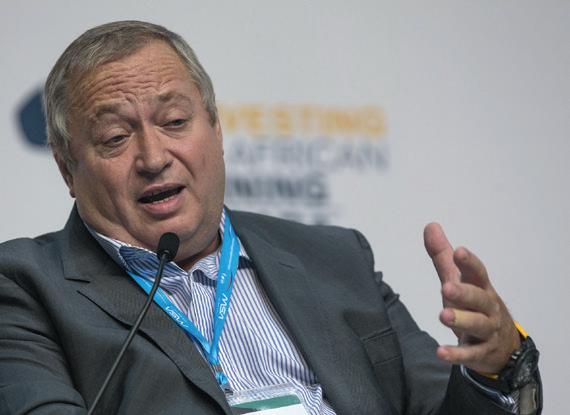
joint venture with Finland, while Rhyolite Ridge is in Nevada in the US, a state known in the mining industry for its vast gold resources.
On top of this, the two projects are expensive. Froneman has gone big in the debt and capital markets before – a rights issue for Stillwater Mining in 2017 was one of South Africa’s largest ever – but $1bn in preproduction costs for Keliber and Rhyolite Ridge, the latter not yet committed, is a big test for the South Africans. It comes just as cash flow from Sibanye-Stillwater’s platinum group metal (PGM) production dries up amid last year’s 40% decline in average metal prices.
In June, lenders agreed to relax their debt covenants which was a signal to the market that it should be fairly sanguine about Sibanye-Stillwater’s immediate debt relief prospects. Despite this Froneman desperately needs the PGM markets to recover. Nickel is also in deep trouble after the supply of low-grade exports from Indonesia knocked prices 30%.
Responding to a question at the London Indaba conference in June, Froneman told delegates the firm’s palladium-dominant US mine Stillwater could be placed on care and maintenance if the metal’s price continued to slumber. Previously he said the mine was too strategic to warrant mothballing. The fact that it’s now under consideration demonstrates the difficulty in the market for the group.
In just over six months, Sibanye-Stillwater has unveiled rounds of restructuring of its gold and PGM mines affecting more than 10,000 employees. The dividend, a key feature of Sibanye-Stillwater’s business case, was passed at year-end.
Expressing their frustration, nearly half of the firm’s shareholders voted down Froneman’s executive pay at the AGM in April. Sibanye-Stillwater’s market capitalisation was back to R60bn.
There’s been speculation that Froneman, who turns 65 this year, will soon retire. He stepped down from the Minerals Council South Africa where he’s long been an office holder in favour of Richard Stewart, 46, his number two in South Africa, COO, and most likely successor. But it would be a mistake to call time on Froneman right now.
Asked at the conference to dwell on
Neal Froneman, CEO, Sibanye-Stillwater
things he might have done differently in his career, Froneman couldn’t think of a single major mistake. While the market would agree empire-building is his weakness, Froneman thinks Sibanye-Stillwater has actually been too reticent especially when opportunity knocks. So put that in your pipe, he seems to say. Clearly, you don’t get to be Neal Froneman by worrying about past events.
Instead he believes the recovery in PGM prices is imminent, and lithium prices will start soaring just as Keliber begins primary mine production. (It will treat third-party supply while it starts up.) “From 10 years ago to now, given our share price, I think we’ve done fairly well,” Froneman told conference delegates. “When I look at where the world is today, we are exceptionally well positioned, but we do need to accelerate our impact.”
MAD WORLD
In South Africa, Froneman has long achieved commercial success on distress. He is a turnaround specialist of struggling mines usually by reducing overheads or having mines share services previously unavailable to them. As opportunities dry up in South Africa he’s hoping to capitalise on geopolitical chaos in the international mining market.
China’s dominance in critical minerals production has Western economies on the backfoot. In this struggle of “East versus West”, Sibanye-Stillwater wants to become a supplier to Europe and the US, and is prepared to take bold political positions in order to win favour. At the London Indaba he was openly critical of China, which leverages state-backed balance sheets in order to compete for assets. “I don’t know if there’s a word for ‘capital’ in Chinese,” he asked, facetiously.
“We have to help level the playing field as most of the companies we compete against are Chinese state-owned who talk about debt in terms of percentages,” says Froneman. “You can’t compete in the western capital market with companies that allow percentages of debt on balance sheet.”
Shareholders, however, have different priorities to Froneman’s politics of disruption. They are concerned the prolonged slump in PGM prices will damage the balance sheet
‘Many of the traditional supply-demand drivers are less impactful than conventional wisdom suggests, while financial market factors tend to have a material influence on the price’ – Arnold van Graan, Nedbank Securities
view. In terms of PGM equities in general, the bank has cut its 2024 earnings estimates. Target prices have been reduced 3% downwards as a result. Analysts worry that despite evidence of supply deficits in most of the metals, sentiment continues to weigh against the PGM market.
Arnold van Graan, an analyst for Nedbank Securities, says sentiment and trading activity tends to have a greater bearing on short-term price movements than normally supposed. “Many of the traditional supply-demand drivers are less impactful than conventional wisdom suggests, while financial market factors tend to have a material influence on the price,” he says.
further, and ask whether the company has done enough to restructure unprofitable production. “We expect Sibanye to announce further major restructuring/closures including Stillwater, Sandouville (a nickel refinery in France) and South African PGMs,” said Adrian Hammond, an analyst for Standard Bank Group Securities in a note in July.
Sibanye-Stillwater is RMB Morgan Stanley’s least preferred PGM stock. Market news on PGMs remained “mixed” in its
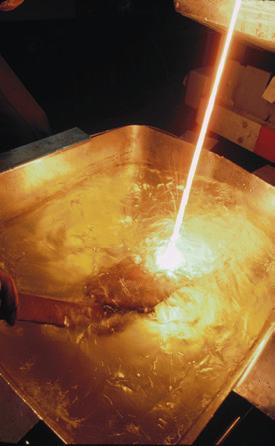
He does believe however that autocatalyst demand will continue to shape PGM market direction. The improved outlook for the internal combustion engine and the increased interest in hybrid electric vehicles, which use some PGMs compared to their electric vehicle models that don’t use any, is also supportive to the PGM market.
Based on this assumption, Froneman thinks prices for the likes of palladium, rhodium and platinum are due for imminent improvement.
“I think we have got to understand what is going to make up future mobility especially based on issues of global warming and carbon footprints,” Froneman told conference delegates of future demand for PGMs. “In the medium term PGMs have specific qualities. Fundamentals show that they are in deficit. It is not long now before we will see a pop in the price.”
There’s an enormous amount riding on how PGMs perform for the remainder of this year for Sibanye-Stillwater. The final instalment on its Keliber project falls due this year while a decision on whether it will take up its 50% stake in Rhyolite Ridge must also be made. Clearly, Sibanye-Stillwater has to press ahead but without damaging its balance sheet.
“There’s nothing fundamentally wrong with the market. It’s just a cyclical downturn including PGMs which is subject to destocking,” says James Wellsted, head of Sibanye investor relations. “But we are not going to stand still. We will respond to the PGM market by cutting high-cost shafts but we are comfortable in our long-term view,” he says.
SUSTAINABLY PRODUCING METALS FOR THE 21ST CENTURY
Underpinned by a track record of almost 40 years of PGM mining, Northam’s resilience in volatile and lacklustre economic conditions has prevailed. By mechanising, diversifying and lowering operational risk, we continue to improve our relative position on the industry cost curve. This protects our people, our operations and our markets.
“All of this because we believe in our product, our people, our company and our country.”
Paul Dunne, chief executive
